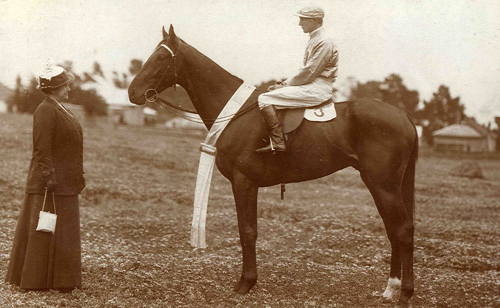The Melbourne Cup holds a profound significance, standing as a constant amidst tumultuous times like the World Wars and the Great Depression. From legendary horses like Archer and Phar Lap to iconic trainers like Etienne de Mestre and Bart Cummings, the race's history is steeped in remarkable tales. Despite its humble beginnings, the Melbourne Cup has evolved into Australia's foremost handicap race, renowned internationally for its prestige and widespread appeal.
Explore every winner of the Melbourne Cup from 1861 to current day.
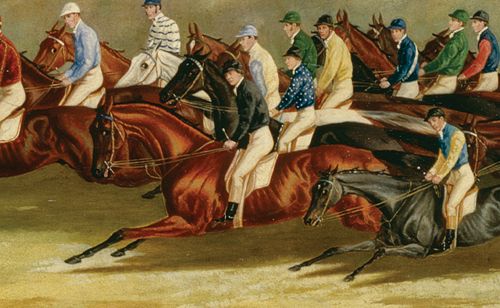
Trainer: Etienne de Mestre
Jockey: Johnny Cutts (Dillon)
Silks: Black 
It became part of later Melbourne Cup folklore that Archer walked from Nowra to Flemington. Not so: he travelled from NSW on board the SS City of Sydney which transported several Cup runners to Melbourne. He had been bred near Braidwood, was first trained near Nowra, and showed his early abilities at Randwick. Archer won the first Melbourne Cup in convincing style having been stabled behind the Botanical Hotel in South Yarra in the lead up to the race. Archer started 6/1 second favourite and won by six lengths. He was ridden by his regular Sydney jockey, John Cutts (real name Dillon). This first Melbourne Cup was run on Thursday 7 November in sombre circumstances. News of the tragic end to the Burke and Wills expedition had just reached Melbourne. The first Cup started back on the course proper, and congestion on the first turn resulted in a three-horse fall. This paved the way for the introduction of the long Flemington straight for the 1862 Cup, starting closer to Epsom Road, leaving a generous 800 metre run to the first turn.
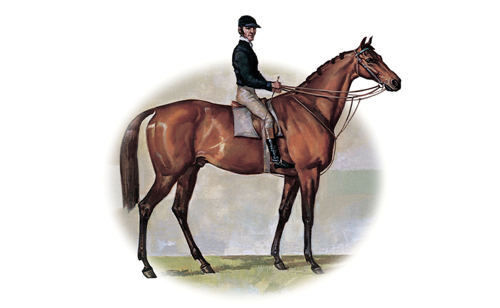
Trainer: Etienne de Mestre
Jockey: Johnny Cutts (Dillon)
Silks: Black

After winning the Cup in 1861, Archer returned from NSW the following year to win Australia’s latest racing attraction for a second time. Starting at 2/1 favourite, Archer won the race with ease by at least eight lengths, with John Cutts again the rider. For the second time he beat local hero, Mormon, ridden by Joe Morrison. With these consecutive Cup victories in highly competitive fields, Archer was hailed as the undisputed champion stayer in Australia. For this second win he carried the challenging impost of 10 stone 2 pounds (64.4 kg). Only two other horses have carried 10 stone or more to victory in the history of the Melbourne Cup—Carbine (10 stone 5 pounds, in 1890) and Poitrel (10 stone, in 1920). Tom Lamond, who later trained 1881 Melbourne Cup winner Zulu, was de Mestre’s right-hand man in charge of the day-to-day training of Archer.
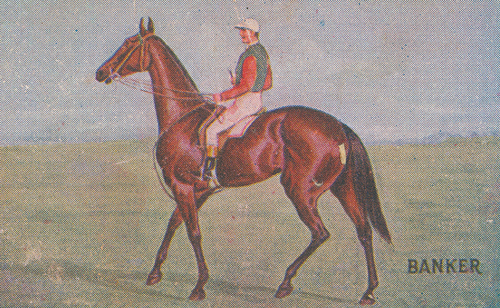
Trainer: Sam Waldock
Jockey: Harry Chifney (Henry Dawes)
Silks: Green, Red Sleeves, White Cap

Archer was entered for a third Melbourne Cup, and was allotted a huge handicap weight, but his acceptance reached the Victoria Turf Club office late, on a public holiday, and was controversially rejected. With only seven starters, the field for the 1863 Cup ended up as the smallest ever in the history of the race, and the winner carried the lightest winning weight on record (5 stone 4 pounds—just 33.5 kg). But this was a better class field than it appeared. Second in the race, Musidora went on to produce the filly Briseis (the 1876 Melbourne Cup winner) and she was great grandmother of Newhaven (1896 Melbourne Cup). Third placegetter, Rose of Denmark, became the dam of Australian champions Florence, Hamlet and Horatio. Harry ‘Chifney’ took his riding name from a famous English jockey of the day. His son, Horace Dawes, born in 1877, rode the 1894 Melbourne Cup winner, Patron. Banker’s English-born trainer, Sam Waldock, was a former jockey and a top horseman who became Master of the Melbourne Hunt Club.
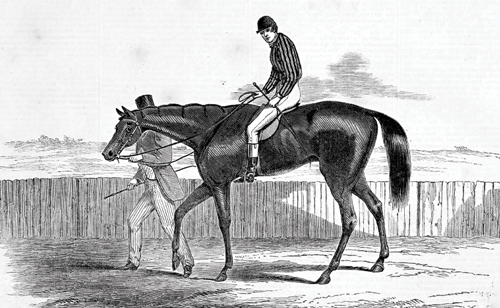
Trainer: William Filgate
Jockey: Sam Davis
Silks: Rose And Black Stripes, Black Cap

The ill-fated colt Lantern had a short but brilliant racing career, with four outstanding wins. Foaled in South Australia, bred and raced by Hurtle Fisher, he was trained in Melbourne by William Filgate at Maribyrnong Stud—not by Stephen Mahon as many later records claim. Lantern showed promise as a two-year-old, finishing second at his first start in the VRC Ascot Vale Stakes. The attempt to race him when still two against older horses in the VRC All Aged Stakes and in autumn in the inaugural Adelaide Cup, 1864, proved too ambitious, but at three he was unbeatable. He became the first horse to win the double of the Melbourne Cup and VRC Derby (in that sequence), adding the Publicans’ Purse at Flemington. Winning jockey Sam P. Davis was 16 at the time. Three weeks later, Lantern effortlessly took the Ballarat Derby. Hailed now as the rising champion, the next day he was fatally injured in the running of the Ballarat Cup. A half-sister, My Dream, won both the Victoria Derby and VRC Oaks in 1868.
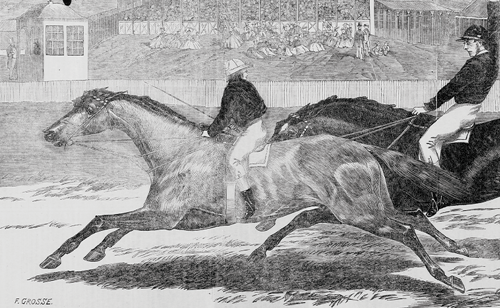
Trainer: Pat Miley
Jockey: John Kavanagh
Silks: Black, White Cap

In a roughly run race, the lightly weighted Toryboy, an eight-year-old grey gelding trained at South Melbourne by Irish-born Pat Miley, proved too strong for the well fancied imported Panic and landed substantial wagers for his owner. A handsome Cup trophy was presented, but the owner sold it as a ‘monstrosity’ and promptly left the colony, leaving unpaid debts behind him. The ornate silver cup was repurposed as a steeplechase trophy at Flemington and was then taken to England, where it remained for more than a century. In 1992 the South Australian vigneron, Wolf Blass, bought it at auction. Recent historical research suggests that the winning jockey was not ‘Eugene Kavanagh’ (as often listed) but rather the same John Kavanagh who won again in 1871, on The Pearl. If so, he was twelve when winning on Toryboy: not impossible, as small boys rode lightweights in that era. Peter ‘St Albans’ Bowden was even younger when he won the Cup on Briseis in 1876.
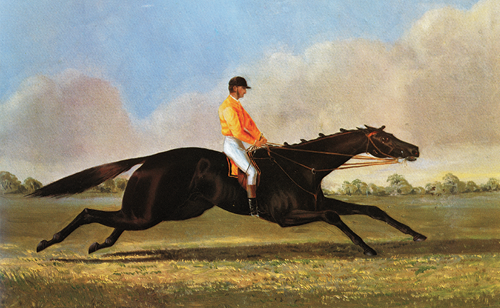
Trainer: John Tait
Jockey: William Davis
Silks: Canary, Black Cap

The Barb was known as ‘The Black Demon’ for his outstanding ability and—especially early in his career—for his temperamental behaviour. Bred in NSW by George Lee, he won the AJC Derby and the Mares Produce Stakes at Randwick before coming down to Melbourne to win the Cup as a 3YO. He provided ‘Honest’ John Tait with the first of four Cup victories as owner-trainer. No third placegetter was semaphored by the judge, but this was rectified by stewards who declared that Falcon had finished third, behind Exile. The Barb went on to win the Great Metropolitan Stakes, the Sydney Cup twice and the AJC Queen’s Plate. At stud he sired Sweetmeat, two times a Melbourne Cup placegetter. The Sydney jockey William Davis was just 15 when he won the Melbourne Cup on The Barb.
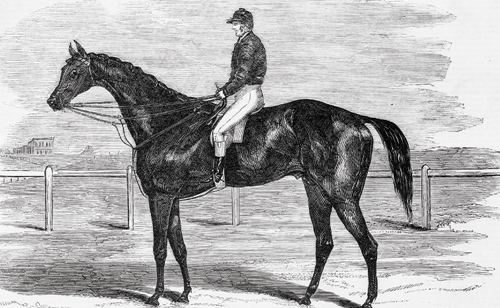
Trainer: Etienne de Mestre
Jockey: John Driscoll
Silks: Black

The 1867 Melbourne Cup is remembered as the year when ‘Sydney Tim’ took on and defeated ‘Melbourne Tim’. The unusual situation was presented when two horses named Tim Whiffler (after a character in a Charles Dickens novel) took to the post for the running of the Cup. Despite stating he would never return after the 1863 entries controversy with Archer, Etienne de Mestre brought ‘Sydney Tim’ (sired by New Warrior) to Flemington and secured his third of five wins in the race as trainer. ‘Sydney Tim’ won many races at Flemington and Randwick. Confusing matters further, an imported English stallion also called Tim Whiffler (by Van Galen) became sire of the Melbourne Cup winners Briseis (1876) and Darriwell (1879). Winning jockey John Driscoll was himself the son of a jockey, and he notably rode two winners at the Australian Jockey Club’s opening meeting at Randwick in 1860.
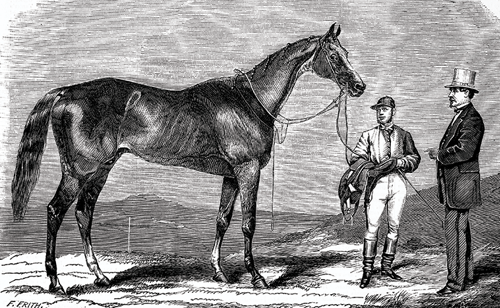
Trainer: John Tait
Jockey: Charles Stanley
Silks: Canary, Black Cap

Glencoe was the second of four horses trained by John Tait to win a Melbourne Cup. Between 1867 and 1870 the strong, unruly chestnut accumulated multiple principal races in Sydney and Melbourne. His breeder, Richard Dines of Singleton, raced him at two years before transferring him at three to Tait. The colt finished second in the AJC Derby. In spring 1868, Glencoe won five times in the space of four consecutive days at Flemington, beginning with the Melbourne Cup, concluding with the three-mile Queen’s Plate. Strop narrowly beat him in the 1869 Launceston Champion Race. Passing through several owners and trainers, Glencoe took the 1869 Melbourne Stakes and the 1870 VRC All Aged Stakes. Unplaced in the 1870 and 1871 Melbourne Cups, he ended his career with narrow defeats at Geelong and Adelaide. He stood one season at stud at Glenrowan in 1873. Sydney jockey Charles Stanley was 19 when he won the Cup.
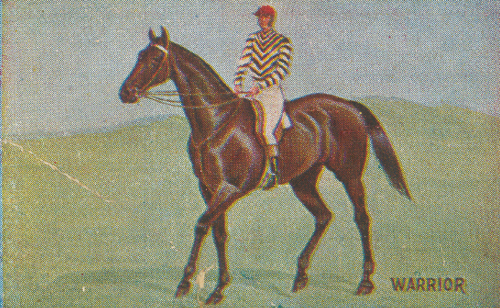
Trainer: Robert Standish Sevior
Jockey: Joe Morrison
Silks: Silver And Black Stripes, Scarlet Cap

This was the best horse that Flemington trainer Robert Sevior prepared in a career that extended to the 1890s: Sybil finished second for him in 1876. Scottish-born Joe Morrison was one of the top jockeys of his day, later a successful trainer. The owner, Austin Saqui, was a prominent Melbourne bookmaker who bought Warrior for £400 after the horse finished third in the 1869 two-mile Randwick ‘Great Metropolitan Handicap’: a month later the owner reputedly won more than £11,000 in wagers, plus prize money, when the horse won the Melbourne Cup. Saqui, an accomplished Liverpool-born boy pianist, had come to Australia aged 20 during the 1850s gold rush, but found bookmaking more lucrative than music or gold. He was one of several racing men injured in a train derailment near Cootamundra in 1887. Two years later he died from an accidental overdose of sleeping medication.
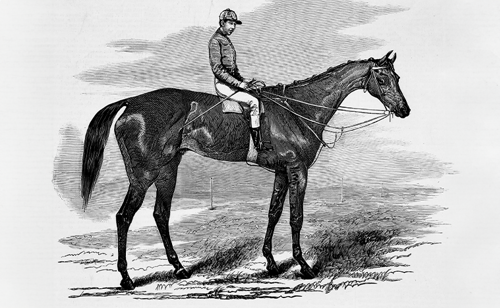
Trainer: William Lang
Jockey: John Day
Silks: Violet, Gold Cap

This Cup is remembered as ‘The Dream Cup’. The owner of Tasmanian-bred Nimblefoot, Ballarat publican Walter Craig, had dreamt soon before his death in September 1870 that his horse would win the Melbourne Cup, the jockey wearing his colours but with a black armband, symbol of mourning. Two months later the dream came true. Trainer Billy Lang, an accomplished, eternally argumentative horseman, was part of racing in Melbourne from its earliest days until his death in 1900. He was an early trainer of the 1875 Cup winner, Wollomai. Jockey Johnny Day, 16 when he won the Cup on Nimblefoot, had already found fame as a boy prodigy ‘pedestrian’ (walking race) champion, winning contests against adult competitors in both Australia and England. Contrary to recent speculation, Day did not ‘disappear’ after winning the Cup. He continued riding throughout the 1870s, dying from illness in rural Victoria in 1885.
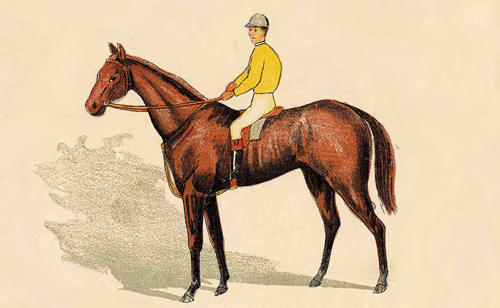
Trainer: John Tait
Jockey: John Kavanagh
Silks: Black, Canary Cap

Owner-trainer John Tait had two runners in the 1871 Cup, The Pearl and Pyrrhus. Tait preferred Pyrrhus on his good form in Sydney, so The Pearl drifted to be 100/1. A scrimmage eventuated halfway through the race causing Pyrrhus and the local favourite, Romula, to lose valuable ground. The Pearl escaped all the interference and saluted accordingly. Victorian-born jockey Kavanagh had moved to Sydney and joined the Tait stable in the late 1860s. The Pearl was the first 100/1 winner of the Melbourne Cup. He was later followed by Wotan (1936), Old Rowley (1940) and Prince of Penzance (2015). This was Tait’s third of four Melbourne Cup wins. Victorian-born jockey John Kavanagh rode in NSW for several years before returning to Victoria as a trainer. Despite contrary theories, Kavanagh was likely to have been the boy jockey who won the 1865 Cup on Toryboy.
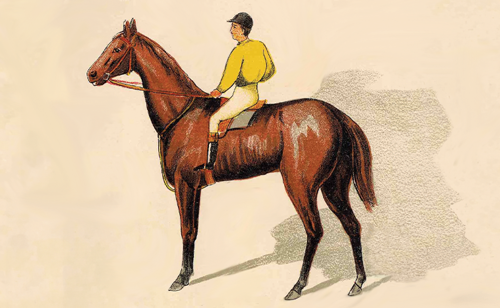
Trainer: John Tait
Jockey: William Enderson
Silks: Canary, Black Cap

The Quack was a younger half-brother to 1870 Melbourne Cup winner, Nimblefoot. Both had been bred in Tasmania by John Lord, who sold them as young horses. Well performed in Sydney, The Quack started at 10/1 in the 1872 Cup, and defeated The Ace, trained by rival Etienne de Mestre. This gave Tait his fourth winner in the Melbourne Cup, and it was The Quack’s best career victory. The locally trained Dagworth was favourite and finished third. On a warm day, the crowd, estimated at 40,000, was said to the largest seen to that time at Flemington: numbers on Melbourne Cup Day would approach 100,000 by the end of the 1870s. William Enderson, himself the son of a jockey, was 16 when he won the Cup.
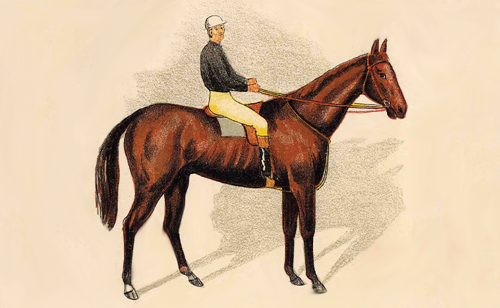
Trainer: James Wilson
Jockey: William Wilson
Silks: Black, White Cap

Don Juan, bred in South Australia but owned, raced and trained in Victoria, was an iron horse who won three races in three successive days in November 1873 at Flemington including the Melbourne Cup. He raced in the ownership of ‘Mr W. Johnstone’ (sometimes ‘Johnson’), who in reality was Joe Thomson, Melbourne’s most conspicuous bookmaker. Thomson won so handsomely on the race that he directed some winnings to charity and build himself a mansion townhouse in East Melbourne which he named Don Juan House. James Wilson also profited from the race and relocated from Hamilton to create the famous St Albans Stud at Geelong. Jockey William Wilson, 14 when he won the Cup, was the younger son of the trainer and—like his older brother, James junior, who had ridden in previous Melbourne Cups—grew into a successful Australian Rules footballer at Geelong Football Club. James junior trained the 1899 Cup winner, Merriwee.
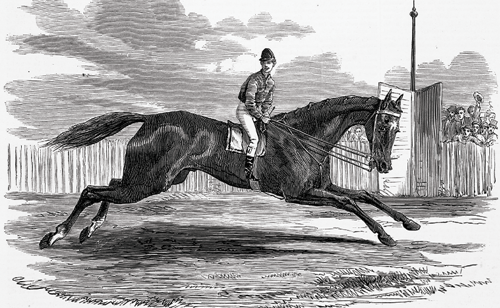
Trainer: Sam Harding
Jockey: Paddy Piggott
Silks: Royal Blue, Black Cap

Haricot was a plain looking foal bred by Western District pastoralist Andrew Chirnside, who with his brother Thomas established the famed Werribee Park mansion. The horse was sired by the imported stallion Ladykirk who also sired the Caulfield Cup and Newmarket Handicap winner, Tom Kirk, second to Calamia in the 1878 Melbourne Cup. Sam Harding was Chirnside’s trainer, based at Moonee Ponds, and he mentored jockey Pigott from the time when the lad reportedly rode horses as a mail courier for the Chirnsides. Pigott’s career flourished during the next decade: he travelled widely and he rode a second Melbourne Cup winner (Chester, for Etienne de Mestre) in 1877. His later career took him to Queensland. Andrew Chirnside also bred the 1900 Cup winner, Clean Sweep.
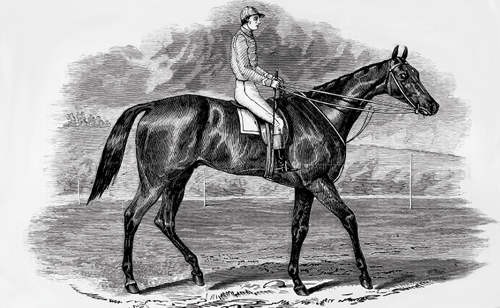
Trainer: Stephen Moon
Jockey: Robert Batty
Silks: Grey, Gold Sleeves, Grey Cap

For the first time, in 1875 the Melbourne Cup was run on a Tuesday. The spelling of the winning horse’s name causes confusion. It derives from Cape Woolamai on Phillip Island where the horse’s owner-breeder, John Cleeland, owned property and subsequently built his ‘Woolamai House’ homestead. Cleeland had made his fortune from the Albion Hotel in Bourke Street, Melbourne, near the horse saleyards, Kirk’s Bazaar, a centre for racing enthusiasts. Wollomai raced in the ownership of ‘Mr H. Sharpe’, Cleeland’s racing name. Only months before the race, Stephen Moon took over the training of Wollomai from Billy Lang (trainer of 1870 winner, Nimblefoot). Scottish-born jockey Bob Batty, 20 at the time he won the Cup, was at the peak of his career, having won the first VRC Newmarket Handicap in 1874. Batty later turned to riding in jumps races, winning the VRC Grand National Steeplechase at Flemington, in 1881 and again in 1891.
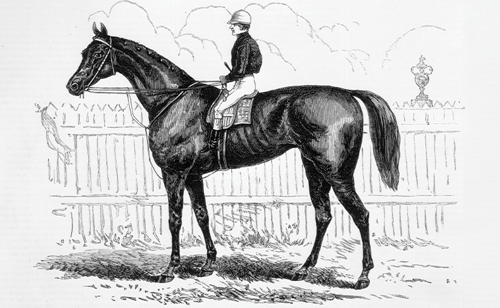
Trainer: James Wilson
Jockey: Peter St Albans (Bowden)
Silks: Black, White Cap

The three-year-old filly Briseis holds the unique record of winning the Victoria Derby, Melbourne Cup and Oaks, and all in the one week. This was the first year when the Melbourne Cup Carnival took its traditional form of Derby Day (Saturday), Cup Day (Tuesday), Oaks Day (Thursday) and a final Saturday. James Wilson bred, owned and trained the filly. She was sired by the imported English horse, Tim Whiffler, from the mare Musidora, second to Banker in the 1863 Cup. As a two-year-old, Briseis won the prestigious Doncaster Handicap in Sydney. For her Derby and Oaks wins at Flemington she was ridden by champion jockey Tom Hales, but he was too heavy to ride at the allotted weight of 6 stone 4 pounds (about 40 kg) in the Cup. The Cup ride went to the stableboy jockey, Peter Bowden, who always rode under the name of Peter St Albans. He is the youngest jockey ever to win the Cup. On the day he was just short of turning 12. Peter rode the runner-up in the following year’s Cup and again in 1880.
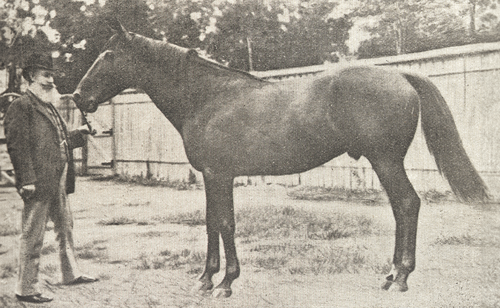
Trainer: Etienne de Mestre
Jockey: Paddy Piggott
Silks: Light Blue, White Sleeves, Quartered Cap

A son of the famous colonial sire Yattendon, Chester became a superstar of the Australian turf in the late 1870s, winning a dozen principal races and initiating an exceptional run of racing success for his wealthy Sydney owner, the Hon. James White. The breeder, Edward King Cox, had sold Chester as a yearling to White for a large sum. Etienne de Mestre trained the horse, his fourth winner of the Cup. Early wins by Chester had included the AJC Champagne Stakes, Breeders Plate and Sires Produce. His three-year-old wins included the 1877 Victoria Derby, followed by the Melbourne Cup in race record time. This was the second Cup win for local jockey, Paddy Pigott. Widely publicised, the horse’s owner collected a fortune on this race from flamboyant bookmaker Joe Thompson. As a sire, Chester had conspicuous success, his best son the champion Abercorn. Chester died at White’s Kirkham Stud in November 1891.
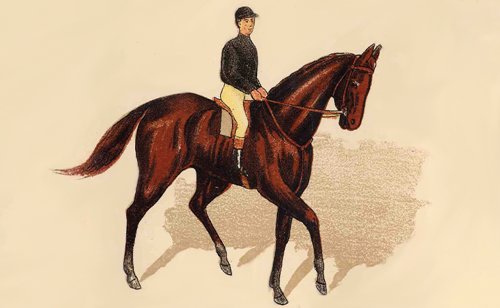
Trainer: Etienne de Mestre
Jockey: Thomas Brown
Silks: Black

Calamia had already won long-distance races in Sydney and Melbourne before he won the Melbourne Cup, first up after a six-month spell. Owned and trained by the Melbourne Cup maestro, Etienne De Mestre, Calamia landed him some substantial wagers. Calamia carried a good horse’s weight and gave de Mestre back-to-back victories and his fifth Cup success. Calamia was a son of Maribyrnong, an outstanding Australian sire, but was the only one of his offspring to win a Melbourne Cup. Two other sons were Cup placegetters (The Diver, 1874 and Richmond, 1875). Jockey Tom Brown, from Maitland NSW, turned to training soon after winning the 1878 Cup, and he prepared champion Grand Flaneur to win the race in 1880. He is unique in Cup history by winning the race as both a jockey and a trainer.
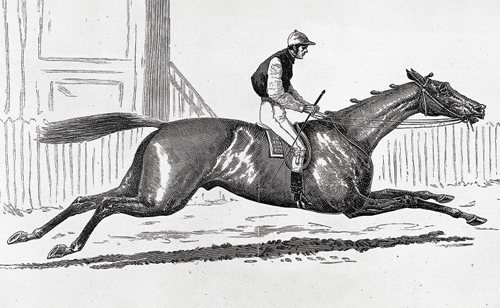
Trainer: William E. Dakin
Jockey: Sam Cracknell
Silks: Black, Canary Sleeves And Cap

Darriwell was sired by the imported British horse Tim Whiffler and was bred in Victoria by John Ord Inglis, who sold the colt as a yearling to Tasmanian businessman William Guesdon. Described at first as lightly framed, hollow backed and plain looking, Darriwell raced with little success in Hobart before being sent to be trained in Melbourne by W.E. Dakin, a former British cavalry officer. Despite several good wins by Darriwell at Flemington, Dakin preferred the stablemate Le Loup in the 1879 Cup, so Darriwell won at long odds of 33/1. Sammy Cracknell, a small red-headed man with a flowing beard, was one of the most astute and popular jockeys in his day.
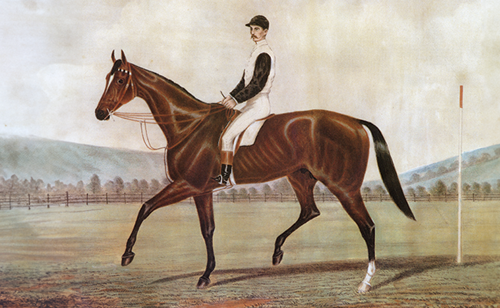
Trainer: Thomas Brown
Jockey: Tom Hales
Silks: White, Black Sleeves And Cap

Grand Flaneur, sired by Australian champion Yattendon, was bred and owned in NSW by William Long. He won nine successive top-class races before retiring unbeaten, a record no other Melbourne Cup winner has boasted. These victories included the 1880 AJC and the Victoria Derby and the Melbourne Cup. He had a brilliant career at stud, his progeny including Melbourne Cup winners Bravo (1889) and Patron (1894). Another son, Merman, was exported to England and won the Ascot Gold Cup and the Goodwood Cup. Trainer Tom Brown had recently retired as a jockey, having ridden Calamia to win the 1878 Melbourne Cup for Etienne de Mestre. Grand Flaneur provided jockey Tom Hales with his one and only Melbourne Cup win. Hales was the champion jockey of his era. He won the AJC Derby and the Victoria Derby six times and the VRC St Leger on ten occasions.
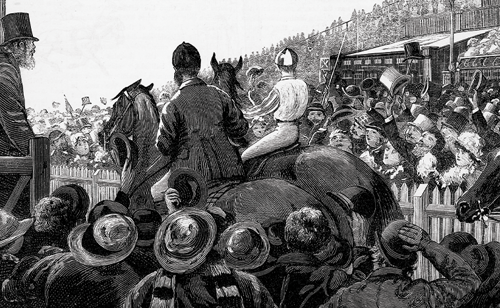
Trainer: Tom Lamond
Jockey: Jim Gough
Silks: White, Royal Blue Striped Sleeves, Quartered Cap

Zulu’s Melbourne Cup victory was unexpected: the horse was small, his form was moderate and he seemed lame before the start. His owner, grazier Charles McDonell of Mondrook, Taree, had sent his colt to the successful Sydney stable of Tom Lamond only a year earlier, after Zulu won a maiden race at home. Lamond had learned his craft working with Etienne de Mestre and had been responsible for Archer in the horse’s campaigns in Melbourne. With Lamond as mentor, Zulu won in modest company at Parramatta, Hawkesbury and Randwick, showing enough promise to take him to Melbourne. The 1881 Cup was marred by a fall when a dog ran onto the track. The lightweight jockey Jim Gough, 14 at the time, avoided the fall, and won at odds of 33/1. The better fancied stablemate, Wheatear, was one of three horses who fell. Jim Gough’s younger brother, Jack, won the Melbourne Cup on The Grafter in 1898.
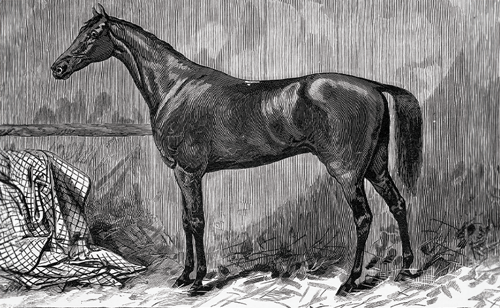
Trainer: John Eden Savill
Jockey: Charles Hutchins
Silks: Black, Gold Sash, Rose Sleeves, White Cap

The Assyrian, bred in South Australia, first raced in Adelaide with little success as Rothschild before being sold at auction. His new owner, John Eden Savill, changed the name and won the 1880 South Australian Derby. Savill was an accomplished English artist and horseman who briefly ran Adelaide’s famous Lockleys Stud. As the cartoonist ‘Cerberus’, Savill regularly published satirical drawings in an Adelaide magazine. At Lockleys he was respected as a mentor to his brother-in-law, C. Leslie Macdonald, and to Hugh Munro, both of whom were later associated with the success of St Albans Stud, Geelong. Savill returned to England soon after his Cup success. In 1883 The Assyrian won the Hobart Cup and then had a short stud career. A son, Bothwell, won the 1888 Toorak Handicap. Charles Hutchins was a South Australian jockey who later rode in Mauritius and Western Australia.
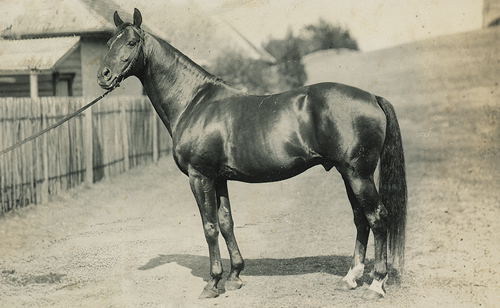
Trainer: Michael Fennelly
Jockey: John (Jack) Williamson
Silks: Royal Blue, White Sleeves, Quartered Cap

Martini-Henry was the first New Zealand-bred horse to win the Melbourne Cup, victorious in 1883 in record time. Three days earlier he had won the Victoria Derby—at his first race start. He followed later that week with the VRC Mares Produce Stakes and, in autumn 1884, the VRC St Leger. These were his sole wins. Bred by the Auckland Stud Company, Martini-Henry (named after a rifle) was sired by Musket from Sylvia, the 1867 VRC Oaks winner. He was bought as a yearling for a record 1250 guineas by New South Wales pastoralist, the Hon. James White who had won the Melbourne Cup with Chester (1877) and was trained in Sydney by Michael Fennelly at White’s Newmarket Stables, Randwick. Retired to Kirkham Stud, Martini-Henry was sold after White’s death in 1890. Best of his progeny included Jacinth, dam of the champion racehorse Poseidon. Martini-Henry died in Queensland in 1903 just outside Longreach. The Cup was the biggest career win for jockey Jack Williamson, who later rode in India.
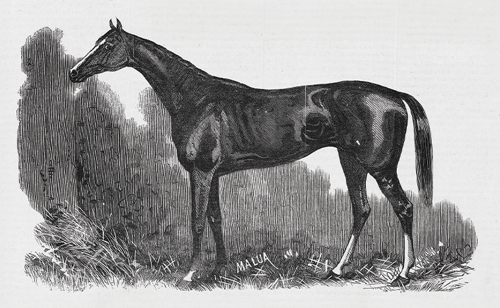
Trainer: Isaac Foulsham
Jockey: Aleck Robertson
Silks: Royal Blue, Crimson Sash

Malua is arguably Australia’s most versatile thoroughbred ever. He was bred in Tasmania by John Field, who also bred Sheet Anchor (Melbourne Cup 1885). At two years, originally named Bagot, he won at his first start. Under a new name and ownership, on the mainland he won the 1884 Oakleigh Plate at Caulfield and the VRC Newmarket Handicap (Australia’s premier sprints). He possessed the endurance to then win the two-mile Adelaide Cup followed by the Spring Stakes at Randwick. His Melbourne Cup win of 1884 was followed by the VRC Australian Cup (2¼ miles). He was retired to the stud—but he resumed racing, and at nine years he won the 1888 Grand National Hurdle of about three miles at Flemington. Unplaced in the following Melbourne Cup, his final triumph was the 1889 Geelong Gold Cup. Among his progeny were the 1891 Melbourne Cup winner, Malvolio and his full sister Maluma who won top races in England. New South Wales trainer Isaac Foulsham won a second Melbourne Cup with Kingsburgh in 1914. Geelong-born jockey Aleck Robertson lost his life in a race fall at Randwick in 1888 at the age of 28.
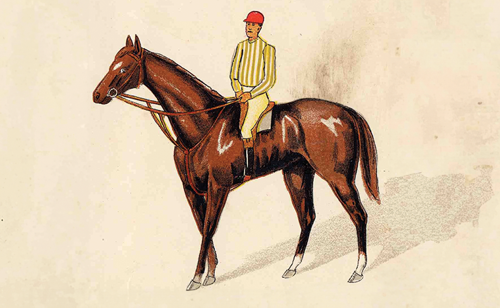
Trainer: Tommy Wilson
Jockey: Mick O’Brien
Silks: White And Green Stripes, Red Cap

Unlucky for some: prominent racehorse owner Thomas Reibey, of Entally House, Tasmania, passed up the opportunity to buy Sheet Anchor at auction as a yearling, preferring the colt Stockwell. And when Stockwell narrowly lost the 1882 Melbourne Cup to The Assyrian, Reibey sold him and his full brother—Malua—who went on the win the 1884 Melbourne Cup. Sheet Anchor was raced by the Irish-born Ballarat mining magnate, Martin Loughlin, trained at Dowling Forest, Ballarat, by Tommy Wilson who trained a second Melbourne Cup winner in 1889, Bravo. Jockey Mick O’Brien was among the outstanding Victorian jockeys of his day, winning a second Cup on Mentor in 1888. O’Brien was the regular rider of Carbine until chronic asthma brought about his retirement, and his early death in 1892.
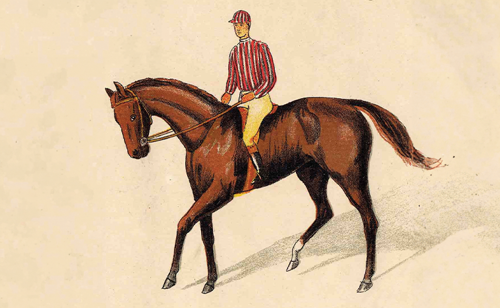
Trainer: Harry (Harry) Rayner
Jockey: William English
Silks: Maroon And Cream Stripes, Maroon Cap

A horse who raced with tender feet throughout his career, Arsenal was considered a lucky winner of the Cup. A son of 1875 Melbourne Cup placegetter, Goldsborough, he had only two career wins. He was first raced by Gippsland pastoralist and politician, the Hon. William Pearson, who sold him after an inglorious run in the 1885 Melbourne Cup. The new owner was NSW publican and prolific owner of racehorses, William Gannon. Harry Rayner at Randwick trained the horse quietly over the next year, helped by his regular young rider, Billy English, without racing him, so the Cup victory after this long spell came as a surprise to many. Arsenal held off by a long neck the good New Zealand horse, Trenton, who had finished third the previous year. Arsenal was sold to the stud in Tasmania in 1889. His best son was Murmur who won the Caulfield Cup in 1904 for owner John Wren.
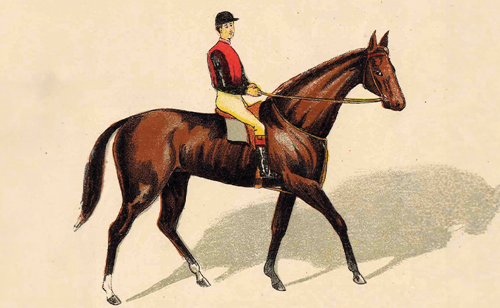
Trainer: John Nicholson
Jockey: Tommy Sanders
Silks: Red, Black Sleeves And Cap

Dunlop, a NSW-bred winner at Flemington as a two-year-old in 1885, subsequently lost form before being purchased in mid-1886 by Richard Donovan, licensee of the Pastoral Hotel near Flemington, on the advice of jockey, Tommy Sanders. The owner won a unique Melbourne Cup trophy—a mounted gold horseshoe. Reliable rumours said that Sanders had a part ownership in the horse, and he certainly backed it to win the Cup, which was not forbidden under the rules at the time. Sanders was 22: he had a long career in the saddle, and later as a trainer. He famously rode Lord Wilton to success when the 1885 Adelaide Cup was run at Flemington. Trainer John Nicolson was just 28 when Dunlop won the race, having been mentored by Joe Morrison, who rode the 1869 Melbourne Cup winner.
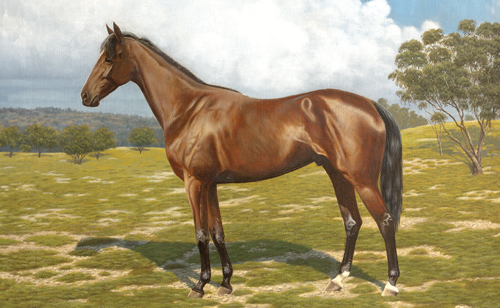
Trainer: Walter Hickenbotham
Jockey: Mick O’Brien
Silks: Black, White Sleeves, Scarlet Cap

Mentor’s Melbourne Cup was known as the Centennial Cup in the hundredth anniversary year of European settlement in Australia. Melbourne was at the height of a property boom: it was a time of extravagance and no expense spared. The VRC lifted the prize for the race by 3000 sovereigns making this the richest handicap race in the world. With the prize money, Mentor’s owner Donald Wallace purchased the rising New Zealand champion colt, Carbine, and raced him for the rest of his turf career. Trainer Walter Hickenbotham, born in Bathurst NSW, had only recently moved to Melbourne. Mentor was the first of his four Melbourne Cup winners. This was Mick O’Brien’s second Melbourne Cup win, having been successful on Sheet Anchor in 1885. O’Brien became the regular rider of Carbine until chronic asthma forced his retirement from the saddle in 1890. Mentor was a half-brother of Insomnia, dam of the great race mare, Wakeful.
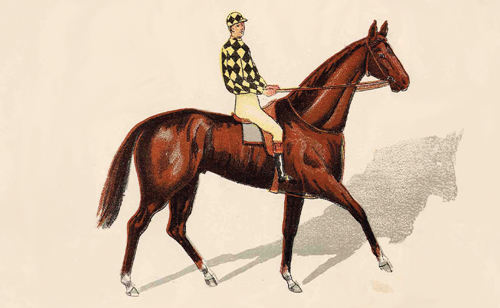
Trainer: Tommy Wilson
Jockey: John (Jack) Anwin
Silks: Yellow And Black Diamonds, Quartered Cap

A son of the 1880 Melbourne Cup champion, Grand Flaneur, Bravo is best remembered as a high-quality racehorse who beat the rising champion of the day, Carbine, into second place in the Cup of 1889. Bravo had previously finished third in the Caulfield Cup and second in the Melbourne Stakes three days before the Melbourne Cup. Collingwood-born lightweight Jack Anwin was about 20 when he won the Cup, his first big race win, having been first apprenticed to James Scobie at Ballarat. This was the second Melbourne Cup win for trainer Tommy Wilson at Dowling Forest, Ballarat. Bravo was owned by William Thomas Jones, a Welshman who had made and lost a fortune in mining speculation in Ballarat, and made it back again, and more, before retiring to London. He was not in Australia when his horse won the Cup. Jones is remembered today as a generous benefactor to the town of his birth, Aberystwith.
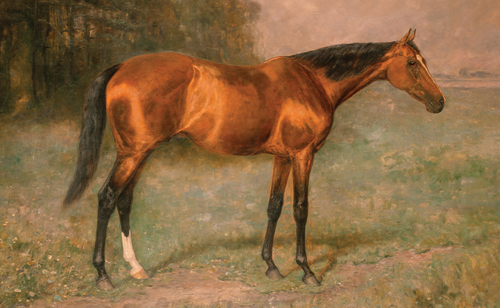
Trainer: Walter Hickenbotham
Jockey: Robert Ramage
Silks: Black, White Sleeves, Scarlet Cap

When the New Zealand-bred Carbine won the 1890 Melbourne Cup in a record field of 39 starters, carrying an all-time record weight of 10 stone 5 pounds (65.77 kg) and setting a new race record, he was registering his 27th win in 36 starts. This alone earned him legend status in Australian racing and Melbourne Cup history, to be rivalled in fame only by the 1930 winner, Phar Lap. Added to this was a stellar career at stud, first in Australia, then in England after owner Donald Wallace sold him for a then Australian record sum to the Duke of Portland. He began a dynasty of champion racehorses and sires, and most horses who race in Melbourne Cups in the 21st century can claim Carbine as an ancestor. This was trainer Hickenbotham’s second of four Cup wins. Jockey Bob Ramage had the good fortune to take the 1890 Cup ride after Carbine’s regular jockey, Mick O’Brien, retired from riding because of ill health.
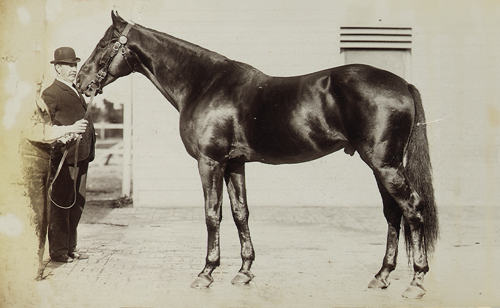
Trainer: James Redfearn
Jockey: George Redfearn
Silks: Royal Blue And Black Hoops, Royal Blue Cap

James Redfearn bred, owned and trained Malvolio, son of 1884 Melbourne Cup winner Malua, to win the 1891 Melbourne Cup. Redfearn’s 17-year-old son George rode him to victory, the boy’s first ride at Flemington. The runner-up, Strathmore, was unlucky to lose, suffering interference in the straight. With his winnings, James purchased the Nagambie property, Chatsworth Park, where he had once worked as a stablehand. George’s later career took him to India and Malaya. From 1926 he officiated for Singapore racing, evacuating just before the Japanese invasion in 1942, leaving his Cup trophy behind. Miraculously it was retrieved after the war. Malvolio’s full sister Maluma, a top sprinter, was exported to England and won good races there. A half-sister, Vanity Fair was placed in both the Caulfield and Melbourne Cups of 1902.
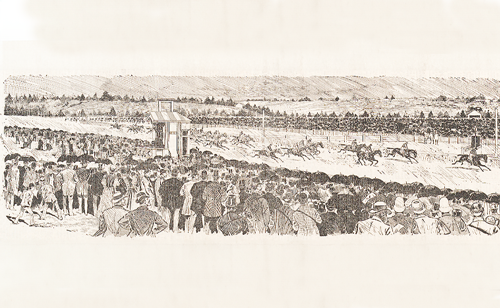
Trainer: Michael Carmody
Jockey: George Robson
Silks:Black And Red Hoops, Black Cap

Rain fell heavily all day on Cup Day 1892. The horses raced through the heaviest conditions, their jockeys’ colours indistinguishable to racegoers in the stands. Three horses fell in the running. The winner, Glenloth, was a rank outsider at odds at 50/1 after recovering from injury earlier in the year. Malvolio, the previous winner and favourite, was never a hope. Glenloth had won good races earlier in his career and was suited by the muddy conditions. He raced under the nomination of his Irish-born trainer, but was owned by James Urquhart, a prosperous Collingwood dairyman, not ‘a milkman’ as legend later suggested. Ballarat jockey George Robson was a late replacement for the horse’s regular jockey. He had no other big wins in his career. Injury plagued Glenloth and after a failed attempt at a comeback in 1894 he was retired to the stud at Mount Gambier.
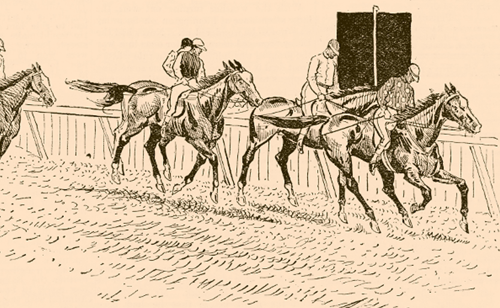
Trainer: Joseph Cripps
Jockey: Herbert (Bert) Cripps
Silks: Royal Blue And Gold Spots, Gold Cap

As with Don Juan in 1873 and Malvolio in 1891, it was a case of a father-and-son combination as winning owner-trainer and jockey when Tarcoola won the Cup. Bert Cripps, the jockey, had started race riding at age 11 and was 16 when he won the Cup—and the horse was seven. Steadily gaining weight, Bert Cripps had to retire from riding at 18, described as a ‘tall, strapping fellow’. Joe Cripps, the trainer, had arrived in Melbourne from England in the 1870s already with racing experience. He worked for trainer Sam Harding and later took over Harding’s Moonee Ponds stables. The 1893 Cup was his greatest success, although four years earlier Tarcoola had won the prestigious Williamstown Cup. Tarcoola was sired by the inaugural Caulfield Cup winner, Newminster. In the Melbourne Cup, he started at long odds and beat the Victoria Derby winner, Carnage—who, as a three-quarter brother to Carbine, went on to have an international career at the stud.
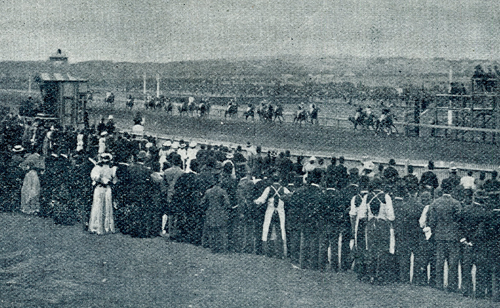
Trainer: Richard Bradfield
Jockey: Horace G. Dawes
Silks: Black, Red Seams And Cap

Following an impressive win in the Melbourne Stakes the previous Saturday, Ruenalf was sent out 3/1 favourite for the Cup. While all the focus was on Ruenalf, it was his younger full-brother, Patron, who saluted in Australia’s most important race. Ruenalf finished unplaced. They were sons of the 1880 Melbourne Cup winner, Grand Flaneur. This was the first of four Melbourne Cup training victories by Richard Bradfield. Patron was ridden by 17-year-old Horace Dawes, son of Harry ‘Chifney’ Dawes who rode Banker to victory in 1863. Patron’s victory was the first occasion where a father and son had each ridden a winner of the Cup. Horace went on to other good wins but at the age of 22 was killed in an accident at Wangaratta racecourse when leading a horse to trackwork.
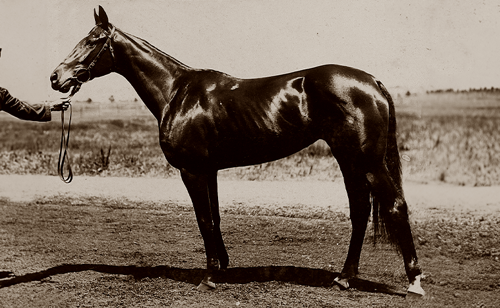
Trainer: John Hill
Jockey: John Stevenson
Silks: Royal Blue, Canary Sleeves, Red Cap

Auraria was one of the great fillies of Australian racing history, winning 10 of her 24 starts. In Melbourne Cup week 1895 she ran third to Wallace in the Derby, then won the Melbourne Cup and the VRC Oaks before dead-heating with Wallace in the C.B. Fisher Plate on the final Saturday. She is one of only three 3YO fillies to win the Melbourne Cup, in company with Briseis (1876) and Sister Olive (1921). Auraria was sired by Trenton, twice a placegetter in Melbourne Cups. She was owned by David James, one of the original prospectors who founded the Broken Hill Proprietary company. Like James, John Henry Hill was a South Australian, original trainer of The Assyrian (Melbourne Cup 1882) when the horse raced as Rothschild. Jack Stevenson, the lightweight jockey, 18 when he won the Cup, was born in NSW. He later rode overseas before returning to Australia as a horse trainer. He lost his life in a railway accident in 1921.
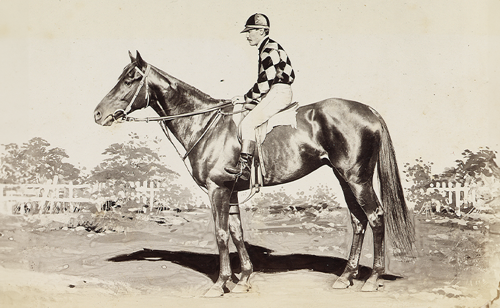
Trainer: Walter Hickenbotham
Jockey: Harry J. Gardiner
Silks: Yellow And Black Diamonds, Yellow Cap

Newhaven was a champion in both Australia and England. Foaled at St Albans, Geelong, he won five races at two years in Melbourne and Sydney including the VRC Maribyrnong Plate and Ascot Vale Stakes. Sold at three, he won ten of 13 starts including the Victoria Derby and the 1896 Melbourne Cup, both by large margins, ‘daylight second’. The Cup featured in the first moving pictures recorded in Australia. In 1897 Newhaven won the VRC Champion Stakes, Loch Plate, and the AJC All Aged and St Leger. Sent to England, he triumphed as Newhaven II in the 1899 City and Suburban Handicap and Epsom Gold Cup, finishing third in the Goodwood Cup and Ascot Gold Cup. Queries over his colonial dam’s pedigree (she traced to 1863 Melbourne Cup placegetter Musidora) ruled him ineligible for the English Stud Book. Returning to Australia, his stud opportunities were few. This was trainer Walter Hickenbotham’s third of four Melbourne Cup wins. Jockey Harry Gardiner, 24 when he won the Cup, rode regularly for the trainer, his later career taking him to India, Western Australia and Tasmania.
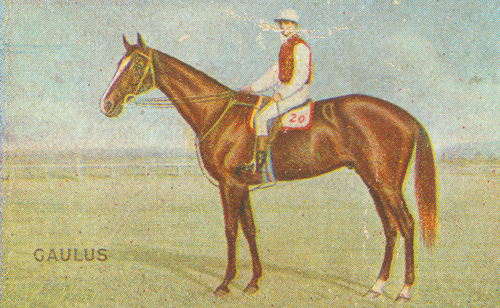
Trainer: William Forrester
Jockey: Stephen Callinan
Silks: Crimson, White Sleeves And Cap

For the first time, two stablemates (and two equine full brothers) ran the quinella—first and second places—in the Melbourne Cup, separated at the finish by a half head. This was another NSW victory: Gaulus was bred by John R. Smith at Tucka Tucka Stud near Wagga Wagga, as was the runner-up, The Grafter. The owner-trainer of both horses, William Forrester, had created Sydney’s Warwick Farm originally as a stud farm and training track before it opened as a racetrack in 1889. He engaged veteran trainer Noah Beale as his righthand man in 1890 and they prepared 1892 Melbourne Cup placegetters Ronda and Penance. Winning rider Steve Callinan,19 when he won the Cup, was originally from Inverell, member of a family of jockeys.
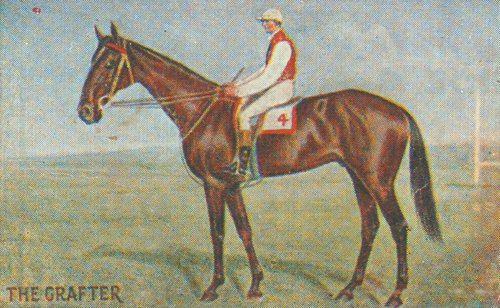
Trainer: William Forrester
Jockey: Jack Gough
Silks: Crimson, White Sleeves And Cap

The Grafter had finished second to his full-brother, Gaulus, the previous year before winning the race himself in 1898. Both horses were bred by John R. Smith at Tucka Tucka Stud near Wagga Wagga and were raced and trained by William Forrester, assisted by veteran trainer Noah Beale, at his Sydney property, Warwick Farm. The Grafter became one of several Australian horses of his era to race with success both in Australia and England. After taking the Melbourne Cup and C.B. Fisher Plate, The Grafter was sold to a racing partnership named ‘J.G. Clarke’ and, with trainer Jack Brewer, went to England. He won the rich City and Suburban Handicap at Epsom in 1900 and finished third to fellow Australian, Merman, in the Ascot Gold Cup. His owner retired the gelding in England in 1902. Winning Cup jockey Jack (John Richard) Gough’s brother Jim rode the 1881 winner, Zulu.
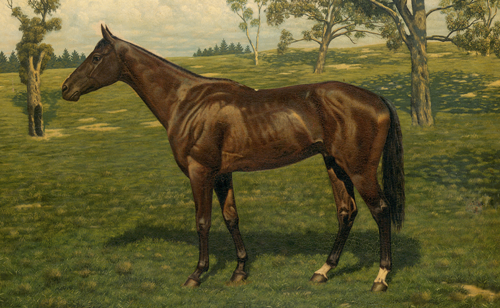
Trainer: James Wilson Jnr
Jockey: Vivian Turner
Silks: Brown, White Cap

James Wilson, trainer of Merriwee and son of James Wilson the founder of St Albans Stud, Geelong had himself come close, twice, to winning a Melbourne Cup when riding as a lightweight lad for his father in the 1870s, placed on Lapdog (1870) and Romula (1871). He grew into a strapping footballer, hero of Geelong Football Club, and also a formidable horse trainer. Herbert Power, owner of Merriwee, had previously owned the St Albans-trained Savanaka, unluckily beaten in the 1877 Melbourne Cup. A prominent pastoralist, Power was a founder of the Victoria Amateur Turf Club, and his memory has been long honoured at Caulfield with a feature race in his name. Merriwee won the Cup on a heavy track three days after winning the Victoria Derby. Jockey Viv Turner was 19 when he won the Cup: his later career was chiefly in Western Australia.
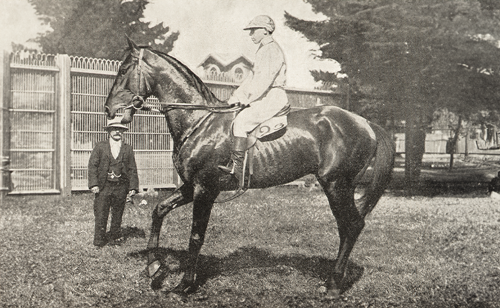
Trainer: James Scobie
Jockey: Andrew Richardson
Silks: White, Royal Blue Sleeves And Cap

Sold as a yearling by his breeder, Andrew Chirnside, Clean Sweep was raced by ‘F.T. Forrest’, the racing name used by Victoria Amateur Turf Club committee member, Frank Cumming. Trainer James Scobie was one of greats of the Australian turf, beginning his career as a jockey and steeplechase rider in the 1870s. Clean Sweep was the first of his four Melbourne Cup winners. In the 1900 Melbourne Cup, Scobie had four runners: Clean Sweep and Maltster finished first and second respectively. Both were champions. Clean Sweep had previously won the Moonee Valley Cup, while Maltster won the AJC and the Victoria Derby. The next year, Clean Sweep won the AJC St Leger at Randwick. He was then sold to England but had limited success at the stud. The 17-year-old jockey, Andrew ‘Dingo’ Richardson, was described as a freckle-faced youngster from Queensland. Eight years later he tragically drowned in a swimming accident.
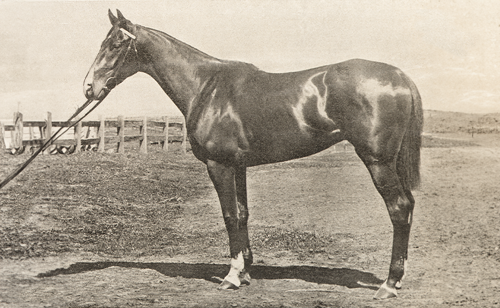
Trainer: Hugh Munro
Jockey: Frederick Dunn
Silks: Black, Rose Sleeves, White Cap

Revenue was raced by C. Leslie Macdonald, who managed the St Albans Stud, Geelong in the 1890s. The trainer, Hugh Munro, was father of the future champion jockeys Jim and Richard ‘Darby’ Munro. Both Macdonald and Munro had previously worked with J. Eden Savill of Lockleys Stud, Adelaide, trainer of 1882 Melbourne Cup winner, The Assyrian. Revenue, a son of Trenton, won the VRC Sires Produce Stakes at Flemington as a 2YO. The Cup was the first big race win for Munro’s nephew, Fred Dunn, 18 at the time. Dunn won many races on Macdonald’s champion mare, Wakeful but the young jockey died from infection in 1906 after an arm injury. Revenue, a handsome gelding, was lent on retirement to the Governor of Victoria, Lord Dudley, and he accompanied the Governor’s retinue to the 1909 Melbourne Cup. Later stories that Revenue became a war horse in the First World War are incorrect—he retired to a paddock in Gippsland.
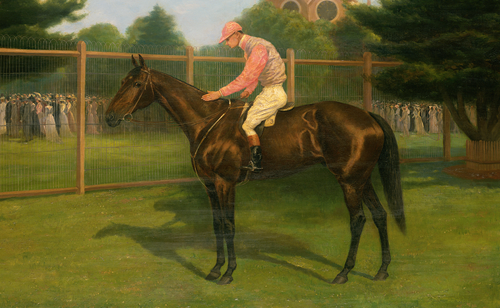
Trainer: Richard Bradfield
Jockey: Robert (Bobbie) Lewis
Silks: Lavender, Rose Collar, Sleeves And Cap

This was second of four Melbourne Cup wins for trainer Richard Bradfield, and the first of four as jockey for Bobbie Lewis, 24 years old at the time. Lewis’s fourth Cup win would come 25 years later, with Trivalve. He dominated the Victorian jockeys’ premiership for years, with multiple wins in the biggest races. The champion mare, Wakeful, did not accept for the race after being given the handicap weight of 10 stone 5 pounds (65.77 kg)—equivalent to the record weight that Carbine carried to win in 1890. The Victory was raced by the partnership of eminent Australian businessmen Lionel Robinson and William Clark who had recently established a stockbroking firm in London. The Victory was exported to the stud in Ireland in 1904 but died less than five years later.
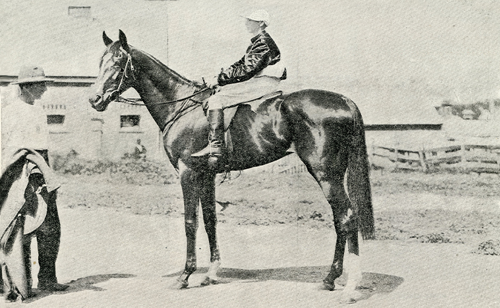
Trainer: Albert E. Cornwell
Jockey: Norman Godby
Silks: Black, Pale Blue Sash And Cap

Lord Cardigan’s Cup victory is especially remembered for the narrow defeat of Wakeful in her final race. Wakeful was truly the first lady of the turf, winning from sprint distances of an Oakleigh Plate and Newmarket Handicap up to a two-mile Sydney Cup. In the Melbourne Cup, she carried 10 stone (63.5 kg) while the 3YO Lord Cardigan had 6 stone 8 pounds (41.7 kg). Wakeful’s jockey, Fred Dunn, took her to the lead too far from home but she was beaten narrowly at the finish. Lord Cardigan was a good horse. He went on to win the Sydney Cup, and in the next Melbourne Cup he carried top weight and ran second to the lightly weighted mare, Acrasia. He was owned and raced by prominent NSW breeder John Mayo, trained in Sydney by veteran Albert Cornwell. Jockey Norman Godby, born in Armidale NSW, was 15 when he won the Cup: in 1920s he trained the winners of the VRC Grand National Hurdle and Steeplechase.
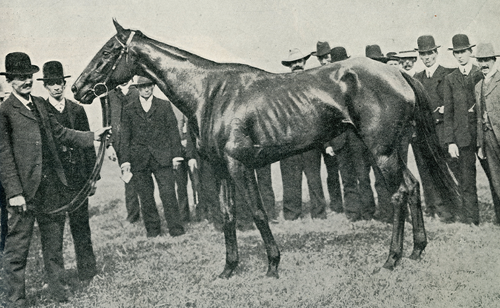
Trainer: Albert Edward Wills
Jockey: Tom Clayton
Silks: Violet And Gold Stripes, Violet Cap

Acrasia was raced by the flamboyant Sydney bookmaker, Humphrey Oxenham, who was lucky to retain her when she won the Cup. Press reports said that he had lost the mare on a wager in a poker game to John Mayo after the Caulfield Cup, a race in which she finished second. Oxenham quickly negotiated to repurchase the mare. She enjoyed a two stone (12.7 kg) advantage in the weights over the previous year’s winner, Lord Cardigan, and her race time equalled the record set by the champion Carbine in 1890. Newcastle-born trainer Albert Wills was based at Randwick, and Tom Clayton at 22 was the rising star of Sydney racing. He went on the win the Melbourne Cup again two years later on the brilliant Poseidon. Clayton died in race fall at Rosehill in 1909. Acrasia is recorded as the first mare to win the Melbourne Cup.
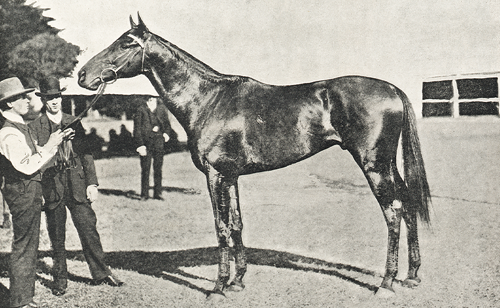
Trainer: Walter Hickenbotham
Jockey: Frank Bullock
Silks: Scarlet, White Sash And Cap

Blue Spec was bred and first raced in NSW before being sold to the prominent Western Australian owner and punter, P.A. (Paddy) Connolly. Connolly would own no fewer than seven Perth Cup winners, but it was Blue Spec who landed him the ultimate prize—the Melbourne Cup. Following victory in the Kalgoorlie Cup and the Perth Cup, Blue Spec was sent by Connolly across to Victoria to be trained by Walter Hickenbotham. The horse won the Moonee Valley Cup ahead of his Flemington victory. It was Hickenbotham’s fourth Melbourne Cup win. He had the service of Australian jockey Frank Bullock, who at age 21 had just returned from his first successful riding stint in England and Europe. Bullock later cemented his place as one of Australia’s greatest jockeys and trainers, winning prestigious races in Germany, France, England and India as well as in Australia in a career extending to his death in 1948.
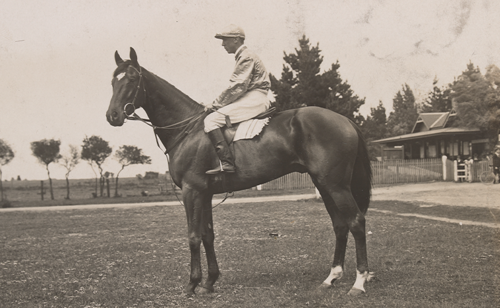
Trainer: Isaac Earnshaw
Jockey: Tom Clayton
Silks: Purple

Poseidon goes down in history as one of the greatest 3YOs to have raced in Australia. In the space of a year, he won 11 of 14 races including the Caulfield and Melbourne Cups, the AJC Derby and the Victoria Derby and the VRC and AJC St. Legers. No other horse has matched this record. A favourite story is that from the spring of 1906 he was supported at every win by a Chinese punter, Jimmy Ah Poon, who reportedly accumulated more than £30,000 starting from a £5 bet. Poseidon was sired by Positano, father of four Cup winners. Heavily weighted, he finished sixth, a beaten favourite, in the next Melbourne Cup. ‘Ike’ Earnshaw was a well-established Randwick trainer at the peak of his career, and he won the race the next year with Apologue. Top Sydney jockey Tom Clayton had previously won the 1904 Melbourne Cup. He lost his life in a race fall at Rosehill in 1909.
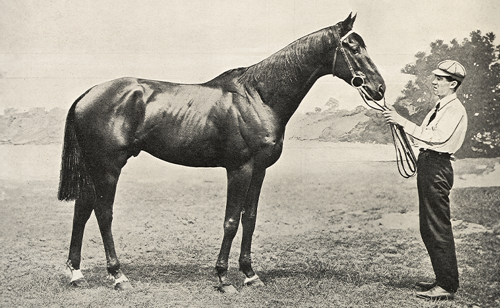
Trainer: Isaac Earnshaw
Jockey: William Evans
Silks: Red, Black Sash, Yellow Sleeves And Cap

After winning the Caulfield-Melbourne Cup double in 1906, Poseidon returned to Melbourne in 1907 and won the Caulfield Cup a second time. His new stablemate, the New Zealand-bred and owned Apologue, was a close runner-up to him at Caulfield and met him in the Melbourne Cup on more favourable weight terms. Consequently, Apologue was heavily backed, and landed big wagers for the Earnshaw stable. Apologue was the first Cup winner to be owned by a New Zealander and was a half-brother to Gladsome, a prolific winning mare in both countries. South Australian-born jockey Billy Evans had ridden with little success on the pony-racing circuit in Sydney before trying his luck in India. There he won the prestigious 1906 Viceroy’s Cup on former Queensland champion, Fitzgrafton. He returned to Sydney and secured the ride on Apologue but wasted dangerously to get down to the light weight. He collapsed upon dismounting and was so ill that he was only just able to stand and weigh in, to confirm the victory.
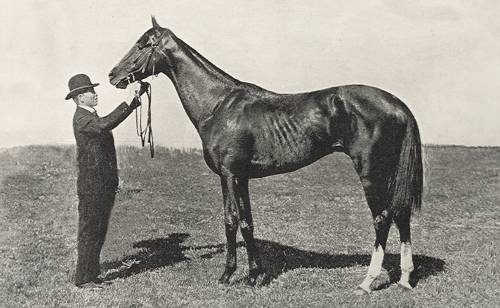
Trainer: Ernest A Mayo
Jockey: John R. Flynn
Silks: Black, Pale Blue Sash And Cap

Lord Nolan was a small, three-quarter brother to the Melbourne Cup winner of 1903, Lord Cardigan. Both were named after heroes of the charge of the Light Brigade in the Crimean War in 1854, and both horses were bred and owned by John Mayo of Maitland, NSW. Mayo did not have a large stable of horses, and Lord Nolan was trained by his son, Ernest. Lord Nolan finished third in the Victoria Derby three days earlier but performed better in the Cup under his lighter weight. The happy owner reportedly plied his colt with champagne after the race—apparently to no ill effect. The next year Lord Nolan won the AJC St Leger at Randwick. Jockey Jack Flynn, born in Victoria, was one of four brothers who rode with success in Western Australia.
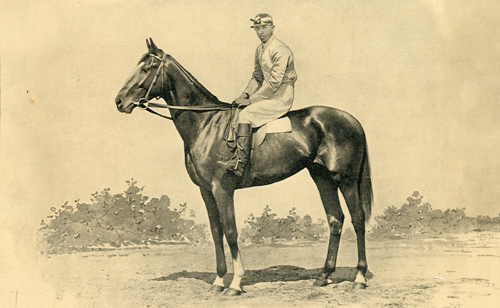
Trainer: Frank McGrath
Jockey: William H. McLachlan
Silks: Pale Blue, Yellow Sleeves, Black Cap

Prince Foote was a 3YO champion with a record to rival Poseidon’s. His eleven wins included the AJC and the Victoria Derby, the AJC Sires Produce and the St Leger and the VRC St Leger, He was bred and raced by the Newcastle (NSW) coal mining magnate John Brown who enjoyed the racing name of ‘Mr J. Baron’. Brown had a famous rivalry with his brother William who went on to win the 1912 Cup with Piastre. Prince Foote at the stud sired Victoria Derby winner Richmond Main, second in the 1919 Melbourne Cup. Frank McGrath, trainer of Prince Foote, went on to train the great Peter Pan, winner of the 1932 and 1934 Melbourne Cups. Jockey W.H. McLachlan, sometimes nicknamed ‘Midget’, was 22 when he won his first Melbourne Cup but had already ridden with success overseas. He won the race again in 1910 and 1917. He was the great-grandfather of trainers Lee and Anthony Freedman who achieved their own Melbourne Cup success stories. He was also the great-great-grandfather of Sam Freedman, also a Melbourne Cup Winning trainer.
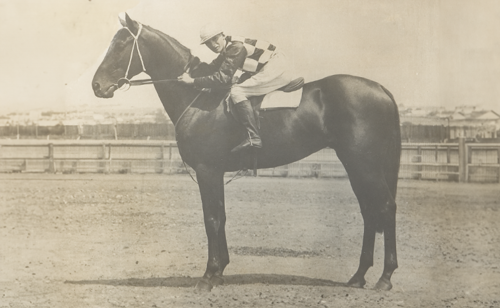
Trainer: James Lynch
Jockey: William H. McLachlan
Silks: Black, White Checks, Red Sleeves And Cap

Solomon Green in his time was the best-known and most successful bookmaker in Victoria. He invested heavily in property and horses, acquiring Shipley Park Stud at Warrnambool. In 1907 he and his trainer, Jim Lynch, visited England to buy mares for the stud. The purchases included Tragedy Queen with her black foal at foot, by Persimmon. Green named the foal Comedy King. The colt did not race until he was a 3YO, taking the 1910 Caulfield Futurity at his second start. By winning the 1910 Melbourne Cup, Comedy King became the first ‘imported’ northern-hemisphere horse to win the race, although the British-bred Panic was runner-up in 1865. Comedy King won other big races and went on to become a great Australian sire. Two sons won Melbourne Cups (Artilleryman 1919, King Ingoda 1922), while the popular Shadow King ran in six Melbourne Cups, for two seconds, two thirds, a fourth and a sixth. This was jockey McLachlan’s second of three Melbourne Cup wins.
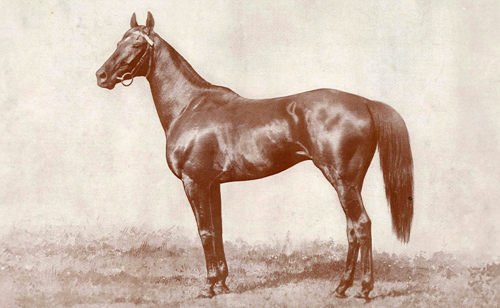
Trainer: Charlie Wheeler
Jockey: T. Ronald Cameron
Silks: Royal Blue, Gold Armbands And Cap

Owned by a South Australian grazier, John Kirby, The Parisian started 5/1 for the Cup following a good third in the Melbourne Stakes the Saturday before, having won the Australian Cup at Flemington in the autumn. The Parisian was ridden by the versatile New Zealand-born jockey, Ron Cameron, as successful over the jumps as he was on the flat, who went on to a long career in Victoria as a trainer. In this Cup he rode a confident race and was never in doubt, winning by two lengths. Trafalgar, an acknowledged champion, started favourite for the third year in a row after finishing second in 1910, but this year finished unplaced. Charlie Wheeler, originally from the Upper Murray, had been training horses in Melbourne since the 1880s: he was successful again in the Melbourne Cup in 1915 with Patrobas.
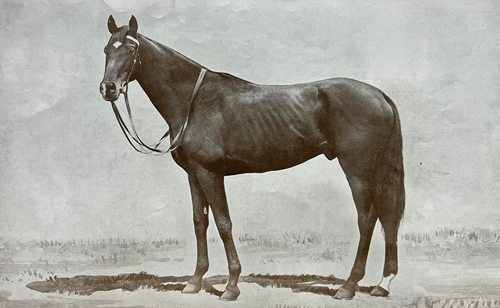
Trainer: Richard O’Connor
Jockey: Albert Shanahan
Silks: White, Purple Sleeves, Red Cap

Piastre was the fourth son of imported British sire Positano to win the Melbourne Cup, after Lord Cardigan, Poseidon and Lord Nolan. His first race win, in Sydney, was recorded only one month before the Cup. His NSW owner-breeder, William Brown, was the brother and racing rival of John Brown, whose horse Duke Foote started hot favourite at 6/4 in the race but ran ingloriously. Duke Foote had beaten Piastre comfortably at each of their previous two races, including the Melbourne Stakes three days earlier. James Scobie had trained Piastre as a 2YO before the horse joined the successful stable of Richard O’Connor in Sydney. Sydney jockey Alby Shanahan, originally from Newcastle, won the Cup again in 1913 on Posinatus.
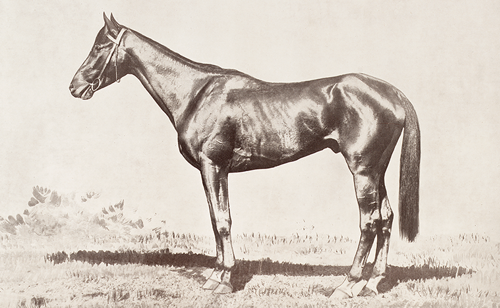
Trainer: James Chambers
Jockey: Albert Shanahan
Silks: Lilac, White Sleeves, Red Armbands And Cap

Posinatus won’t go down in history as the best horse to win a Cup but he will be remembered as part of a dream that netted one punter more than £36,000. This punter woke up in the middle of the night and predicted the Caulfield and Melbourne Cup winners down to the names and the numbers. He backed the double accordingly. Posinatus had never won beyond 10 furlongs and it was only the smart riding of Albert Shanahan, who slowed the field up considerably, allowing Posinatus to win. It was Shanahan’s second race victory in consecutive years.
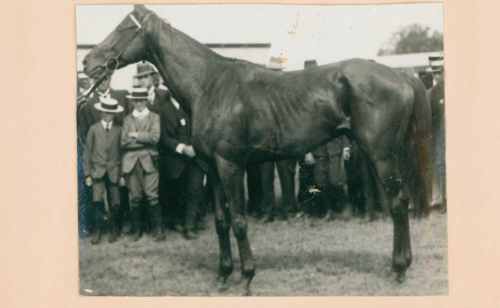
Trainer: Isac Foulsham
Jockey: George Meddick
Silks: White, Orange Braces, Collar And Two Armbands With Black Outline, Orange Cap

War in Europe had broken out just three months before the 1914 Melbourne Cup. The effects of what came to be known as the First World War on life in Australia were only just beginning to be felt. Scottish-born solicitor L.K.S. Mackinnon had been a member of the VRC Committee for the past ten years. He became Chairman in 1916 until his death in 1935. Under the name ‘K.S. Macleod’, Mackinnon had previously raced several horses with success. Funded by his 1914 Cup win, Mackinnon acquired the Chatsworth Park stud farm at Nagambie. Kingsburgh was a son of champion sire Wallace, so a grandson of Carbine, but the Melbourne Cup was only Kingsburgh’s second race win. He was trained in Sydney by Ike Foulsham whose previous Melbourne Cup win was thirty years earlier, with Malua. The winning Sydney jockey, George Meddick, was 17 years old.
Trainer: Charlie Wheeler
Jockey: Robert (Bobbie) Lewis
Silks: Rose Pink

The 1915 Melbourne Cup winner, Patrobas, was owned by a woman—Edith Willis, of Rosedale, near Sale in Gippsland. The news was widely reported at the time and has become an essential moment in Melbourne Cup history. In the previous century it was rare, though not unprecedented, for women to racehorses as owners in their own name. Charlie Wheeler, who trained the 1911 Melbourne Cup winner, The Parisian, is credited with selecting the horse for Mrs Widdis at a yearling sale. Like Kingsburgh, the previous winner, Patrobas was sired by Wallace, son of Carbine. The colt won the Caulfield Guineas and the Victoria Derby before winning the Cup. This was jockey Bobbie Lewis’s 19th ride in the Melbourne Cup and his second of four wins in the race. The Cup was held in sombre wartime conditions in the year when Australian forces were under fire at Gallipoli.
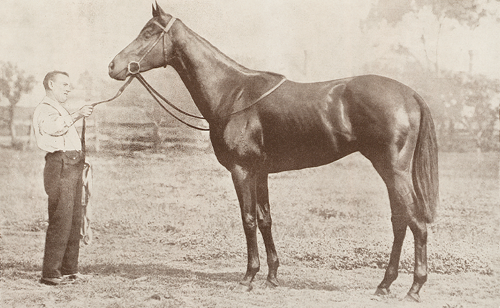
Trainer: Murray Hobbs
Jockey: Fred Foley
Silks: Yellow, Black Cap

The 1916 Melbourne Cup was held at the mid-point of the First World War, a time of great anxiety. The weather added to the gloom: heavy rain forced the postponement of Cup Day for only the second time in its history. The race was put off until the following Saturday, 11 November, when the weather had cleared and the track drained. New Zealand-bred and owned horses had won Melbourne Cups before, but this was the first time a New Zealand-trained horse had triumphed. Wilfred G. Stead was one of the most successful racehorse owners in his country, and Murray Hobbs trained for him at Christchurch. Sasanof won the Victoria Derby ahead of the Melbourne Cup. Most of his racing career was in New Zealand, his wins including the Great Northern Derby and the NZ Cup. The jockey Fred Foley was from NSW and was 17 when he won the Cup.
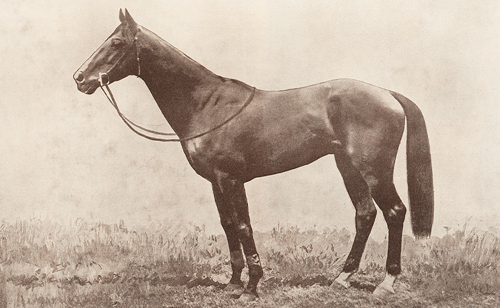
Trainer: Joseph Burton
Jockey: William H. McLachlan
Silks: Orange, Green Sash And Cap

Westcourt had recorded a succession of minor placings in big races before he achieved his greatest success in winning the 1917 Melbourne Cup. Two years earlier he had lost by a short half head to Patrobas after finishing third to the same horse in the Victoria Derby. In the AJC Derby, he finished third to Cetigne, the horse who then beat him in the Melbourne Stakes. In the 1917 Cup, his luck turned. He had been bred in NSW by Hugh Denison and was raced by prolific Sydney owner and thoroughbred breeder, Daniel U. Seaton. Joseph Burton was a veteran Randwick trainer whose first winners had been racing in the 1870s. Late in his career he bred Bitalli, the 1923 Melbourne Cup winner. Westcourt gave jockey W.H. McLachlan senior his third Melbourne Cup win.
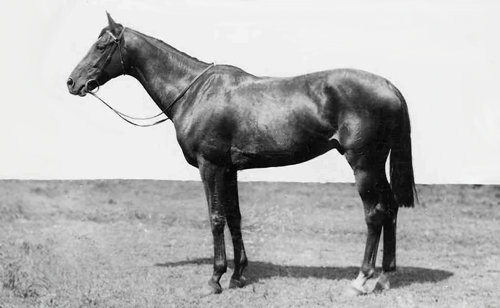
Trainer: Richard Bradfield
Jockey: William (Billy) Duncan
Silks: Black, Pink Sleeves, White Cap

The First World War ended just days after the 1918 Melbourne Cup was run. When Night Watch won the big race, racegoers were recalling the days of his mother, the great Wakeful, who was the darling of the turf at the start of the century: her courageous second in the 1903 Melbourne Cup, carrying 10 stone (63.5 kg), defeated by the lightly weighted Lord Cardigan, is how the public remembered her. Night Watch was raced by Wakeful’s owner, C.L. Macdonald. He won his Melbourne Cup with the fly weight of 6 stone 9 pounds (42.2 kg). This was trainer Richard Bradfield’s third of four Melbourne Cup wins. Night Watch was ridden by Billy Duncan, 18 at the time and relatively unknown to racegoers. He would ultimately secure 11 premiership titles, two Melbourne Cups and become a racing household name. In 1919, Night Watch won the Caulfield Stakes and ran second in the Caulfield Cup to Lucknow.
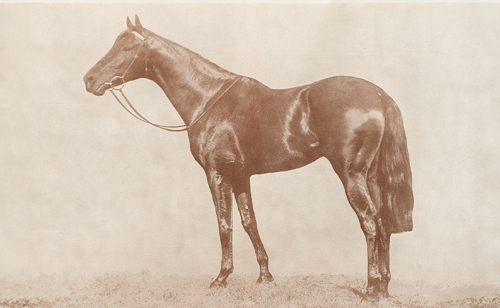
Trainer: Phillip T. Heywood
Jockey: Robert (Bobbie) Lewis
Silks: Grey, Red Sash

Artilleryman was the easiest of winners, securing victory by at least six lengths and setting a new race record. He was a son of the 1910 winner, Comedy King, while his archrival Richmond Main, who finished second after beating him in the Victoria Derby, was sired by the 1909 winner, Prince Foote. Altogether, Artilleryman won 11 of his 26 race starts including the 1919 AJC Derby where he dead-heated with Richmond Main. Sydney merchant and bloodstock breeder Samuel Hordern raced the horse in partnership with Melbourne-based pastoralist Alexander Dyce Murphy. The owners received the very first of the now-traditional three-handled gold Melbourne Cup trophies designed and made by Melbourne goldsmith, James Steeth. Trainer Phil Heywood was the son of J.G. Heywood, one of the founders of Caulfield Racecourse. This was jockey Bobbie Lewis’s third of four Melbourne Cup wins.
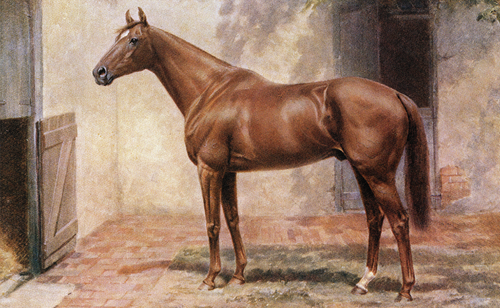
Trainer: Harry J. Robinson
Jockey: Ken Bracken
Silks: Yellow, White Sleeves, Black Cap

The brothers William (Bill) and Frederick Albert Moses bred the colt Poitrel at their famed Arrowfield Stud NSW, retaining him to race after he failed to sell as a yearling. This was before the Melbourne Cup win in 1919 by Night Watch, sired by the same imported St Alwyne, who stood at Arrowfield. Under Sydney trainer Harry Robinson, Poitrel won a string of rich Sydney races, beating the best horses of his time including Desert Gold, Wolaroi and Gloaming. He was allotted the heavy weight of 10 stone (63.5kg) in the 1920 Cup: only two horses in Cup history have won with more (Archer 1861, Carbine 1890). Robinson retired from training the year after Poitrel’s win. Jockey Kenneth Henry Bracken, born in Parkes NSW in 1895, rode Poitrel in ten of the horse’s victories.
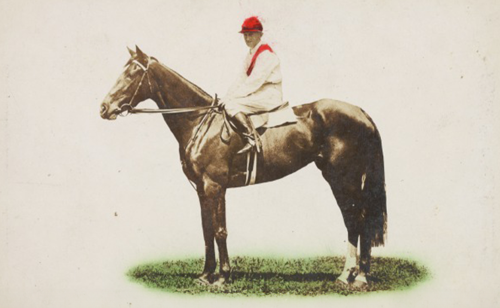
Trainer: Jack Williams
Jockey: Edward (Ted) O’Sullivan
Silks: White, Red Sash And Cap

Posting only her second race victory, Sister Olive became just the third 3YO filly ever to win the Melbourne Cup, joining Briseis (1876) and Auraria (1895). She raced in the red and white colours of the South Melbourne football and cricket clubs where her owner-breeder, bookmaker Fred Norman, had been president. She was foaled at his Clarendon Park, Molesworth, Victoria. Her dam was a half-sister of 1910 winner, Comedy King. The trainer, Jack Williams, had been a top jockey in his day, narrowly losing the 1885 Melbourne Cup on Grace Darling to Sheet Anchor. This was the biggest career win for Geelong-born Ted O’Sullivan (real name Edward Kenny), who later became a trainer of note. Unplaced in the 1921 Cup was the heavily weighted Western Australian champion, Eurythmic. Sister Olive is an ancestor of the great Tobin Bronze.
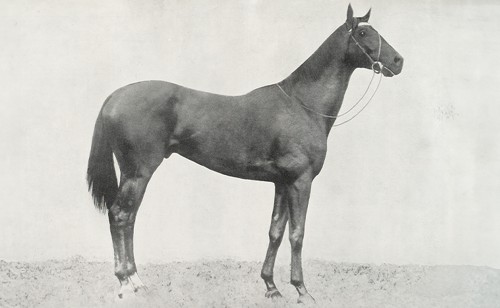
Trainer: James Scobie
Jockey: Alan Wilson
Silks: Royal Blue, Pink Sash

It was a race remembered for its big field and star-studded line up. King Ingoda became the second winner of the Melbourne Cup to be sired by 1910 winner Comedy King. His dam, Ingoda, had won the New Zealand St Leger. In 1918 Sol Green dispersed his Shipley Park Stud at Warrnambool: Charles Dubois, a wealthy South Australian with pastoral interests in the Northern Territory, acquired the mare who was in foal to Comedy King. Contrary to some later stories, King Ingoda was foaled and raised at Dubois’s property at Magill, Adelaide, not in the Territory. He was trained in Victoria by James Scobie who had already prepared a Melbourne Cup winner, Clean Sweep (1900). King Ingoda won the 1922 Hotham Handicap on Victoria Derby Day before winning the Cup. The following year he won the Adelaide Cup. Jockey Alan Wilson, 19 at the time and widely known as ‘Tich’, went on to ride the 1923 Melbourne Cup winner, Bitalli.
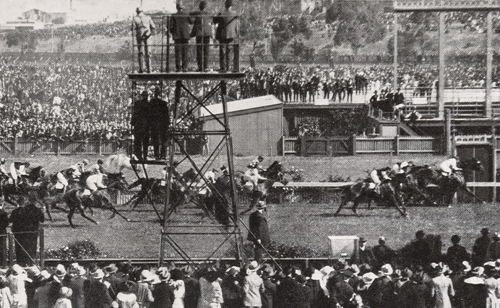
Trainer: James Scobie
Jockey: Alan Wilson
Silks: Royal Blue And White Hoops, Red Cap

Bitalli’s pedigree differed from that of previous Melbourne Cup winners. He was the first to be sired by an American-bred horse: October had raced as ‘Rock Rib’ in the US before being sold to race in Great Britain. October was then sent to NSW during the First World War. Joseph Burton, who trained Westcourt to win the 1917 Melbourne Cup, was the breeder of Bitalli from his mare Miss Phillina, a granddaughter of 1880 Melbourne Cup winner, Grand Flaneur. After a promising fourth in the 1923 Sydney Cup, Bitalli was sold to Alfred Thomas Craig whose family ran the Melbourne city department store, Craig, Williamson Ltd. James Scobie became trainer. Bitalli then won the two-mile Adelaide Tattersall’s Cup in July and did not race again until the Melbourne Cup. Scobie and his lightweight jockey, Alan ‘Tich’ Wilson, had won the Cup the previous year.
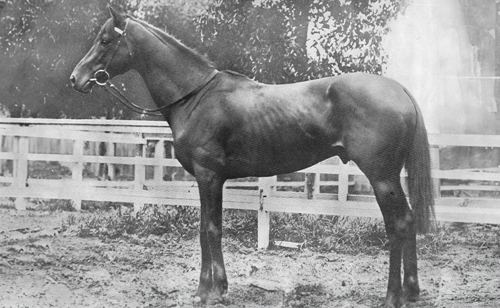
Trainer: Richard Bradfield
Jockey: Perry ‘Bunty’ Brown
Silks: White, Purple Seams, Red Cap

Following the success of Comedy King in 1910, Backwood was the second imported horse to win the Melbourne Cup, and the first to have raced before coming to Australia. During the First World War when racing overseas was restricted, several British and European horses were sent to race successfully in Australia, and the trend continued post war. Foaled in Ireland in 1919, Backwood won the 1922 King Edward VII Stakes at Ascot before being bought by auctioneer Edward Lloyd ‘Prince’ Baillieu (a VRC Committee member since 1915) and William Clark and sent to Richard Bradfield to train. Clark had a previous share in 1902 winner The Victory, also trained by Bradfield. Bunty Brown was an experienced jockey when he won the Cup, having ridden in Sydney, Melbourne, India and the UK. He won the 1922 Victoria Derby and Caulfield Cup on Whittier. Brown retired from riding in 1927.
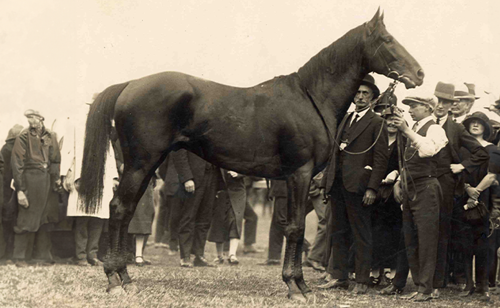
Trainer: George R. Price
Jockey: James (Jim) L. Munro
Silks: Pale Blue, Black Diamond And Sleeves, Yellow Cap

A versatile champion who could win from 6 furlongs to two miles, Windbag put up a strong performance to defeat the highly talented, wayward colt, Manfred, in the 1925 Cup. Both horses carried two pounds over weight-for-age and the race became an epic duel down the Flemington straight. Percy Miller bred the horse at his Kia-Ora Stud, NSW, the sire the imported British horse, Magpie. After some confusion at the 1923 Sydney yearling sales, the colt was sold to the breeder’s brother, Robert Miller, for just 150 guineas. In his career, Windbag won 18 of his 26 starts, trained in Sydney by the former New Zealand jockey, George Price. This was the first of two Melbourne Cup wins by jockey Jim Munro, older brother of Richard ‘Darby’ Munro. Jim was 19 when he won on Windbag.
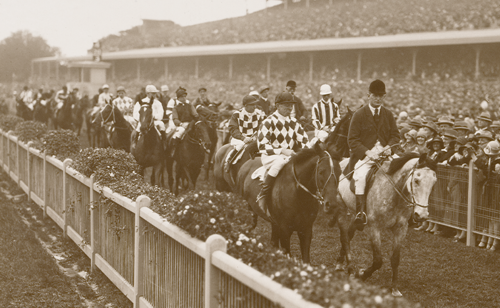
Trainer: Vincent O’Neill
Jockey: Hughie Cairns
Silks: Black And White Diamonds, Black Cap

Spearfelt was a great-grandson of Carbine—through Spearmint, winner of the 1906 English Derby and then Spearmint’s son, Spearhead, imported as a sire to Australia. Douglas Grant, a returned Australian soldier from the First World War, used his deferred pay to buy Spearfelt as a yearling. The colt became a champion. At three years, Spearfelt won the 1924 Victoria Derby and finished third behind Backwood in the Melbourne Cup. He won the 1925 VRC St Leger, before winning the 1926 Melbourne Cup in equal record time, followed by the 1927 Australian Cup. Grant sold him to the stud in NSW where he sired many winners, including Dark Felt who won the 1943 Cup. Vincent O’Neill trained for many years at Caulfield: Spearfelt was his best horse. Hughie Harold Cairns had been a successful New Zealand jumps rider before coming to Australia. In 1929 he lost his life in a hurdle race accident at Moonee Valley.
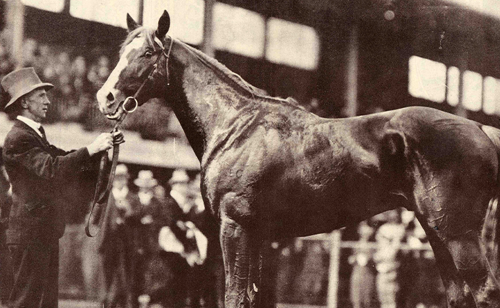
Trainer: James Scobie
Jockey: Robert (Bobbie) Lewis
Silks: Light Blue, Pink Sleeves And Cap

Trivalve was a great-grandson of Carbine on the sire’s side of the pedigree. As well, Carbine was a great-great-grandsire on his dam’s side. Trivalve’s sire, Cyklon, was imported by Ernest E.D. Clarke to his Melton Stud near Melbourne, where Trivalve was foaled in 1924. James Scobie, in his late 60s, was by now in effect Clarke’s private trainer: the pair had enjoyed success for four decades. Scobie later estimated he trained 146 winners for Clarke in his career. Trivalve was Scobie’s fourth Melbourne Cup winner but the first for Clarke. It was also Bobbie Lewis’s fourth Cup victory as jockey. Now aged 49, Lewis became the oldest jockey to win the race. Trivalve won the rare treble of the AJC and Victoria Derby and Melbourne Cup in the one year, followed by three more wins in autumn 1928 including VRC St Leger, but was retired with leg soreness before the end of his 3YO season. Unsuccessful at stud, and sold after Clarke’s death in 1941, Trivalve ended his days in the Northern Territory.
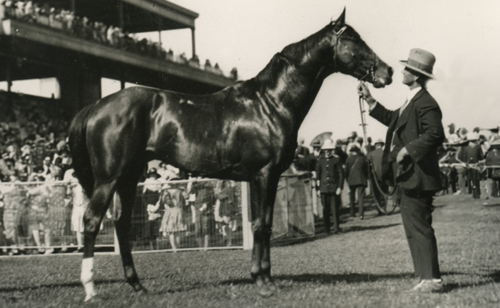
Trainer: William Kelso
Jockey: James (Jim) L. Munro
Silks: Red, Black Sleeves, White Armbands And Cap

The dam of Statesman, Marcelle, was one of many English horses exported to Australia in the First World War. Statesman was her best foal, bred and first raced in NSW by William Kelso. In 1927 he was sent to Melbourne and finished second in the Victoria Derby and sixth in the Melbourne Cup, both races won by Trivalve. Although he had won only twice in numerous races in his career, he was clearly coming into form ahead of the 1928 Cup and started as one of the favourites. This Cup was the second win for Jim Munro who won the Cup in 1925 riding Windbag. The Munro family, boasting Hugh (trainer of Revenue 1901), his jockey sons Jim and Darby, and their cousin Fred Dunn, between them secured a tally of seven Melbourne Cup victories. Kelso’s Statesman is sometimes confused with the younger Irish-bred Statesman, third in Hyperion’s 1933 English Derby.

Trainer: Alec McAulay
Jockey: Roy Reed
Silks: Purple, Gold Spots

Was New Zealand horse Nightmarch lucky to have won the 1929 Melbourne Cup? Some believed so because the great Phar Lap finished in third place. Champion jockey Scobie Breasley later observed that ‘Phar Lap probably should have won the Cup if it had not been for the fact he pulled for half the race. [Bobbie] Lewis should have let him slide along, but Phar Lap was more than a handful and proved hard to contain.’ Nevertheless, Nightmarch was a champion, winning 24 and placed in 29 of his 69 starts in Australia and New Zealand, later becoming a top sire. His owner, NZ businessman Alfred Louisson, bought the horse in 1928 on the recommendation of trainer Alec McAulay. In 1930 McAulay declared Phar Lap was the best horse in the world, and the two horses—both sired by Night Raid—never clashed again. Nightmarch’s jockey, Roy Reed, was killed in a race fall in New Zealand in 1936. His younger brother Ashley won the 1937 Melbourne Cup on The Trump.
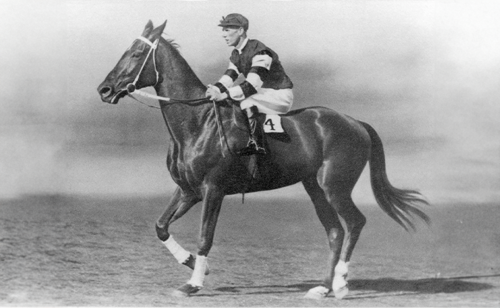
Trainer: Harry R. Telford
Jockey: James (Jim) Pike
Silks: Red, White and Black Hooped Sleeves

Most observers at the time and ever since revere the New Zealand-bred Phar Lap as Australia’s greatest racehorse, and it seem fitting that he holds the record for starting the shortest priced favourite (8/11 fav) in the history of the Cup. He won with ease carrying 9 stone 12 pounds (62.6 kg) and, as a hero horse in tough economic times, he carried the weight of a nation on his back. It was a triumph for Sydney jockey Jim Pike, having his 14th ride in the Cup, and especially for trainer Harry Telford who had struck gold when he paid just 160 guineas for the scrawny yearling at the Trentham Sales in 1928. Phar Lap’s extraordinary performance is only bettered by his record in winning on each of the four days of the Flemington Cup Carnival. In his career he recorded 37 wins from 51 starts. His only unplaced run, excepting at the start of his amazing career, was in the Melbourne Cup the following year.
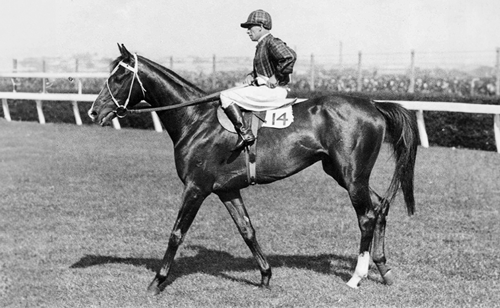
Trainer: Ernest Hatwell
Jockey: Neville Percival
Silks: Mclachlan Tartan, White Sash

White Nose’s Cup victory is widely remembered for the anti-climax of Phar Lap’s final Australian race, when for the first time in 41 starts since he was an early 3YO, he finished unplaced. The champion carried 10 stone 10 pounds (68 kg), which no horse had carried to victory in the Cup. Phar Lap had taken all before him through the spring and despite the huge weight was sent out the public elect at 3/1 favourite. White Nose had won the Hotham Handicap the previous Saturday and went into the Cup with support. His handicap weight was 6 stone 12 pounds (43.5 kg). Half a mile from home it was evident that Phar Lap could not win back-to-back Cups, and jockey Jim Pike eased up. It would be the last time Australians would see the ‘Red Terror’ before he headed to the USA. White Nose was bred and raced by South Australian grazier Hugh McLachlan and prepared by his private trainer Ern Hatwell. West Australian-born jockey Neville Percival on White Nose went on to a globe-trotting career.
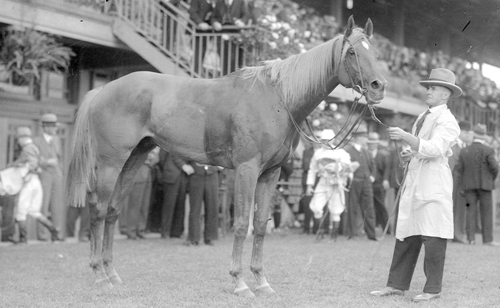
Trainer: Frank McGrath
Jockey: William (Billy) Duncan
Silks: Orange And Green Hoops, Orange Cap

Months after Phar Lap’s death in the USA, another exceptional racehorse emerged. Peter Pan was soon lauded as one of the great Australian stayers and his victory in the 1932 Cup was one the bravest wins in the race. With 1000 metres left to run, Peter Pan received such a severe jolt he nearly fell. With a second accidental bump, this time from his stablemate, Denis Boy, he regained his balance. With the skill of jockey Billy Duncan, Peter Pan re-established momentum, and went on to win the Cup by a neck. He was bred and raced by NSW pastoralist Rodney Rouse Dangar. Trainer by Frank McGrath at Kensington, Sydney, Peter Pan won the AJC Derby before his victory in the Cup. McGrath was a former jockey, injured in the running of the disastrous 1885 Caulfield Cup. In his long training career, he prepared many champions, including 1909 Cup winner Prince Foote, but rated Peter Pan as the best. This was Melbourne jockey Billy Duncan’s second Melbourne Cup win.
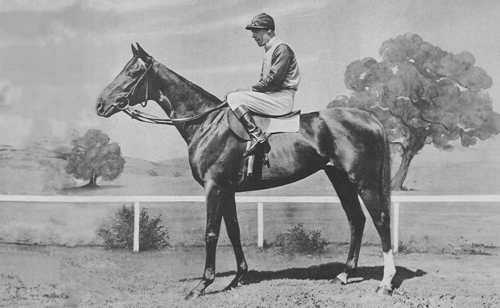
Trainer: Michael (Jack) Holt
Jockey: Jack O’Sullivan
Silks: Gold, Green Sleeves And Cap

Hall Mark was bred and raced by the motor dealer and former champion cyclist, Charles Kellow, who also owned the sire, Heroic, late in that horse’s successful racing career. Prepared in Melbourne by master trainer Jack Holt whose string of winning racehorses had earned him the nickname ‘the Wizard of Mordialloc’, Hall Mark was not a great looker as a young horse, but he won top 2YO races in Sydney and the AJC Derby and the Victoria Derby at three years. After working on the Monday morning before the Cup, Hall Mark appeared lame. With constant attention by the trainer overnight, he overcame all ailments to win the Cup. Hall Mark continued racing and winning until 1936, his victories including the 1935 Doncaster Handicap. NSW Jockey Jack O’Sullivan was a son of trainer Pat O’Sullivan, and later became a trainer himself. He was not related to Ted O’Sullivan who rode the 1921 Cup winner, Sister Olive.
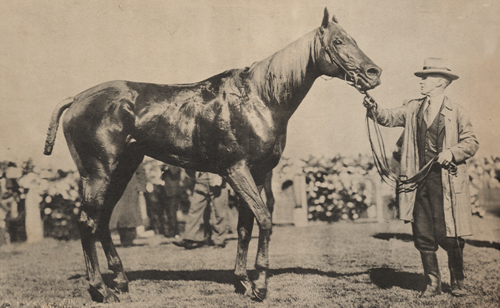
Trainer: Frank McGrath
Jockey: Richard (Darby) Munro
Silks: Orange And Green Hoops, Orange Cap

Peter Pan became the first horse since the inaugural winner, Archer, to win two Melbourne Cups: in the case of Peter Pan there was a two-year gap, as he had been sidelined with rheumatism for much of 1933. As a 5YO and a past winner, this time he carried top weight of 9 stone 10 pounds (61.7 kg) and the track was heavy after consistent rain, which ceased shortly before the race. Trainer Frank McGrath had the horse’s tail plaited and bound to keep it out of the mud and was rewarded with his third Cup win as a trainer. Jockey Darby Munro was 21 at the time: this was the first of what would be his three Melbourne Cup wins. His older brother, Jim, had won the race twice. Starting from the extreme outside of the field, Darby Munro kept Peter Pan wide for much of the race but on the firmer going. It was a popular, courageous win by a handsome chestnut horse.
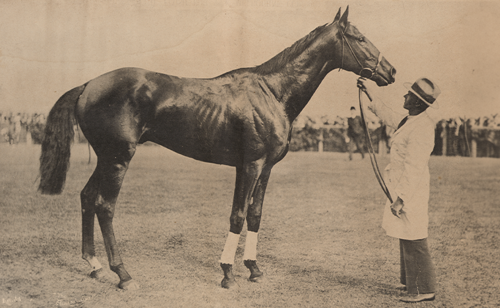
Trainer: Lou Robertson
Jockey: Keith Voitre
Silks: Royal Blue, White Stripes, Yellow Sleeves And Cap

Andy Robertson, brother of trainer Lou Robertson, was credited with importing the English mare Vivandiere and mating her with the imported stallion Marconigram to produce Marabou, foaled at A.P. (Paddy) Wade’s Borambola Stud near Wagga Wagga in 1931. After injury interrupted his training, Marabou finished fourth in the 1934 Victoria Derby and was unplaced in the Melbourne Cup. Andy Robertson sold the horse to Tom Hogan and his racing partner, Joseph Fell, on condition that Lou Robertson continued as trainer. Marabou was placed in both the 1935 Caulfield Cup and the Melbourne Stakes ahead of his win in the Melbourne Cup. Joseph Fell, already ill, made his way to Flemington to watch the race and died two days later. Marabou was then sold to C.B. Kellow and retired to the stud. His progeny included 1941 Melbourne Cup winner, Skipton. New Zealand jockey Keith Voitre rode Marabou: he was 22 when he won the Cup. Just three years later, he lost his life in a race fall in New Zealand.
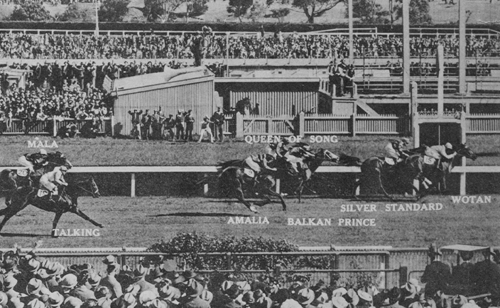
Trainer: Jack Fryer
Jockey: Oswald (Ossie) Phillips
Silks: Pale Blue, Gold Collar, Cuffs And Cap

Wotan’s chief fame in Melbourne Cup history is that he is one of four horses to have won at odds of 100/1. In hindsight the odds were puzzling as Wotan was a half-brother of the good New Zealand horse Gaine Carrington who won the 1933 Caulfield Cup, and of Peter Jackson, who won the 1933 Moonee Valley Cup. The dam, Left, came into the ownership of three brothers Smith, dairy farmers in the North Island of New Zealand, and they bred and raced Wotan. The colt showed early promise, but there were disappointments. Only the enthusiasm of the owners and a late win at Wanganui saw him sent to Australia to join a team of horses prepared by his NZ trainer, Jack Fryer. Caulfield jockey Jack O’Brien missed the ride with a broken arm, so local jockey Ossie Phillips picked up the ride, expecting only a losing ride fee. Wotan’s only other big win was the Feilding Gold Cup at Awapuni in 1938.
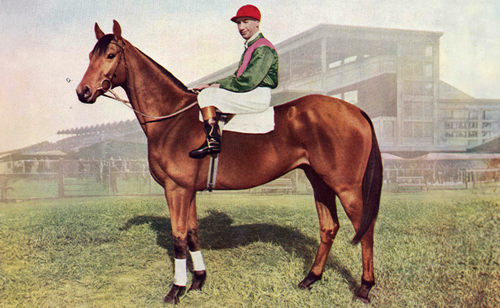
Trainer: Stanley W. Reid
Jockey: Ashley Reed
Silks: Green, Pink Sash, Red Cap

The Trump was owned by Darcy Eccles, who had come close in the 1922 and 1932 Melbourne Cups with The Cypher and Yarramba respectively. Eccles went one better with The Trump whose other wins in the spring of 1937 included the Caulfield Cup, the Toorak Handicap and the Mackinnon Stakes. He was bred by Leslie Aldridge at Kismet Park Stud, South Australia. He was by Manfred and, as was often said about the line of Spearmint, he was described as a weak-jointed individual. No one told The Trump. Eccles paid 200 guineas for the colt as a yearling. The trainer was former New Zealand jockey Stan Reid who originally rode for George Price, trainer of Windbag. Moving to Victoria, Reid then rode the double of the Grand National Hurdle and Steeplechase in 1921, both on Mountain God. He took to training five years later. The Trump was ridden by New Zealand jockey, Ashley Reed, whose brother Roy had won the 1929 Cup on Nightmarch.
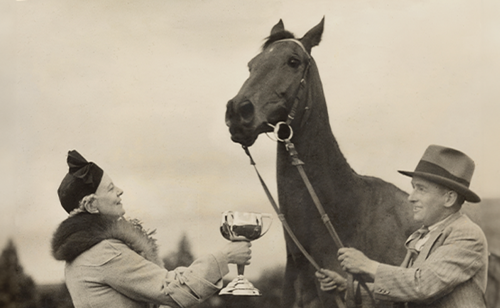
Trainer: Allan McDonald
Jockey: Fred Shean
Silks: Cerise, Gold Spots And Cap

‘A victory for women: that is the story of the 1938 Melbourne Cup’, ran the headlines at the time. While Allan McDonald’s name stands in the record books as the official trainer of 1938 Melbourne Cup winner, Catalogue, there is no ambiguity that the New Zealand horse was trained throughout his career by McDonald’s wife, Hedwig ‘Granny’ McDonald. She was a talented, registered trainer with stables at Riccarton, Christchurch. It was understood—though not legally accurate—that Victoria’s rules of racing prevented women from training horses professionally. Mrs McDonald decided it was simplest to send her husband to supervise Catalogue’s quest to win the Melbourne Cup after the horse’s win in the Winter Cup at Riccarton. Catalogue was bred at Hawkes Bay and was owned by Mrs Tui Jamieson, who did make the trip to Melbourne to watch the race, unlike Granny McDonald. Allan McDonald was an accomplished horseman in his own right. He secured the Queensland jockey, Fred Shean, for the winning ride.
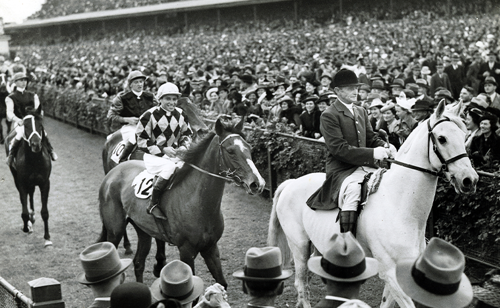
Trainer: Harry Bamber
Jockey: Edward (Teddy) Preston
Silks: Black And Rose Pink Diamonds, Rose Pink Cap

A true rags-to-riches story: Harry Bamber was down to his last dollar as a battling owner-trainer when his mare Rivette landed the Caulfield and Melbourne Cup double. Modestly bred, she was the daughter of a little mare whose wins had been at the pony races. Through blind faith, Bamber bred one of the most durable Cup winners of all. Bamber was so keen on the prospects of Rivette he backed her at long odds to win ₤15,000 in the spring of 1938 only to see her go amiss. On return to the track a year later, Rivette proved she had lost none of her ability and won the Caulfield Cup convincingly. Bamber started her in the Moonee Valley Cup one week later and but for a very poor start would have won that race as well. She subsequently started hot favourite for the Cup. She won accordingly. She was ridden by Teddy Preston, not long out of his apprenticeship to Phar Lap’s trainer, Harry Telford.
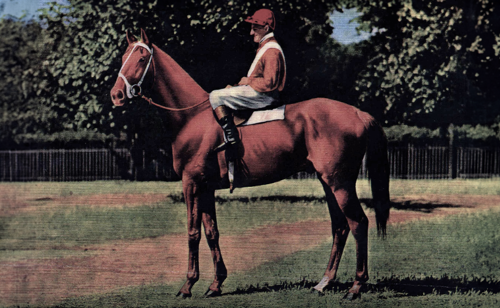
Trainer: Jack Scully
Jockey: Andy Knox
Silks: Orange, White Sash, Red Cap

One year into the six years of the Second World War, life in Australia was changing. The Melbourne Cup went ahead as normal, and for the first time in the history of the race, a Queensland-bred horse was the winner, bred by J.G. McDougall of Lyndhurst Stud near Warwick. Old Rowley was foaled in1933, a son of the imported British horse The Buzzard, a prolific sire and descendant of Carbine. Old Rowley was owned and trained in Sydney by Jack Scully and showed good form in 1938 with a win in the AJC Plate at Randwick and third placings in the Australian Cup and in the Hotham Handicap at Flemington. He was a 7YO when he returned to Melbourne in 1940 with just two placings in recent races, so he started at odds of 100/1. The experienced Sydney jockey Andy Knox had the ride. The favourite, Beau Vite, had been the target of a botched shooting attempt the Wednesday prior to the Cup, and finished a credible fourth.
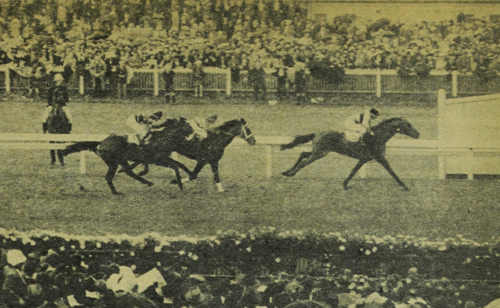
Trainer: Jack Fryer
Jockey: W. (Billy) Cook
Silks: Grey, Green Band, Black Cap

Skipton, son of 1935 winner Marabou, won the Melbourne Cup as a 3YO. Until that time, many three-year-olds had won the Cup, several of them after the winning the Victoria Derby. Skipton was the last to complete this double and, after Skipton, no 3YO won the Cup for the rest of the century. The saddlecloth number 13 is ‘unlucky for some’, yet not for Skipton. His owner, Myrtle Kitson was sufficiently superstitious to think she would jinx the horse if she attended the Cup. Instead, she listened in from the Grand Central Hotel in Hamilton, where she and her husband were the licensees. New Zealand trainer Jack Fryer had settled in Melbourne after he won the 1936 Cup with Wotan. Skipton was ridden by Sydney lightweight rider Billy Cook who won again on Rainbird in 1945. His son Peter would ride two Melbourne Cup winners. Skipton won a Caulfield Cup in 1943 when it was run in two divisions at Flemington.
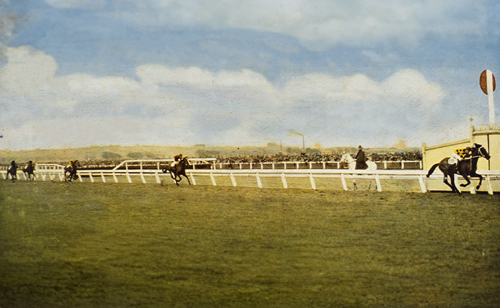
Trainer: Frank Manning
Jockey: Harry McCloud
Silks: Yellow And Green Spots, Red Cap

The Melbourne Cup race won by Colonus was a sombre affair, with Australia itself under threat in the Second World War. In Victoria, racing continued under severe limitations, restricted to three Saturdays each month, with many courses closed. The 1942 Cup was run in wet conditions on Saturday 21 November, in front of the smallest crowd in 70 years. Colonus boasted Comedy King and Carbine in his pedigree. He had been foaled at Warlaby Stud, Melbourne and first raced unsuccessfully under trainer Cecil Godby before being sold cheaply to Sydney businessman Leo Menck. He remained in Victoria, in the care of Frank Manning at Mentone. Colonus relished the heavy Melbourne Cup track, winning by seven lengths, ridden by 17-year-old apprentice Harry McCloud, whose later riding career was in Perth. ‘War Bonds’ to the value of £200 were presented to the owner in lieu of the traditional gold trophy, as they were again in 1943 and 1944. Menck later commissioned a replica Cup trophy with the money
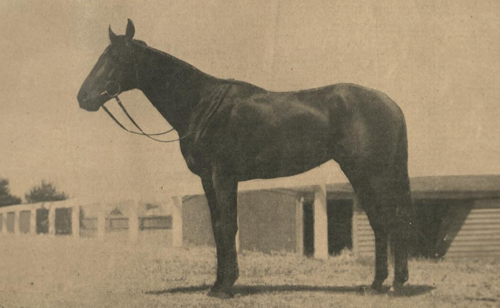
Trainer: Ray Webster
Jockey: Victor Hartney
Silks: Pink, Black Band And Cap

Dark Felt was a son of 1926 Melbourne Cup winner, Spearfelt. He was bred in Queensland at Thomas Jennings’s Alma Vale Stud, Greenmount and sold at the Sydney yearling sales to Frank Musgrave, famous as trainer of champion Ajax. Dark Felt ran third in the 1940 Victoria Derby. Reducing his team in 1943, Musgrave sold the horse to E.W. Spark who leased the horse to former jockey J. Alby Cain, who trained the horse himself before sending him to Ray Webster at Pakenham. His wins included the 1942 Moonee Valley Cup and the 1942 and 1943 Hotham Handicaps. As a wartime Cup, the race was run on Saturday 13 November. Vic Hartney, 23 when he won the Cup, was one of the top Melbourne jockeys in the era, later a successful trainer.
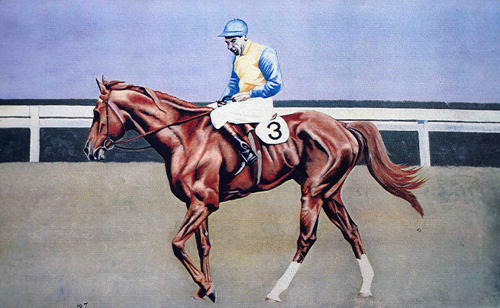
Trainer: Elwood (Ted) Fisher
Jockey: Richard (Darby) Munro
Silks: Cream, Royal Blue Sleeves And Cap

Sirius was owned and bred by Richard Turnbull, who became the first incumbent VRC Chairman to own a winner of the Melbourne Cup. Turnbull had been a committeeman since 1935 and became Chairman in 1942, steering the Club through one of the most difficult periods in its history. Wartime conditions severely curtailed the transport of racehorses, but the 1944 Cup attracted a good field. Sirius won the Herbert Power Handicap and then the Hotham Handicap leading into the Cup, which for the third successive year was run on a Saturday. Ted Fisher was a veteran Flemington trainer who had first come to Melbourne in 1911 as a jockey after riding with success for several seasons in Singapore. For Darby Munro, this was the second of his three Melbourne Cup victories. Sirius later stood as a sire at Sir Chester Manifold’s Talindert Stud before being retired to Queensland.
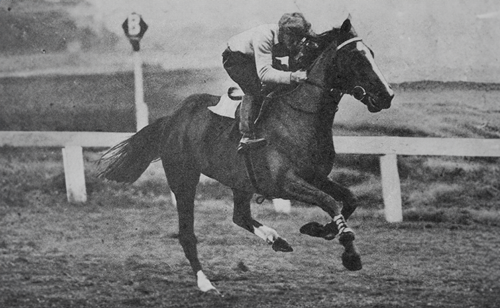
Trainer: Sam H. Evans
Jockey: W. (Billy) Cook
Silks: Gold, White Spots

With the Second World War at last ending, and Peace declared in September 1945, the Melbourne Cup returned to its traditional date, the First Tuesday in November. Dubbed ‘the Victory Cup’, it attracted a huge crowd. South Australian businessman and pastoralist Malcolm Reid bred the winning filly, Rainbird (by The Buzzard, sire of 1935 winner Marabou) and sold her to his brother Clifford. Malcom won his own Melbourne Cup with Gatum Gatum (1963) while Cliff scored twice again with champion Rain Lover (1968, 1969). Rainbird had run second in the 1944 VRC Oaks. In 1945 she won a Port Adelaide Cup and South Australian St Leger and was second in the 1945 Caulfield Cup. Her Melbourne Cup win was the career highlight of trainer Sam Evans, a former Australian Rules footballer for Footscray at the turn of the century. Billy Cook picked up the ride only the Sunday before, for his second Cup win after Skipton (1941). His son, Peter, rode two Cup winners.
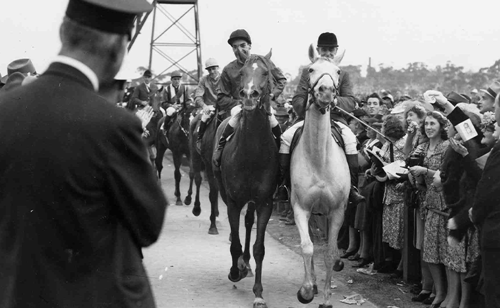
Trainer: Ted Hush
Jockey: Richard (Darby) Munro
Silks: Red, Brown Sash, Black Cap

Russia’s Cup was overshadowed when the crowd favourite, Bernborough, went amiss on the Saturday before, during the running of the Mackinnon Stakes. If Bernborough had won the Cup he would have carried a record topweight of 10 stone 9 pounds (67.6 kg) following his sequence of top-class victories in Sydney, Brisbane and Melbourne. Bernborough never raced again but went on to a brilliant stud career in the USA. His absence from the 1946 Cup left the door open for Russia, whose earlier wins included the 1944 Newcastle Cup. The horse had been bred by J. Gordon Leeds at Trangie, NSW, who raced him in partnership with his Randwick trainer, Ted Hush, a former NSW jockey. It was the third Cup win for jockey Darby Munro. In 1949, with 22 wins and a dead-heat in his career, Russia was sold to a syndicate headed by David Davis, the American owner of Phar Lap, to stand at stud in California, where he sired several winners.
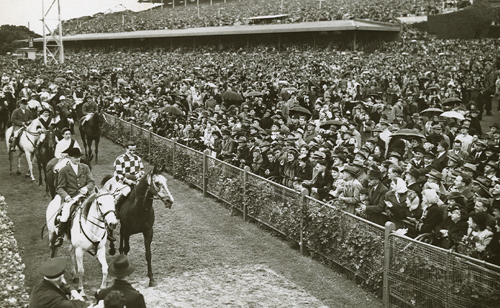
Trainer: James (Jim) W. McCurley
Jockey: Jack Purtell
Silks: Red And White Checks, Red Cap

Hiraji became only the second grey to win the Melbourne Cup, after Toryboy (1865). He was bred in New Zealand, bought as a yearling in 1944 by businessman Fred William Hughes who owned the extensive Kooba Stud near Wagga Wagga. Two years later, Hughes acquired the sire, the French-bred Nizami, and brought him to stand at Kooba. Leading into the 1947 Melbourne Cup, Hiraji had strung together a run of minor placings in big races: the King’s Cup, Theo Marks Quality Hcp, Toorak Hcp, Caulfield Cup and Hotham Handicap. Hughes chose not to be on course on Melbourne Cup Day, despite a confident plea from Jim McCurley, the trainer. McCurley’s stables were near Sydney’s old Moorefield Racecourse. The Cup win was the first for popular jockey Jack Purtell, who won the Cup twice again, with Wodalla (1953) and Rising Fast (1954).
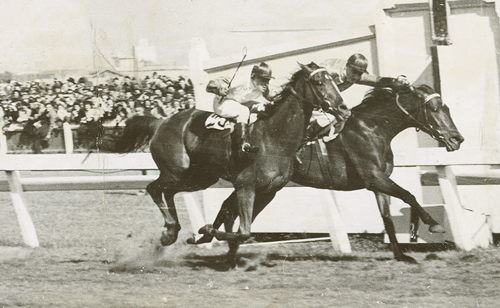
Trainer: Stan Boyden
Jockey: Ray Neville
Silks: White, Royal Blue Sleeves, Red Cap

The lightly weighted Rimfire, at 66/1, was not expected to win the Melbourne Cup: his form had been poor, and he seemed lame the day before the race. But his owner-breeder wanted him to run: H. Guy Raymond was a VRC Committeeman who had revived the famous St Albans Stud at Geelong. Stan Boyden was his private trainer. For apprentice jockey Ray Neville, it was just good to ride in the Cup. The boy was due to turn 16 the following day and had been riding in races for only two months. Rimfire was his ninth race ride, and only his second winner. He picked up the late ride on the morning of the race. Rimfire won narrowly from Dark Marne, ridden by experienced jockey Jack Thompson, amid conjecture over the result: Thompson could not believe he had not won. It was the first time a photo finish camera had been used to decide a Melbourne Cup. This was the high point of Ray Neville’s riding career. And Rimfire never won another race after the Melbourne Cup.
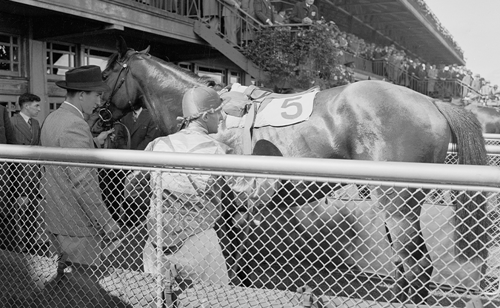
Trainer: Dan Lewis
Jockey: William (Bill) Fellows
Silks: Purple, White Maltese Cross, Red Cap

Like Hiraji in 1947, Foxzami who won the 1949 Melbourne Cup was foaled in New Zealand. His sire, the French-bred Nizami, was later purchased to stand at stud in Australia. Len G. Robinson, an Australian businessman who lived most of the year on Lord Howe Island, bought Foxzami at the New Zealand yearling sales and entrusted him to veteran Randwick trainer, Dan Lewis. At three years, Foxzami ran third in the AJC Derby and finished second behind Comic Court in the Victoria Derby. Dan Lewis had held ambitions for the Melbourne Cup for more than 40 years. He now trained Foxzami specifically for the 1949 Cup. After modest performances in the Caulfield Stakes and Cox Plate, Foxzami reached his peak form to win the Hotham Handicap before triumphing three days later in the Cup. This was the biggest race win for Sydney jockey Bill Fellows, 33, who had been riding since the age of 14.
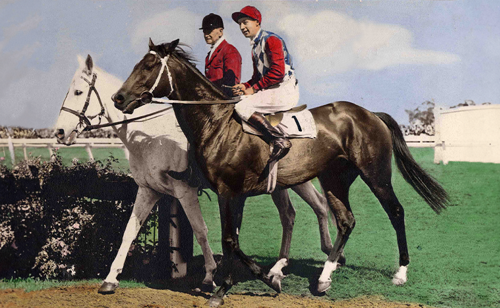
Trainer: James (Jim) M. Cummings
Jockey: Patrick Glennon
Silks: Dark Blue, White Diamonds, Red Sleeves And Cap

Comic Court was one of the true greats of the Australian turf. He won the Fulham Plate in Adelaide as a 2YO, the Victoria Derby as a 3YO, and a string of weight-for-age races and handicap races as an older horse. His consistent rival was his contemporary, Carbon Copy. In winning the 1950 Melbourne Cup, Comic Court created a new race and course record of 3 minutes 19.5 seconds which stayed intact for 18 years. Three months after the Cup, first up from a spell, he beat the best sprinters over six furlongs at Moonee Valley in the Freeway Stakes. Comic Court’s strapper on Cup Day was the trainer’s 20-year-old son, J.B. ‘Bart’ Cummings, who would go on to train 12 Melbourne Cup winners. Victorian jockey Pat Glennon rode a second Melbourne Cup winner, Macdougal (1959). Comic Court became a successful sire based in South Australia. His son Grand Print was twice placed in Melbourne Cups (1961, 1963).
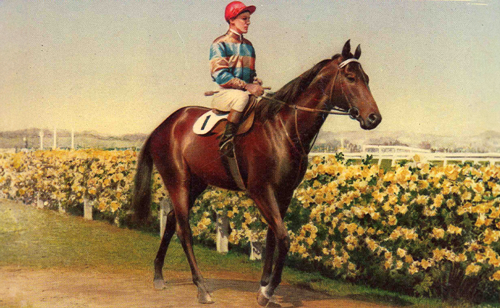
Trainer: Maurice McCarten
Jockey: Neville Sellwood
Silks: Brown And Dark Blue Hoops, Red Cap

Delta proved a number of theories wrong when he won the Cup in 1951. Top weights can win in successive years; high priced yearlings can make good racehorses; and winners of the AJC Metropolitan can win the Cup— even if the last horse to do so had been Tim Whiffler in 1867. Delta won 22 races in his illustrious career including the Victoria Derby and the Cox Plate. The Melbourne Cup win was popular. His Sydney owner, Sir Adolf Basser, was a successful jeweller and philanthropist. Maurice McCarten, formerly a top jockey, was now among the best Sydney trainers. Neville Sellwood, who won the Cup again on Toparoa (1955), had already cemented his place among the best Australian jockeys. He later rode with success in Britain and Europe, tragically losing his life in a race fall in France in 1962.
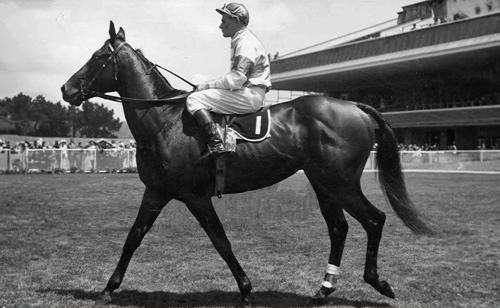
Trainer: Clarrie McCarthy
Jockey: W. (Bill) Williamson
Silks: Light Blue, White Sleeves, Dark Blue Armbands And Cap

The New Zealand horse Dalray’s victory in the Cup was a grand effort in carrying eight pounds (3.6 kg) over weight-for-age. As a 3YO his wins included the NZ Derby and Auckland’s Great Northern Derby. On that form he went to Sydney and ran a close second in the Sydney Cup and was allotted 9 stone 6 pounds (59.9 kg) for the 1952 Melbourne Cup. When Dalray was further penalised two pounds (0.9 kg) for his Metropolitan Handicap victory, his owner Cyril Neville said the horse would not start in the Cup. But the New Zealand trainer, Clarrie McCarthy, declared the Flemington track ideal for Dalray, the horse duly won the Mackinnon Stakes on Derby Day, ridden by local jockey Bill Williamson, who controversially replaced Dalray’s regular rider, Keith Nuttall, at the last minute. Williamson retained the ride for the Melbourne Cup.
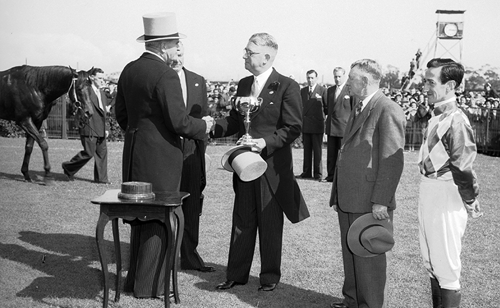
Trainer: Robert (Bob) Sinclair
Jockey: Jack Purtell
Silks: Red, White Diamonds

Wodalla became the fourth horse to win the Moonee Valley Gold Cup and Melbourne Cup double. Before the Moonee Valley Cup win, he had finished a close second to My Hero in the Caulfield Cup. Wodalla was sired by the imported Helios, son of Hyperion. He was foaled at Warlaby Stud, near Melbourne, bred and raced by E.A. (Ted) Underwood, who had been a VRC Committee member since 1939 and was the Vice-Chairman of the day. Bob Sinclair was his private trainer. Wodalla nearly did not get his chance of Cup glory after a lacklustre run the Saturday before the race. Persuasive powers of trainer and jockey kept the Cup hopes alive and delivered the dream. It was Jack Purtell’s second of three Melbourne Cup wins.
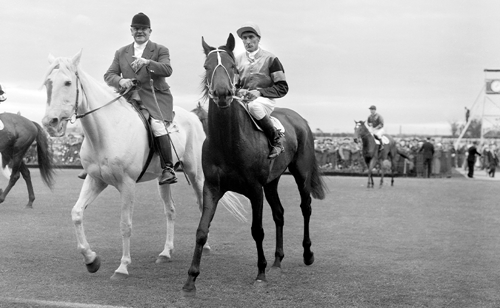
Trainer: Ivan Tucker
Jockey: Jack Purtell
Silks: Royal Blue, Black Sleeves, Gold Armbands And Cap

New Zealand hero, Rising Fast, through his amazing spring of 1954, was able to string together a succession of victories which included the Caulfield and Melbourne Cups as well as the Cox Plate. He is the last horse to win these three races in the same season. Following the Caulfield Cup, he was allotted the full ten-pound (4.5 kg) penalty, ensuring he carried weight-for-age in the Melbourne Cup. Rising Fast was ridden by Jack Purtell, a last-minute ride following the unavailability of Arthur Ward who rode him in the Caulfield Cup and an injury sustained by regular race rider, Bill Williamson, during the race prior to the Melbourne Cup. Rising Fast won on three days of the four-day Melbourne Cup Carnival. Throughout that year, Rising Fast was trained by New Zealander, Ivan Tucker. The champion was then transferred to veteran trainer Fred Hoysted for the remainder of his illustrious career.
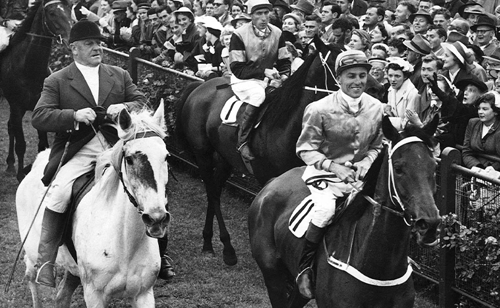
Trainer: T.J (Tommy) Smith
Jockey: Neville Sellwood
Silks: Dark Blue, Orange Stars And Sleeves, Dark Blue Armbands

If not for New Zealand trainer, Joe Bromby, Toparoa may never have come to Australia to write his name in Cup history. Bromby recommended the gelding be sent to top Sydney trainer T.J. Smith in a quest for bigger and better races. Although an 8YO by the time of the 1955 Cup, he showed form with a good second in the AJC Metropolitan and, with a light weight in the Cup, had support at 6/1 to thwart the topweight, Rising Fast’s, bid to repeat his 1954 victory. In the closing stages, Toparoa moved up to Rising Fast and drew away to win by three-quarters of a length. Toparoa’s rider, Neville Sellwood received a two-month suspension for interference in the closing stages but, in a great sporting gesture, Rising Fast’s connections elected not to protest. They believed that Rising Fast was labouring under his heavy weight and could not have beaten the winner. It was Sellwood’s second Melbourne Cup win, Smith’s first of two.
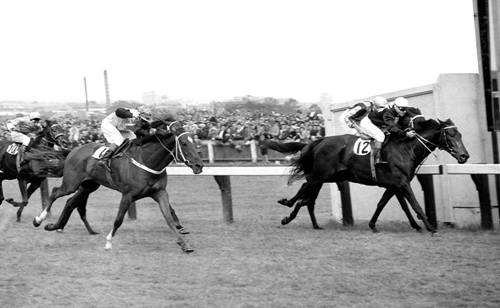
Trainer: E.D (Peter) Lawson
Jockey: George Podmore
Silks: Black, White Maltese Cross And Cap

Evening Peal, bred in NSW, was a daughter of the imported British sire Delville Wood. She became the first mare since Rainbird to win the Cup and the first to secure the VRC Oaks-Cup double in consecutive years. She also won the 1955 Queensland Oaks and the 1956 Adrian Knox Stakes. She won the Cup carrying 8 stone (50.8 kg), defeating the Caulfield Cup winner Redcraze (64.9 kg) by a neck. This was the year of the Melbourne Olympic Games, with many visitors arriving from beyond Australia. Two of the unplaced horses—Fighting Force and Pandie’s Son—had figured in a history-making triple dead heat at Flemington the Saturday prior, with Ark Royal, in the Hotham Handicap. ‘Peter’ Lawson had been a prominent Randwick trainer since the 1930s, and George Podmore was a regular rider for the stable.
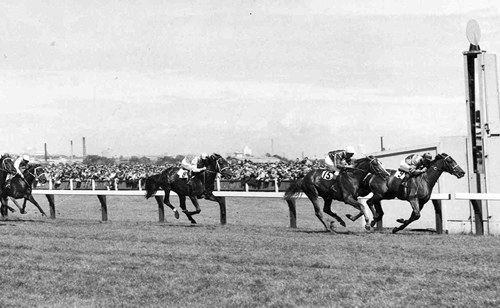
Trainer: Jack Mitchell
Jockey: Noel L. McGrowdie
Silks: Red, Yellow Quarters

The New Zealand-bred Straight Draw, raced by the Sydney newspaper proprietor Ezra Norton, won the 1957 Melbourne Cup after winning the AJC Metropolitan Handicap, but it was the 3YO Tulloch who commanded all the newspaper headlines. Touted as the next Phar Lap, Tulloch was trained by T.J. Smith and had already won the Rosehill and Canterbury Guineas, the Caulfield Cup and the Victoria Derby. His ultimate career tally would be 36 wins from 53 starts. Controversially his owner elected not to start Tulloch in the 1957 race, to the public dismay of the trainer. The horse he beat in the Derby by eight lengths, Prince Darius, finished second by a neck to Straight Draw in the Cup. Illness kept Tulloch out of contention for future Melbourne Cups until 1960, late in his career, when he failed under a heavy weight. Jack Mitchell had been training horses at Randwick since the 1930s. Queensland-born Noel McGrowdie had become one of Sydney’s top riders. He lost his life in a road accident in Malaya four years later.
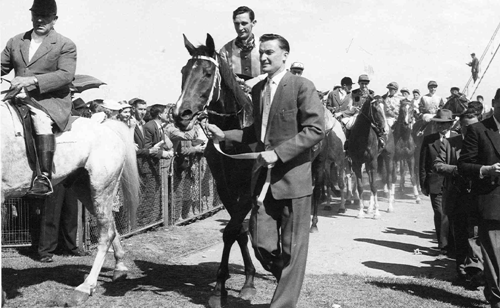
Trainer: Jack Green
Jockey: Mel Schumacher
Silks: Lilac And Dark Blue Stripes, Red Cap

For the fourth successive year it was a Randwick trainer—this time Jack Green—who prepared the winner of the Melbourne Cup. Green also found success with sprinters, notably Sky High and Skyline, sons of Star Kingdom. Baystone was always going to be a stayer. Foaled in NSW, he had been bought at the 1954 yearling sales for a modest sum by Narramine grazier and shearing contractor Bob Burns and his sons, Norman and Noel. The gelding showed promise, winning or running places in lesser stakes races in Sydney, Melbourne and Brisbane before being set for the 1958 Melbourne Cup. He started among the favourites after winning the Hotham Handicap three days earlier after a good fourth in the Moonee Valley Cup. Former top Queensland apprentice, based in Sydney, Mel Schumacher, was 21 when he won the race.
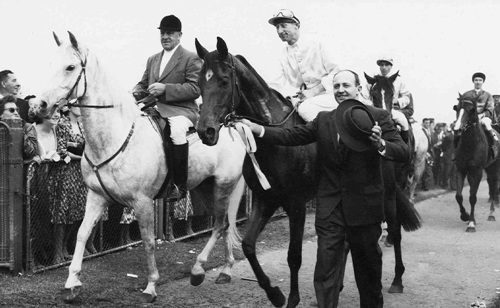
Trainer: Richard (Dick) W. Roden, NSW/QLD
Jockey: Pat Glennon
Silks: White, Pale Blue Maltese Cross, Lilac Cap

Bred by Seton Otway at his Trelawney Stud, New Zealand, Macdougal was hand-reared after the death of his dam, Lady Fox. His name was bestowed in recognition of Helen Macdougal who looked after the orphaned foal. He was sold as yearling to the Brown family of far west Queensland Nonda Station, near Julia Creek. In 1958, under the care of Queensland trainer Dick Roden, Macdougal won the AJC Queen’s Cup at Randwick and in 1959 the Brisbane Cup and The Metropolitan at Randwick before heading to the Melbourne Cup. Roden was 34 at the time but not, as sometimes reported, the youngest trainer to have prepared a Cup winner to that time. In the 1960s he relocated to Sydney and trained on a large scale. Pat Glennon chanced the ride on Macdougal when top jockey Ron Hutchinson preferred the mount on Mackinnon Stakes winner Helios.
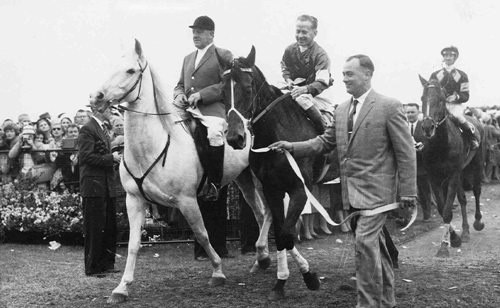
Trainer: Trevor H. Knowles
Jockey: W.A (Billy) Smith
Silks: Maroon, Light Blue Diamonds, Armbands And Cap

It was called ‘The Centenary Melbourne Cup’ but more accurately this was the hundredth running of the race first run in 1861. There had been much fanfare and publicity, but many saw the race as an anti-climax when New Zealand-bred mare Hi Jinx won at odds of 50/1 while favourite and crowd idol, Tulloch, never looked a chance. Tulloch was ridden cautiously by Neville Sellwood and finished seventh. It was the only time in his 53 career starts that he ever finished unplaced. The winning mare’s credentials for the race consisted of a win in the 11 furlong (2212m) Hawkes Bay Cup. Her trainer, Trevor Knowles, had not previously taken horses to Australia. The lightweight jockey, Ballarat-born W.A. Smith, had been riding with success in New Zealand. He returned to make Melbourne his base and in the next several years won many good races, including the 1961 Caulfield Cup on Summer Fair.
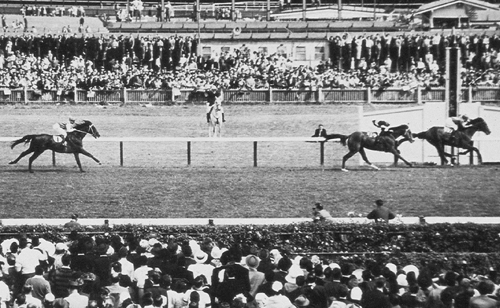
Trainer: Frank B. Lewis
Jockey: Ray Selkrig
Silks: Orange And Green Stripes, Red Cap

Lord Fury, bred in New South Wales, proved to be the most successful of the offspring of his imported Irish sire, Edwardsii, along with 1961 Sydney Cup winner, Sharply. Lord Fury as a 4YO finished third to champion sprinter Sky High in the 1961 Epsom Handicap, but his connections seemed ambitious in aiming for the Caulfield and Melbourne Cups. He was raced by Sydney businessman, Norman Cohen and his wife, Rachel, and trained by Frank Lewis who had begun his training career in Sydney after the Second World War. Having narrowly qualified to run in the Caulfield Cup, and with a light weight, Lord Fury finished an impressive second to Summer Fair. In the Melbourne Cup his Sydney jockey, Ray Selkrig, sent him to the front from the moment the barrier stalls opened. Leaving the straight for the first time, he set up a lead of about four lengths and from that point was never headed, defeating good horses in Grand Print and Dhaulagiri.
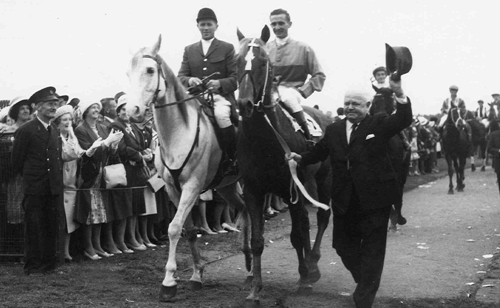
Trainer: Arch McGregor
Jockey: Les Coles
Silks: Gold, Green Band, Red Cap

New Zealand-bred Even Stevens was the first horse to travel by air to Australia and win the Melbourne Cup. His late arrival clearly caught bookmakers off guard. His biggest win beforehand was the Avondale Cup in Auckland, which had never produced a Melbourne Cup winner, so he had been treated lightly by the Australian handicappers. In what became a hit-and-run campaign, he won in succession the Caulfield Cup, Werribee Cup, Melbourne Cup (carrying a 4.5 kg penalty) and the WFA C.B. Fisher Plate in the space of three weeks. Arch McGregor trained the horse for food industrialist Sir James Wattie. In each of his Victorian wins he was ridden by Australian-born Les Coles who had been one of the top jockeys in New Zealand for the past eight years. Coles subsequently returned to Australia permanently. Injury curtailed Even Stevens’s racing career in 1963 and he was retired to the stud.
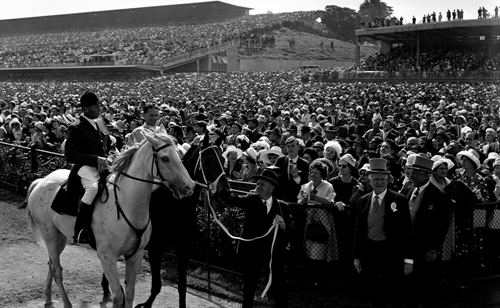
Trainer: Graeme Heagney
Jockey: Jim Johnson
Silks: Gold, Red Cap

Trained in Adelaide by Grahame Heagney, at three years Gatum Gatum won a South Australian Derby and at four he finished second to Sometime in the Caulfield Cup. Winning the Melbourne Cup, he defeated two previous Cup placegetters, horses of quality: the 1960 Caulfield Cup winner, Ilumquh, and Sydney Cup winner, Grand Print. Gatum Gatum went on to further wins including Adelaide’s Labour Day Cup. Twice again he attempted the Melbourne Cup, in 1964 and in 1966. That last time he finished a gallant seventh. His owner-breeder Malcolm Reid also bred 1945 Cup winner Rainbird, raced by his brother Clifford. The win of Gatum Gatum prompted Jim Johnson to relocate from South Australia to Victoria. In 1966–67 he won the title of premier Melbourne jockey. And in 1968 and again in 1969 he won the Melbourne Cup on the Adelaide-trained champion, Rain Lover—owned by Clifford Reid.
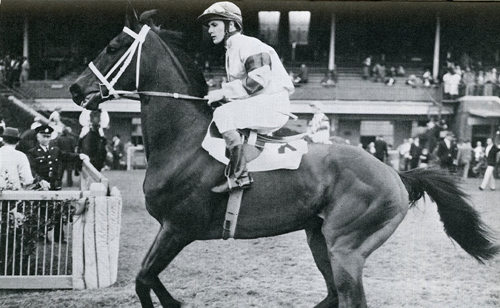
Trainer: John P. Carter
Jockey: Ron Taylor
Silks: Gold, Emerald Green Hooped Sleeves, Emerald Green Cap

Polo Prince was a New Zealand-bred horse by Marco Polo, the sire of 1959 Melbourne Cup winner Macdougal. Owned by Mr and Mrs Laurie Davis who had only recently ventured into horse ownership, he was initially rejected as ‘wayward’ by his first trainer in Auckland and was then sent as a potential hurdler to the Woodville stable of John Carter, a former jumps jockey. Carter saw his potential on the flat. As a 5YO, Polo Prince finished second in both the Wellington Cup and the Auckland Cup, so was then set for the Melbourne Cup. He ran fourth in the Moonee Valley Cup and fourth in the Mackinnon Stakes, before he outstayed his New Zealand rival Elkayel to win the Melbourne Cup. It was jockey Ron Taylor’s first visit to Australia. He said the win changed his life, and he rode with success in New Zealand for the next 20 years. Taylor narrowly missed a second Cup win, beaten on Red Crest by Red Handed in 1967.
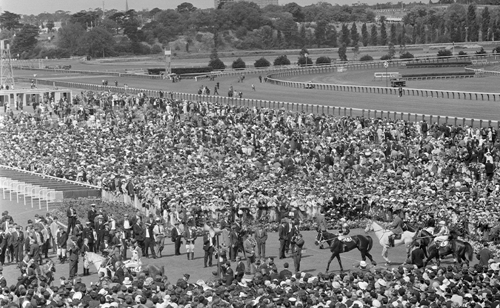
Trainer: J.B (Bart) Cummings
Jockey: Roy Higgins
Silks: White And Royal Blue Spots, Royal Blue Cap

The 4YO mare, New Zealand-bred Light Fingers, became the seventh of her sex to win the Melbourne Cup. Bought as a yearling by Bart Cummings for owner Wally Broderick, she raced entirely in Australia. Before her Cup win, she was already hailed as a rising champion with wins in such 3YO classics as the VRC and the AJC Oaks and the Sandown Guineas, creating a special bond with her regular rider, Roy Higgins. Her victory, defeating her stablemate Ziema in a photo finish, marked the start of trainer Bart Cummings’s run of success in the Melbourne Cup, which would conclude 44 years later with his 12th winner of the race, Viewed. The following year, Light Fingers finished second to another Cummings horse, Galilee, before she won the Sandown Cup.
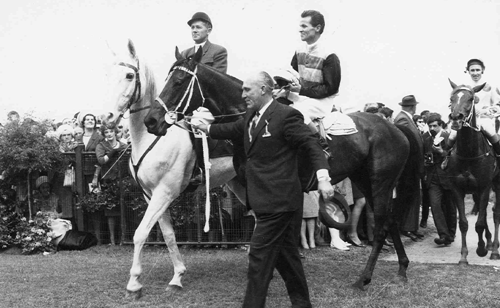
Trainer: J.B (Bart) Cummings
Jockey: John J. Miller
Silks: Gold, Red Hoops, Black Sleeves

Galilee was bred at Trelawney Stud, New Zealand, was selected as a yearling by Bart Cummings and was raced in Australia by Mr and Mrs Max Bailey. When Galilee won the Melbourne Cup, he became only the second horse to win the Toorak Handicap, Caulfield and Melbourne Cups in the one campaign, after The Trump in 1937. He added the Sydney Cup to his list of wins in the autumn of 1966, becoming the first to win the Sydney, Caulfield and Melbourne Cups treble in the one racing season. Bart Cummings trained the quinella for the second year in a row: the previous year’s winner, Light Fingers, was runner-up. Cummings always nominated Galilee as the best stayer he ever trained. John Miller’s long-lasting fame as a jockey was chiefly in his home state of Western Australia, but he rode with success for Cummings in this era.
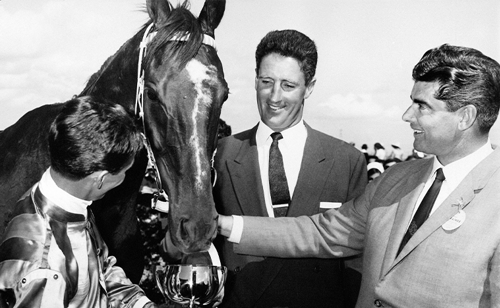
Trainer: J.B (Bart) Cummings
Jockey: Roy Higgins
Silks: Green And Gold Diagonal Stripes, White Cap

It was unprecedented in Melbourne Cup history for the one trainer to win three successive Melbourne Cups. Bart Cummings, still based in South Australia, achieved this treble with the win of Red Handed in 1967. Like Light Fingers, the winner was bred in New Zealand, sired by Le Filou. His pedigree and constitution attracted Cummings at the yearling sales. Following the pattern, he set with Galilee a year earlier, Cummings raced Red Handed in the Toorak Handicap and Caulfield Cup, but the horse was beaten in both by champion Tobin Bronze. A fourth placing in the Mackinnon Stakes was enough to make Red Handed 4/1 equal favourite in the Melbourne Cup. He started from a wide barrier. What was hailed as ‘a magnificent riding display’ by Roy Higgins, culminating in his determination in a close finish, helped cement his position as the champion Melbourne jockey of his time.
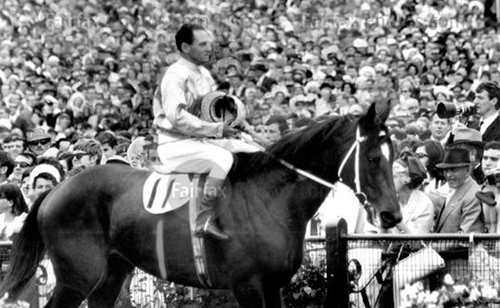
Trainer: Mick L. Robins
Jockey: Jim Johnson
Silks: Gold, White Spots

The South Australian-bred stayer Rain Lover won the two-mile Adelaide Cup as a 3YO in autumn 1968, trained by Grahame Heagney. The trainer had already prepared one Melbourne Cup winner, Gatum Gatum (1963), but the latest star in his stable was middle-distance champion, Tobin Bronze. When Heagney was invited to work with Tobin Bronze in the USA, he was quick to recommend his young stable foreman, Mick Robins, to owner Clifford Reid to take over his stable. By the time the horse won the Melbourne Cup by an astonishing eight lengths, setting a new race record, Robins had held his licence for just four months. The young trainer, who grew up in Broken Hill, remained Rain Lover’s mentor for the rest of the champion’s career. They returned to Flemington to win the Cup again in 1969, former Adelaide jockey Jim Johnson in the saddle on both occasions.
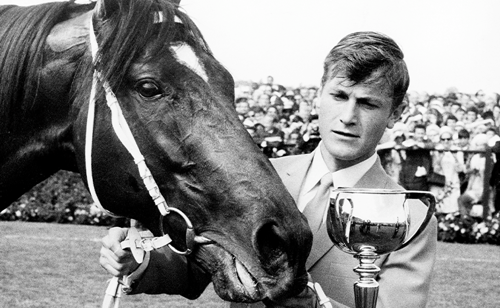
Trainer: Mick L. Robins
Jockey: Jim Johnson
Silks: Gold, White Spots

Much drama surrounded the 1969 Melbourne Cup. Bart Cummings, with three Cup winners in the past four years, had four starters in the race including the favourite, Big Philou, who had recently won the Caulfield Cup after a protest. Then, an hour before Melbourne Cup staring time, Big Philou was withdrawn from the race by order of veterinary stewards. The horse was clearly unwell in his stall, and later was proved to have nobbled by a corrupt stable hand. None of this should diminish the achievement of Rain Lover who won carrying 9 stone 7 pounds (60.3 kg) after fighting off a sustained challenge from Alsop who carried 13 kilograms less on his back. Rain Lover was the first since Archer to win the Cup twice in succession, the first since Peter Pan to win two Cups. For owner Cliff Reid and for jockey Jim Johnson it was a third Melbourne Cup win each. After retirement, Rain Lover became a successful sire.
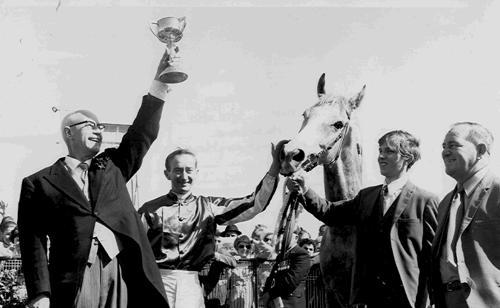
Trainer: Robert (Bob) Heasley
Jockey: Ernie J. (Midge) Didham
Silks: Emerald Green, White Striped Sleeves

Baghdad Note’s win in the Cup was a triumph for the New Zealand South Island city of Dunedin where horse, owner, trainer and jockey all resided. A dead-heat for third in the 1970 Caulfield Cup first drew the attention of Australian racegoers to the grey Baghdad Note. He had previously won the Great Autumn Stakes at Christchurch. In the Cup, Baghdad Note was brilliantly ridden by Midge Didham who was having his first visit to Flemington. Didham made his future career based in Melbourne, riding 1981 Cup runner-up Igloo. Baghdad Note’s owner-breeder, E.C. Stuart Falconer, reportedly had suffered a heart attack some twelve months earlier and his doctor’s advice was that any unnecessary excitement should be avoided at all costs. As Baghdad Note loomed up to the lead with 100 metres to run, Falconer was heard to say ‘steady, steady’! He was referring to himelf, not the horse! Baghdad Note was sold in 1972 and won the 1973 Sandown Cup.
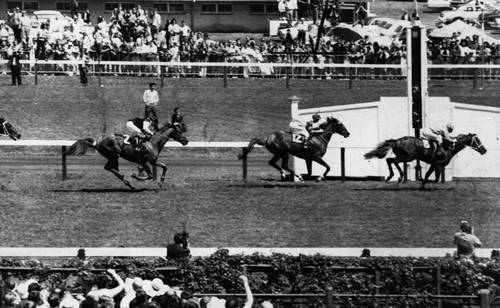
Trainer: Eric Temperton
Jockey: Bruce Marsh
Silks: Cherry, Pink Checks

Silver Knight became the seventh Melbourne Cup winner credited to the Trelawney Stud, New Zealand. By Alcimedes, from the Foxbridge mare Cuban Fox, and raced by Sir Walter Norwood, the grey Silver Knight at three years won Auckland’s Great Northern St Leger and Wellington’s NZ St Leger. A last-minute flight from New Zealand allowed him to reach Melbourne in time to run second in the Mackinnon Stakes before winning the Cup. Eric Temperton had been a top NZ trainer since the 1940s, based at Palmerston North. He and Silver Knight’s jockey, Bruce Marsh, returned to Flemington the following year and nearly won the Cup again with Magnifique. Marsh later enjoyed a long career as a champion trainer in Singapore. Silver Knight was sold after his racing career to Robert Holmes à Court and stood at stud in Western Australia, where he sired Black Knight, winner of the 1984 Cup.
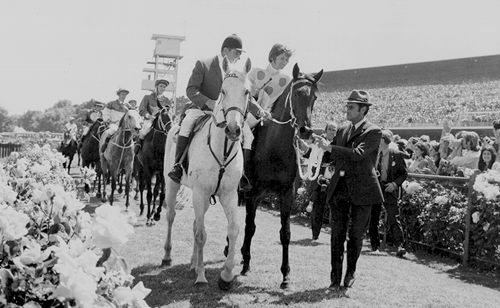
Trainer: George M. Hanlon
Jockey: John Letts
Silks: Yellow, Orange Spots

This was the first ‘metric’ Cup when the two-mile (3218.7m) distance was shortened to 3200 metres. Piping Lane was the first Tasmanian-bred horse to win the Melbourne Cup since Malua back in 1884. Sired by imported Irish-bred Lanesborough, Piping Lane did not race until three years. He strung together wins including the Longford, Devonport and Hobart Cups before being sold to Ray Trinder, a Devonport trainer and amateur rider. Trinder raced him both on the mainland and at home, consistently but without winning, before transferring Piping Lane to the Mordialloc stables of George Hanlon. A third in the Moonee Valley Cup proved his fitness. Hanlon secured the leading Adelaide lightweight John Letts for the ride—Letts had never ridden at Flemington before, and had never met the owner, trainer or horse. At generous odds, Piping Lane surprised his champion opponents Magnifique and Gunsynd, beating them into the minor placings. Letts won the Cup a second time, on Beldale Ball (1980), while Hanlon trained two further winners.
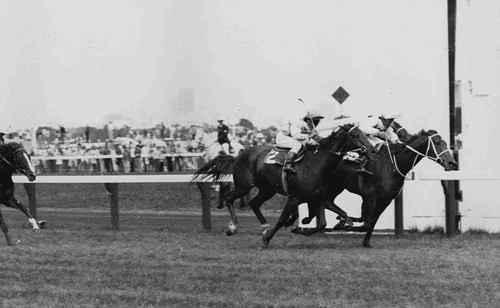
Trainer: Ray Hutchins
Jockey: Frank Reys
Silks: Aqua, Black And White Diamonds, Aqua Sleeves And Cap

Gala Supreme became the first Victorian-bred horse to win the Cup since Wodalla in 1953. His sire, the locally-bred Gala Crest, had won the Herbert Power Handicap before finishing second in the 1966 Caulfield Cup—and Gala Supreme exactly replicated this in 1973. Both horses were owned by studmaster Pat Curtain, and both were trained at Caulfield by Ray Hutchins. And it was Hutchins who encouraged his number one stable jockey, Queensland-born Frank Reys, to return at the age of 41 from serious injuries after a sequence of bad accidents, to ride the stable’s hope in the Melbourne Cup. Reys is now recognised as the first Indigenous Australian jockey to have won the Cup. After the race, he was unashamedly emotional, delivering a long, heartfelt speech. ‘I kept picking myself up off the ground and hoping I would win a Melbourne Cup,’ he said. ‘It’s something that every Australian jockey dreams about.’
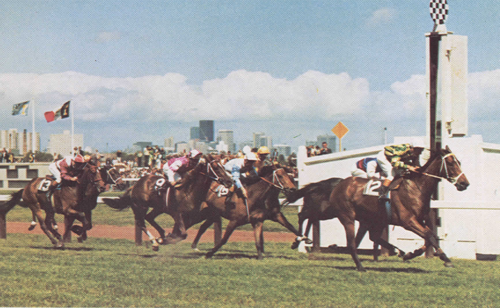
Trainer: J.B (Bart) Cummings
Jockey: Harry White
Silks: Green And Gold Diagonal Stripes, White Cap

After training three successive Melbourne Cup winners in the 1960s, Adelaide trainer Bart Cummings was dubbed ‘The Cups King’, and he was starting to think big. He would soon establish stables in Melbourne and Sydney. Any horse he started in a Melbourne Cup was followed by racegoers with interest. As with his first three winners, Think Big was bred in New Zealand, secured as a yearling by Cummings and sold to Mr C.N. Tan, better known later in Australia as Dato Tan Chin Nam, who ended up as owner or part-owner of four Melbourne Cup winners trained by Cummings. Tan sold a share to Ric O’Sullivan of Brisbane. Think Big’s win came at the expense of his stablemate, the popular mare Leilani. The trainer’s horses had finished first and second in the Cup race for the third time. For jockey Harry White it would be the first of four Melbourne Cup wins.
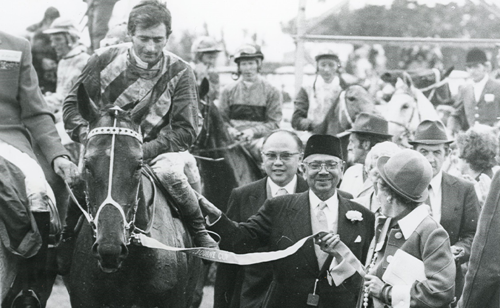
Trainer: J.B (Bart) Cummings
Jockey: Harry White
Silks: Green, Gold Diagonal Stripes, Red Sleeves And Cap

It had taken 107 years for Archer’s record of two consecutive Melbourne Cup victories to be equalled, by Rain Lover with his 1969 victory. Six years later Think Big replicated the feat—in his case, without winning a single race since his 1974 Cup win. The previous year he had come into the Melbourne Cup with a sharp win three days earlier in the Hotham Handicap. This year his best run was a third in the Caulfield Stakes in October, but the wet conditions on Cup Day suited him well and he just outlasted his stablemate, Holiday Waggon. Other records were set: Cummings now had five Cup wins, equalling the de Mestre stable’s tally in the 19th century. He had quinellaed the race for a fourth time. Jockey Harry White now had a second Melbourne Cup win. Also present to celebrate the win was former Malaysian Prime Minister, Tunku Abdul Rahman, now a part owner with Dato Tan Chin Nam and Ric O’Sullivan.
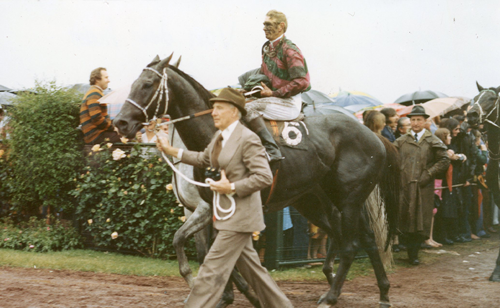
Trainer: Leonard (Leo) H. Robinson
Jockey: Robert (Bob) J. Skelton
Silks: Cerise, Green Diagonal Stripes, Armbands And Cap

Melbourne’s changeable climate was at its worst on Melbourne Cup Day 1976, with torrential rain falling overnight on Cup Eve and persistent showers continuing. The track was deemed safe enough and then, just prior to the race, the heavens opened again. After a delay, the race began in the rain. New Zealand gelding Van Der Hum had good recent form after coming to Victoria, running third in the Caulfield Cup, and was known to like heavy tracks. He was ridden by the experienced New Zealand jockey, Bob Skelton, and was backed heavily accordingly. Racecallers struggled to distinguish the jockeys’ colours in the conditions, and horses and riders returned to scale spattered with mud—none happier than Skelton. In New Zealand the horse was trained and part-owned by the brothers Roy and Leo Robinson, but Van Der Hum was raced in Australia under L.H. Robinson’s care. Runner-up in the race, Gold And Black, had to wait his turn until the following year.
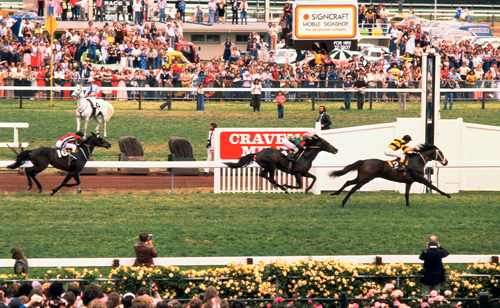
Trainer: J.B (Bart) Cummings
Jockey: John Duggan
Silks: Gold And Black Hoops, Black Cap

With his sixth Melbourne Cup victory, Bart Cummings now held the record for the most wins in the race as a trainer—all with New Zealand-bred horses. Ridden by Sydney jockey John Duggan, Gold And Black made up for his second place in the previous year’s Cup. Indeed, jockey Duggan had finished second in the past two Cups. While Gold And Black was equal favourite for the race, the sentimental favourite was the Tommy Woodcock-trained Reckless who had won the Adelaide, Sydney and Brisbane Cups in the previous twelve months. Woodcock, now a veteran in his 70s, had found unsought fame decades earlier as ‘Phar Lap’s strapper’, the groom with a special bond with the champion. Reckless, too, was evidence of his rapport with racehorses. The race concluded with a tussle to the line. John Duggan lifted Gold And Black in the closing stages to win by a length.
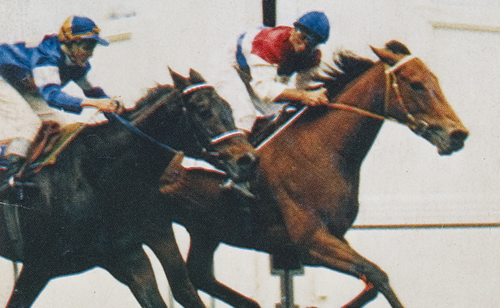
Trainer: George M. Hanlon
Jockey: Harry White
Silks: Red And White Halves, Royal Blue Sash And Cap

Arwon had several owners and trainers, and even a different name, before he came to trainer George Hanlon. In New Zealand he raced as Flash Guy until purchased by an Australian syndicate on the recommendation of veteran Canberra jockey, Ted Doon. There was already an Australian ‘Flash Guy’. The new trainer was Paul Sutherland at Nowra, hence the new name—Nowra, backwards. Nothing backward about this horse: his connections transferred him to John Morrisey at Canberra, for whom he registered impressive wins in Canberra and Sydney, ridden by Doon. With dreams of a Melbourne Cup, the owners transferred him to Hanlon in early in 1978. For Hanlon he had an outstanding spring, winning the Seymour Cup and the Herbert Power. He was narrowly defeated in The Metropolitan and nosed out of first place in the Caulfield Cup. Harry White took the mount, finishing fifth in the Mackinnon before his strong win in the Melbourne Cup. Arwon continued racing, placed in a Sydney and a Perth Cup, and winning the 1980 Sandown Cup. Hanlon gave the gelding a home in retirement.
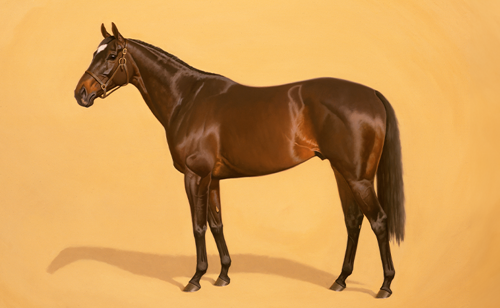
Trainer: J.B (Bart) Cummings
Jockey: Harry White
Silks: Pink, Lime Green And Navy Blue Striped Sleeves, Lime Green Cap

Hyperno was one of the most talented horses racing in Australia in his era. He also had the reputation of a rogue. His racing career extended from 1977, when he finished third in the Melbourne Cup, to 1981 when he was voted Australian Horse of the Year. Caulfield trainer Geoff Murphy bought him at the 1975 New Zealand yearling sales for a group of Melbourne owners and prepared the horse until the spring of 1979 when he was transferred to Bart Cummings, giving Cummings his seventh Cup win as trainer. It was the narrowest of photo finish wins, over Salamander, ridden by Roy Higgins, who had turned down the chance to ride Hyperno in the race. For Harry White it became his fourth Cup win, equalling the jockey record for most winners, set by Bobbie Lewis early in the century.
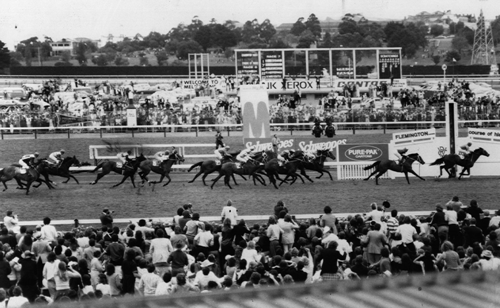
Trainer: Colin Hayes
Jockey: John Letts
Silks: Emerald Green, Royal Blue Sleeves, Red Cap, Emerald Green Spots

Englishman Robert Sangster, co-founder of the internationally famous Coolmore Stud, was in the 1980s was one of the world’s biggest racehorse owners as manager of the Swettenham Stud syndicate. He had already won the English Derby in 1975 with The Minstrel, but it was the Melbourne Cup win of his American-bred horse Beldale Ball that convinced him of the magic of Flemington on the First Tuesday in November. Sangster had sent Beldale Ball, after racing in England, to be prepared by Adelaide trainer Colin Hayes expressly for the 1980 Melbourne Cup. Hayes was at the top of his profession, but luck had previously eluded him in the Cup. It was the first time since Backwood (1924) that a northern hemisphere horse had won the Cup, albeit with an Australian trainer. Adelaide champion John Letts took the ride to give him his second Melbourne Cup win. Beldale Ball later stood at stud in Czechoslovakia.
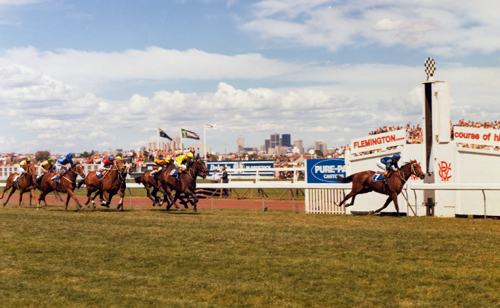
Trainer: T.J (Tommy) Smith
Jockey: Peter Cook
Silks: Royal Blue And Green Stripes, Royal Blue Cap

T.J. Smith had been the premier trainer in Sydney every season since 1952–53, but it was 26 years for him between Melbourne Cup drinks. His previous winner had been Toparoa in 1955. Just A Dash, bred by Olympic equestrian Neale Lavis at his Strathallan Stud, Braidwood NSW, was the first racetrack winner for his sire, Whiskey Road. He was sold cheaply as a yearling to Wagga publican, Gary Towzell who later sold the horse after a good third in the AJC St Leger. Just A Dash entered the Smith stable and won the South Australian St Leger and the Adelaide Cup before his Melbourne Cup success. At Flemington he was ridden by Sydney jockey Peter Cook, son of Billy Cook who won the Cup in 1941 and 1945. It was the first Melbourne Cup in which Lloyd Williams was a part owner. In time he would set the record as the most successful owner in Cup history.
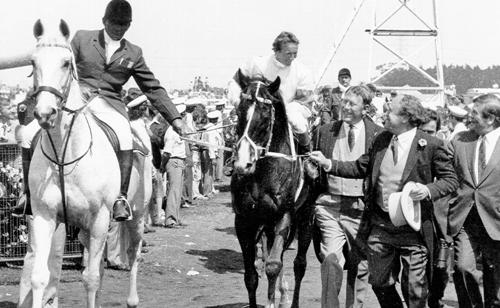
Trainer: Geoff Murphy
Jockey: L. (Mick) Dittman
Silks: Royal Blue, Gold Armbands And Cap

Luck turned for Caulfield trainer Geoff Murphy when Gurner’s Lane won the 1982 Cup. Murphy had been the original trainer of Hyperno (1979 Cup) before the horse was switched to the stables of Bart Cummings just months before the race. Seventeen days before the 1982 Melbourne Cup, Gurner’s Lane won the Caulfield Cup and he went into the Melbourne Cup an 8/1 chance. Between him and destiny stood Kingston Town, one of Australia’s greatest ever racehorses. The two fought out the finish. Kingston Town seemingly just failed to last the 3200 metre distance. The speculation never ceased: had top jockey Malcolm Johnston misjudged his ride, taking off for the finishing line just too early? Johnston rejected the theory. Queensland jockey Mick Dittman rode Gurner’s Lane with his customary vigour to claim the prize. The horse took his name from a laneway behind Melbourne’s Australian Club. A syndicate of club members raced the winner.
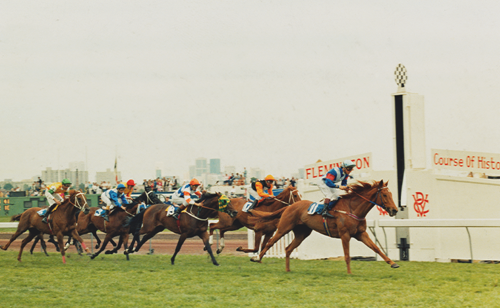
Trainer: Ewen ‘Snow’ Lupton
Jockey: Jim Cassidy
Silks: Royal Blue, White Crossed Sashes, Red Armbands, Light Blue Cap

Coming from last place in the running to first at the winning post is rare in Melbourne Cups. In 1983 this was done with such speed and finesse from so far back that for years afterwards a last-to-first in a race was dubbed ‘doing a Kiwi’. The leading New Zealand apprentice of his day, Jim Cassidy (20 at the time) teamed with trainer Snow Lupton for the horse’s first visit to Flemington. The team had used the same last-to-first tactics nine months earlier to win the Wellington Cup. Cassidy’s audacious riding career, with its highs and lows, continued in Australia until 2015 with more than 100 Group 1 race wins to his credit and a place in both the New Zealand and the Australian Racing Hall of Fame. His second Melbourne Cup victory came in 1997 on Might And Power when he went to the front early and led all the way home.
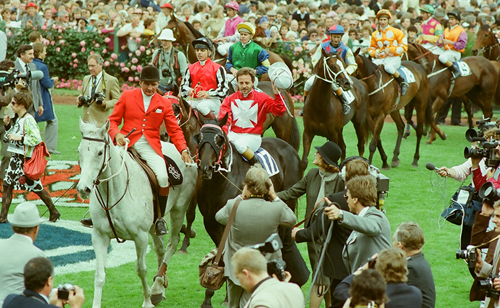
Trainer: George M. Hanlon
Jockey: Peter Cook
Silks: Maroon, White Maltese Cross And Cap

The success of Black Knight in the Melbourne Cup was a personal and professional triumph for his owner, international businessman Robert Holmes à Court. He had bought the 1971 Cup winner Silver Knight as foundation stallion for his Heytesbury Stud near Perth, and the dam, Brenta, was the stud’s first broodmare. Trained in Victoria by George Hanlon, who already had two Melbourne Cup winners to his credit, Black Knight showed his class with a narrow second to Chagemar in a fast-run Geelong Cup. After a good third in the Dalgety (Hotham) Handicap, Black Knight turned the tables on Chagemar for an easy win in the Cup. Sydney’s Peter Cook scored his second Melbourne Cup win. With Holmes à Court absent in London on business, but tuned in to the broadcast, his wife Janet received the Cup trophy.
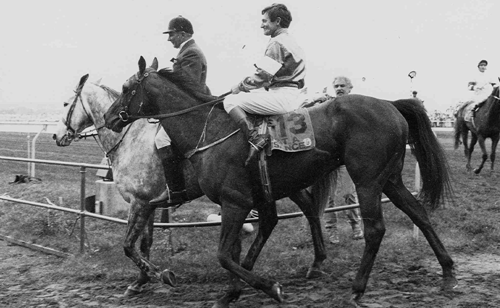
Trainer: John Meagher
Jockey: Pat Hyland
Silks: Navy Blue, White Armbands And Cap

History was made in 1985 when the race was commercially sponsored as the ‘Fosters Melbourne Cup’, with prize money lifted to $1 million. The Prince and Princess of Wales, Charles and Diana, were special guests on the day, the Prince presenting the trophy to owners, Lloyd Williams and Dennis Gowing. As so often in the past few decades, the winner was New Zealand-bred, brought to Australia under trainer cousins Graeme and Len Rogerson and intended for a jumping career. Instead, he won four of his next seven starts on the flat, then took the 1984 Duke of Norfolk Stakes at Flemington over the Melbourne Cup course and distance. Later that year he was transferred to the stable of rising trainer John Meagher who nursed the horse through a long list of ailments to have him fit for the 1985 Cup. Also recovering from injury was jockey Pat Hyland who took the winning ride at the age of 43.
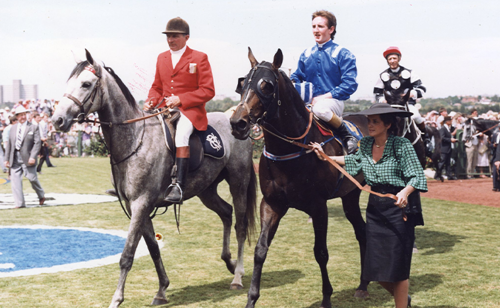
Trainer: Colin S. Hayes
Jockey: Michael Clarke
Silks: Royal Blue, White Epaulettes, Striped Cap

A precedent had been set when champion Adelaide trainer Colin Hayes prepared a tried northern hemisphere racehorse to win the 1980 Melbourne Cup. Six years later he repeated the achievement, with the American-bred At Talaq. Sheikh Hamdan bin Rahid Al Maktoum had paid US$800,000 for the colt at the 1982 Saratoga yearling sales and sent him to race in England. In 1984 At Talaq won the Grade 1 Grand Prix de Paris and was placed in the German and the Italian Derbys. The plan was then formulated to send him to Australia. Under Hayes, he ran a series of second placings in good races including the Caulfield Cup before winning the Mackinnon Stakes and then the Melbourne Cup, ridden by Hayes’s number one stable jockey, Michael Clarke. At Talaq remained in the country, running second to Bonecrusher in the 1987 Australian Cup, before embarking on a successful stud career.
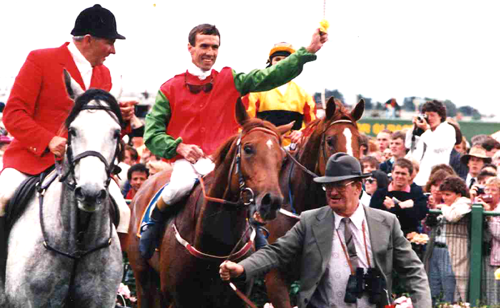
Trainer: Les J. Bridge
Jockey: Larry Olsen
Silks: Red, Green Sleeves

Kensei was New Zealand-bred, sired by US-bred Blarney Kiss who had previously sired 1983 Melbourne Cup winner, Kiwi. Kensei was bought cheaply at New Zealand yearling sales and became the first commercially syndicated horse to win the Melbourne Cup, in an ownership group of just six, promoted by Harry Lawton. Trained in Sydney first by former jockey Neville Voigt, then by Les Bridge, Kensei showed his ability with wins in the regional Grafton and Newcastle Cups and a good second in The Metropolitan ahead of his Melbourne Cup victory. For Queensland jockey Larry Olsen it was a miraculous comeback after a three-year retirement from the saddle. New Zealand mare Empire Rose arrived for a hit-and-run attempt at the race, finishing second, foreshadowing a successful return in 1988. One more piece of history: the Sydney based New Zealander Maree Lyndon rode Argonaut Style to become the first woman jockey to compete in a Melbourne Cup but finished second-last.
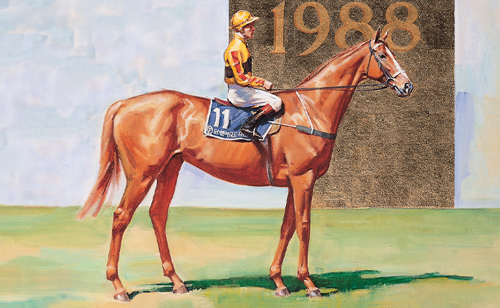
Trainer: Laurie Laxon
Jockey: Tony Allan
Silks: Yellow, Black Band, Red Striped Sleeves

After Empire Rose finished fifth in the 1986 Melbourne Cup behind At Talaq and then lost the 1987 Cup by less than half a length to Kensei, it seemed fitting that she should succeed at last. A huge mare who was so long that she had trouble fitting into the starting stalls, Empire Rose secured the 1988 Cup after winning the Mackinnon Stakes the Saturday before. By Sir Tristram, like Gurner’s Lane (1982) and Brew (2000), Empire Rose won the Cup by a half head from Natski. From a wide gate, New Zealand jockey Tony Allan was able to get the big mare across and give her the run of the race. Among other career highlights for Empire Rose were her win in the 1987 New Zealand Cup and a third place behind Almaarad in the 1989 Cox Plate. Trainer Laxon later moved from New Zealand to Singapore where for nine seasons he was premier trainer.
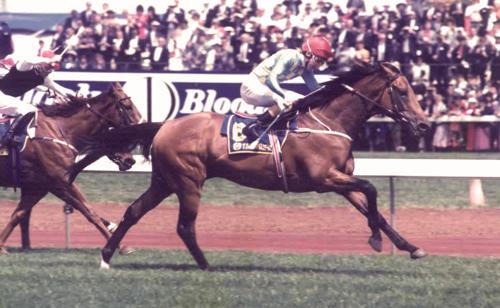
Trainer: Lee Freedman
Jockey: Shane Dye
Silks: Pale Blue, Yellow Checks, Red Cap

While Bart Cummings by now had seven Melbourne Cups to his credit as trainer, a new rival emerged. Lee Freedman, 33 at the time, was the registered trainer of the winner, Tawrrific, but he acknowledged the support of his brothers Richard, Anthony and Michael. His late father, Tony, had trained horses in NSW and his great-grandfather W.H. ‘Midge’ McLachlan, a champion international jockey, had ridden three Melbourne Cup winners early in the century. New Zealand-bred Tawrrific (his name a spelling puzzle, a son of Tawfiq) showed promise as a stayer in good races in Melbourne, Sydney and Brisbane in 1988–89 before winning the AJC St Leger and then the Melbourne Cup, beating his talented stablemate, Super Impose. Effervescent Sydney jockey Shane Dye took the winning ride after top Melbourne rider Darren Gauci opted for Super Impose.
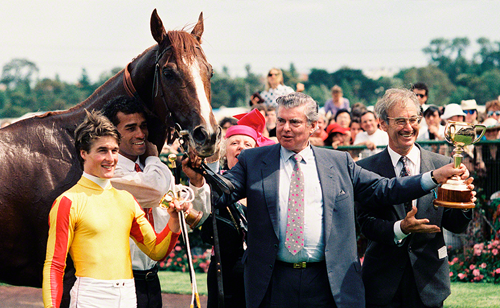
Trainer: J.B (Bart) Cummings
Jockey: Darren Beadman
Silks: Yellow, Red Striped Sleeves And Cap

Kingston Rule was arguably the best-bred horse ever to win the Cup. He was certainly the fastest, and the record time of 3 minutes 16.3 seconds has stayed in the record books. He was Bart Cummings’s eighth winner as trainer and his first not to be a New Zealander. His owner-breeders, David and Helen Hains, had raced the champion dam, Rose of Kingston, winner of the VRC Oaks and AJC Derby, and sent her to the US to the great Secretariat, the 1973 Triple Crown winner. Kingston Rule, a handsome chestnut, was lightly raced in his career, winning the Moonee Valley Cup and second in the Dalgety (Hotham Handicap) ahead of his Melbourne Cup win. He retired to the stud in Victoria in 1991 producing many winners, the best Kensington Palace which won a VRC Oaks. Emerging champion jockey Darren Beadman won a second Melbourne Cup for Cummings in 1996 on Saintly.
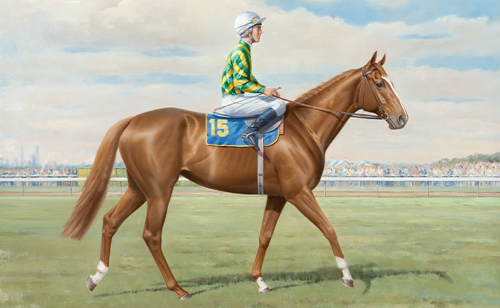
Trainer: J.B (Bart) Cummings
Jockey: Steven King
Silks: Green And Gold Diagonal Stripes, White Cap

In winning the Melbourne Cup, Let’s Elope became the eighth horse and only the second mare to win the Caulfield-Melbourne Cup double, the eighth female to win the Melbourne Cup, and the ninth Cup winner for trainer Bart Cummings. Arriving in Australian as a 4YO in September after wins in New Zealand, Let’s Elope joined the Cummings stable and became Melbourne’s boom horse in the spring. She won the Turnbull Stakes, Caulfield Cup and Mackinnon Stakes before her victory in the Cup. Winning jockey, Steven King, was 23 when he rode the winner and established himself as one of Melbourne’s best jockeys. For a fifth time, Cummings had trained the Cup quinella. In a unique twist, Shane Dye who rode the runner-up, Shiva’s Revenge, protested (unsuccessfully) against the stablemate on the grounds of interference. Let’s Elope went on to win the 1992 Australian Cup. She was exported to race in the USA, three times placed in Grade 1 races, before later returning to the stud in Australia, where she produced Adelaide Cup winner, Outback Joe.
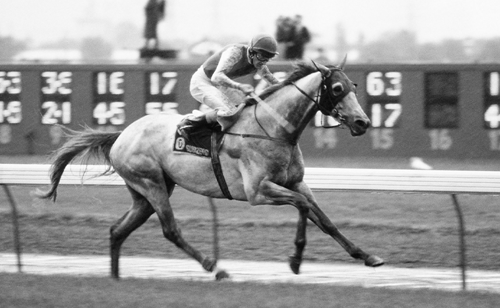
Trainer: Lee Freedman
Jockey: Greg Hall
Silks: Red, Purple Sash, White Sleeves, Purple Cap

Subzero was a good NSW-bred grey gelding whose biggest wins were the South Australian Derby and the Adelaide Cup ahead of his victory on a wet track in the 1992 Melbourne Cup. Yet he became one of the best-loved Melbourne Cup winners of his era, chiefly because of his career after retirement from racing. As his coat turned white, he first became a clerk of the course’s mount for Graeme Salisbury who then trained him for a public career. ‘Subbie’ became a familiar figure across community activities, including the Lexus Melbourne Cup Tour, visiting schools and hospitals, even promoting Australian horse racing internationally. His death from old age in 2020 was widely mourned. In his Cup win he was skilfully ridden by top jockey Greg Hall to beat two outstanding New Zealanders, Veandercross and Castletown. It was trainer Lee Freedman’s second of five Melbourne Cup wins.
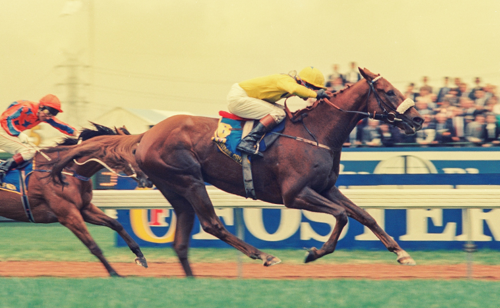
Trainer: Dermot Weld
Jockey: Michael Kinane
Silks: Yellow, Royal Blue Epaulettes, Star Cap

It has been called the ‘internationalisation of the Melbourne Cup’. Imported horses, beyond New Zealand, had won earlier Cups, but this was the first time that horses from the northern hemisphere, together with their trainers and riders, had flown in just to contest the race. Vintage Crop, trained by Dermot Weld and ridden by Michael Kinane, came to Melbourne in company with England’s Drum Taps, ridden by Frankie Dettori. Vintage Crop had been bred in England, by American breeders. His previous wins included England’s Cesarewitch Handicap, the Irish St Leger and the Curragh Cup. Modified quarantine regulations in Australia and faster flights had made the concept possible, but to win was a great achievement. Drum Taps weakened to finish midfield. Weld returned with Vintage Crop in 1995 who ran third to Doriemus, and the trainer won the Cup again with Media Puzzle in 2002. Kinane’s riding career saw him 13 times Irish champion jockey. He won many top international races including the English Derby three times.
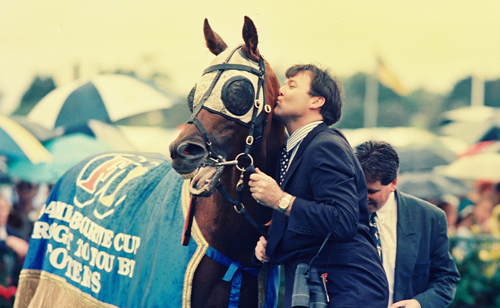
Trainer: David A. Hayes
Jockey: Wayne Harris
Silks: Royal Blue, White Epaulettes, Striped Cap

Following the pattern he set with At Talaq in 1986, owner Sheikh Hamdan bin Rashid Al Maktoum sent the accomplished racehorse Jeune from England to be acclimatised in Australia and to be locally trained with the Melbourne Cup in mind. English-bred Jeune had already won black type races, notably the Hardwicke Stakes at Ascot, trained by Geoff Wragg. In Australia the horse was trained by David Hayes who had just taken over the training operation of his father, Colin Hayes, mentor of At Talaq. By spring 1994, Jeune was competing near his best, including winning the Group 1 Underwoood Stakes, before winning the Melbourne Cup on a soft track. Sydney jockey Wayne Harris had overcome many physical setbacks in his career, and he won the race with a skilful ride beating regular rival Paris Lane. Jeune remained in Australia, maintaining his good form, voted Horse of the Year 1994–95, before being retired to the stud.
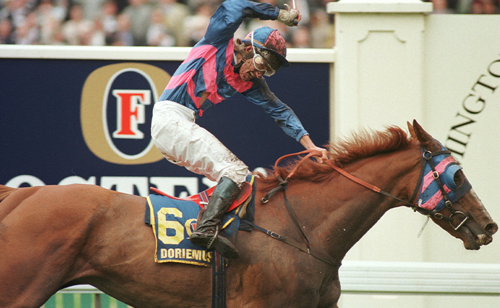
Trainer: Lee Freedman
Jockey: Damien Oliver
Silks: Dark Blue, Pink Hoops, Quartered Cap

The New Zealand-bred gelding Doriemus became the ninth horse to win the Caulfield-Melbourne Cup double. He first raced in New Zealand before being sold to an Australian partnership of owners. He showed promise as a 3YO and later in 1994 he placed third in the Sandown Cup. The following spring, he showed consistent improvement to win the Caulfield Cup. Suited by wet conditions and an outside barrier draw, he then won the Melbourne Cup, becoming the third winner of the race to be trained by Lee Freedman. Victoria Derby winner Nothin’ Leica Dane finished second, 1993 winner Vintage Crop third. It was the first Cup win for rising champion jockey Damien Oliver, 23 at the time, who had recently relocated to Melbourne from Western Australia. Doriemus came so close to replicating his 1995 triumph with second placings in both Cups in 1997 to Might and Power.
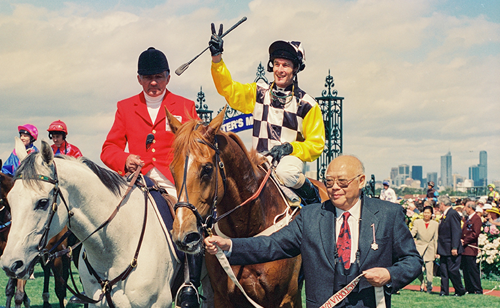
Trainer: J.B (Bart) Cummings
Jockey: Darren Beadman
Silks: Black, White Checks, Yellow Sleeves, Checked Cap

Saintly became Bart Cumming’s tenth winner of a Melbourne Cup, but this one differed from all the rest. For the first time this was an Australian-bred horse, and Cummings was the official breeder. He was also part-owner with Dato Tan Chin Nam who had raced Think Big, winner of the 1974 and 1975 Cups. Saintly helped Cummings recover from serious financial reverses arising from a failed syndication enterprise earlier in the decade. His horse was a true champion, quickly dubbed the ‘horse from heaven’. Saintly’s wins including the 1996 Australian Cup and Cox Plate, and he was a close runner-up in several big races to regular rival, Octagonal. It was Sydney champion jockey Darren Beadman’s second Cup win, both of them for Cummings. To mark Bart’s tenth Cup victory, VRC Chairman Peter Armytage presented the trainer with a full-size version of the Melbourne Cup trophy. Only twice in 23 career starts was Saintly unplaced.
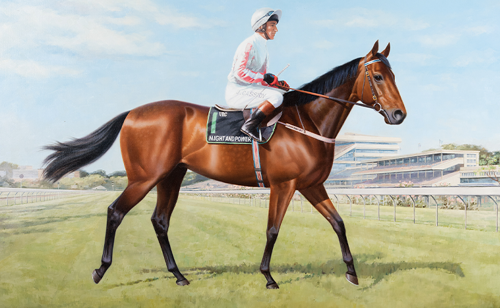
Trainer: Jack Denham
Jockey: Jim Cassidy
Silks: White, Grey Sash, Pink Striped Sleeves, Grey Cap

Might And Power’s victory over Doriemus by the absolute narrowest of margins—a short half head—was the achievement of a great racehorse. Jockey Jim Cassidy, who in 1983 had ridden New Zealand horse Kiwi to victory from the tail of the field, allowed Might And Power to lead throughout the race. Using similar tactics, the horse had blitzed the field to win his previous start, the Caulfield Cup, by many lengths. In the Melbourne Cup, with 200 metres to run, the 1995 winner Doriemus, under the hard riding of Greg Hall, was slowly but surely pegging Might And Power back. On the line it was so close that Hall thought he had won. The photo finish proved otherwise. Might And Power was a New Zealand-bred gelding prepared by veteran Sydney trainer Jack Denman. He went on to win seven more Group 1 races including the 1998 Cox Plate.
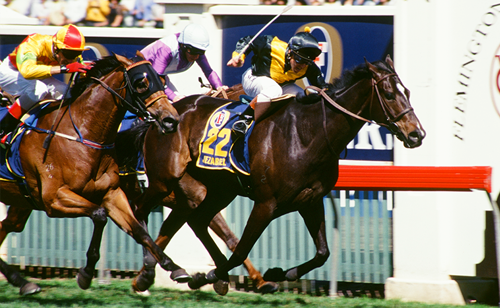
Trainer: Brian Jenkins
Jockey: Chris Munce
Silks: Dark Green, Gold Vee, Cuffs And Pom Pom

The Auckland Cup was first run in 1874 and many champions had won the 3200 metre race, but Jezabeel became the first to win the Auckland–Melbourne Cup double, in 1998. Her trainer and part-owner, Brian Jenkins, came from a racing family and trained the mare at Cambridge on the North Island. She won her first two starts as a 2YO including the Champagne Stakes at Ellerslie and had one unsuccessful foray to Victoria as a 3YO filly. By five years she was showing promise as a stayer and she returned to Melbourne with Jenkins in the winter of 1998 with the Melbourne Cup as her target. Unlucky in the Caulfield Cup, where she finished sixth, she defeated fellow New Zealand mare Champagne in the Melbourne Cup, where she was ridden by Queensland jockey, Chris Munce. The champion Irish-bred English stayer Persian Punch finished third, as he did again in 2001.
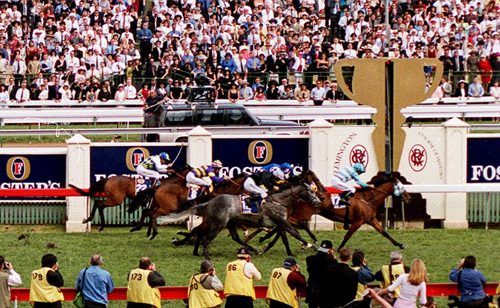
Trainer: J.B (Bart) Cummings
Jockey: John Marshall
Silks: Turquoise, White Hoops

In the long history of the Melbourne Cup, Rogan Josh was just the second winner to have been bred in Western Australia, after Black Knight (1984). Four wins in his first five starts were at regional Bunbury when he was trained by Marcus Forrest who with his father, Tom, was the breeder. Transferred to the Perth stables of Colin Webster, his next wins included the Pinjarra and Bunbury Cups before his close second placing in the Perth Cup on New Year’s Day 1999. By mid-year he went to the Melbourne stables of Bart Cummings. Consistent form propelled him to favouritism for the Melbourne Cup where he was ridden by West Australian-born jockey John Marshall, late in his distinguished riding career. It was the eleventh Cup win for Cummings. Owner Wendy Green, Tom Forrest’s daughter, was a schoolteacher in Darwin and famously made the journey to Melbourne by car, and returned home with the trophy in the boot, stopping to share her triumph with well-wishers along the way.
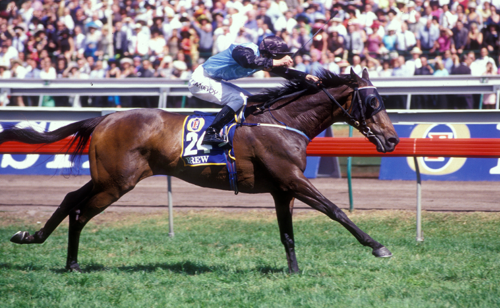
Trainer: Mike Moroney
Jockey: Kerrin McEvoy
Silks: Light Blue, Black Sleeves And Cap

New Zealand-bred Brew was a son of the champion multiple-Group 1 winning mare Horlicks who had a Japan Cup victory to her credit. After two New Zealand starts, Brew raced entirely in Australia where he recorded seven wins and 11 placings. For most of that career he was trained in Victoria by former New Zealander Mike Maroney whose brother, Paul, became a part-owner. Also among the owners was Andrew Ramsden, the VRC Chairman at the time, as manager of Gurner’s Bloodstock. He had been part of the syndicate who raced 1982 Cup winner, Gurner’s Lane. Brew finished tenth in the 1999 Cup but his form was better the following year. He won his way into the 2000 Cup with a win in the Saab Quality (former Hotham Handicap). It was the first Cup win for future champion jockey Kerrin McEvoy of South Australia, who was 20 at the time.
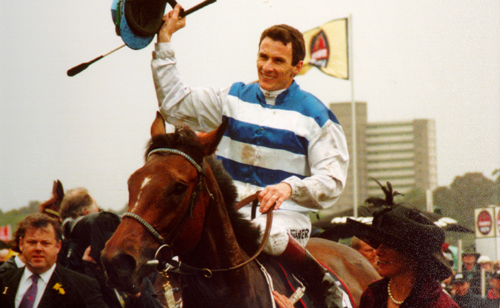
Trainer: Sheila Laxon
Jockey: Scott Seamer
Silks: Dark Blue, White Hoops, Silver Sleeves, Quartered Cap

Cup Day in 2001 was full of drama with rain falling in the 24 hours leading into the race. Ethereal’s owners considered scratching their horse and it was only quick talking by Queensland jockey, Scott Seamer, and former top rider, Brent Thomson, that ensured Ethereal took her place. The New Zealand mare was bred and raced by brothers Peter and Paul Vela and trained by Welsh-born Sheila Laxon, former wife of Laurie Laxon who had trained 1988 Cup winner, Empire Rose. With four wins from nine New Zealand starts as a 3YO, Ethereal went to Brisbane in mid-2001 and won the Queensland Oaks, ridden by Scott Seamer. In the spring they won the Caulfield Cup–Melbourne Cup double. While acknowledging the achievement of New Zealand trainer Hedwick ‘Granny’ McDonald in preparing the 1938 winner Catalogue, Sheila Laxon proudly entered the record books as the first woman officially to train the winner of a Melbourne Cup. In 2002 Ethereal won her final race, the Group 1 BMW in Sydney.
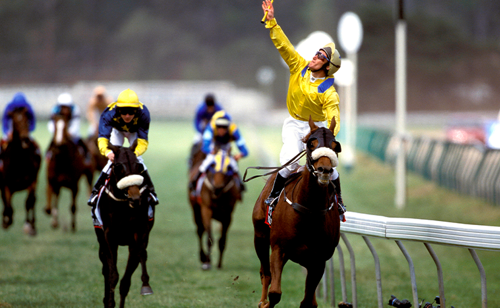
Trainer: Dermot K. Weld
Jockey: Damien Oliver
Silks: Yellow, Royal Blue Epaulettes, Star Cap

It was one of the great moments in sporting history: jockey Damien Oliver rose above all challenges to secure the 2002 Melbourne Cup aboard Media Puzzle. He had lost his brother, Jason, seven days earlier in a racing accident in Perth, and Damien rode under great personal duress on Derby Day and then Cup Day. But as if the script had been written, Damien Oliver rode the race of his life aboard the Irish-trained invader, Media Puzzle, to record his second Cup victory. It was owner Dr Michael Smurfit and trainer Dermot Weld’s second Cup win, too, after Vintage Crop in 1993, and the first northern hemisphere winner since then. Media Puzzle’s prior form in Ireland had not been as strong as Vintage Crop’s had been, but he won his way into contention with a good win in the Geelong Cup ahead of the Melbourne Cup. The story was later told in a successful book and movie called simply ‘The Cup’.
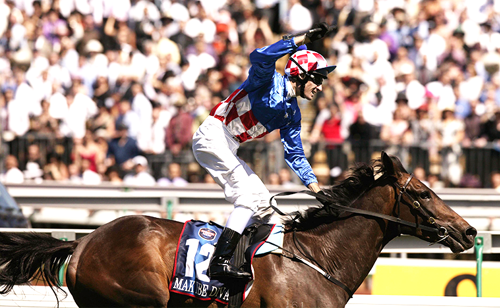
Trainer: David Hall
Jockey: Glen Boss
Silks: Royal Blue, White Southern Cross, Red And White Checked Half And Checked Cap, Royal Blue Pom Pom

It was the first volume in what was to become a history-making trilogy. No horse had won three Melbourne Cups in the long history of the race. Owner Tony Santic operated a successful fishery business in South Australia and had an interest in breeding thoroughbreds. In England in 1999 he bought an American-bred broodmare, Tugela, in foal to Desert King. The resultant filly foal was soon offered for public sale but did not make the reserve, so accompanied her mother to Australia. The name Makybe Diva came from the names of employees at the Santic business. Trained originally by David Hall at Flemington, she won six of her first seven starts including the 2002 Werribee Cup and the Queen Elizabeth Stakes at Flemington. After running good races during the next year she was ridden for the first time by former Queensland jockey, Glen Boss, for a fourth place in the Caulfield Cup before her emphatic first win in the 2003 Melbourne Cup.
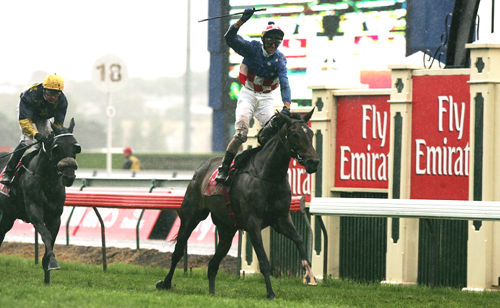
Trainer: Lee Freedman
Jockey: Glen Boss
Silks: Royal Blue, White Southern Cross, Red And White Checked Half And Checked Cap, Royal Blue Pom Pom

For Makybe Diva to win two Melbourne Cups, back-to-back, well and truly stamped this mare as a great stayer. In the intervening twelve months she added to her tally the Sydney Cup, ridden by Glen Boss. At the end of that racing season, trainer David Hall accepted with some reluctance an offer to train in Hong Kong. The mare was transferred to the stables of Lee Freedman who by now had three Melbourne Cups to his credit. Makybe Diva ran good seconds in the Feehan at Moonee Valley and in the Caulfield Cup before taking her second Melbourne Cup on a wet track in 2004, defeating the champion Irish horse, Vinnie Roe. Glen Boss was by now firmly entrenched as the regular jockey of Makybe Diva. It was a fourth Melbourne Cup win for trainer Lee Freedman.
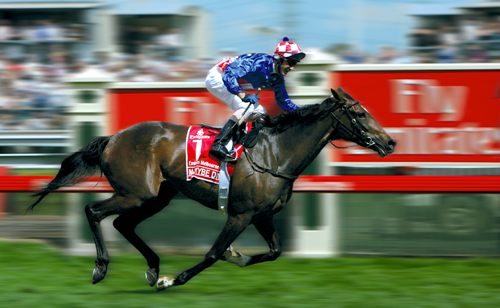
Trainer: Lee Freedman
Jockey: Glen Boss
Silks: Royal Blue, White Southern Cross, Red And White Checked Half And Checked Cap, Royal Blue Pom Pom

To have a dream run in one Cup is fortuitous. To get that same dream run a second year seems beyond luck. To boast a third Cup victory from another dream run is beyond belief. That is the story of Makybe Diva and Glen Boss winning Australia’s greatest horse race three years in a row. No horse, no jockey had done this before. Beside luck there was skill and courage. She carried a record weight for a mare to victory (58kg) and was brilliantly ridden by Boss with the expectation of the world on his own shoulders. Trainer Lee Freedman, scoring his fifth Melbourne Cup success, had also weathered the pressure of hopes and expectation. He was quoted as saying ‘Go and find the smallest child on this course because that will be the only person who lives long enough to see something like this again’. Makybe Diva’s win was as authoritative as her first and had the scribes searching for superlatives. ‘The best since Phar Lap’ was one of the cries from those who actually know something about horse racing. Everyone who attended Flemington that day will remember forever this special moment.
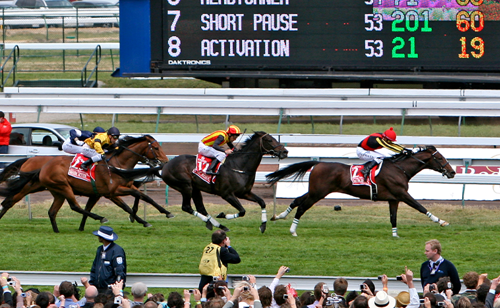
Trainer: Katsuhiko Sumii
Jockey: Yasunari Iwata
Silks: Black, Red Crossed Sashes, Yellow Striped Sleeves, Red Cap with Pom Pom

The internationalisation of the Melbourne Cup had another twist in 2006 when for the first time two Japanese-bred, owned and trained horses not only competed in the famous race but also filled the first two places, decided only in a photo finish. Both were trained by Katsuhiko Sumii and the winner was ridden by Japanese jockey Yasunari Iwata, while runner-up Pop Rock was ridden by Australian champion Damien Oliver. Both horses came to Australia with excellent form: Delta Blues had been placed as a 3YO in the Japan Cup before winning the Kikoko Sho, known as Japan’s St Leger. Ahead of his Melbourne Cup win, he finished third in the Caulfield Cup. Pop Rock went on to finish third in the 2007 Japan Cup. The pair outclassed the Melbourne Cup field on the day, with more than a four-length margin to the third placegetter, the Sydney trained Maybe Better.
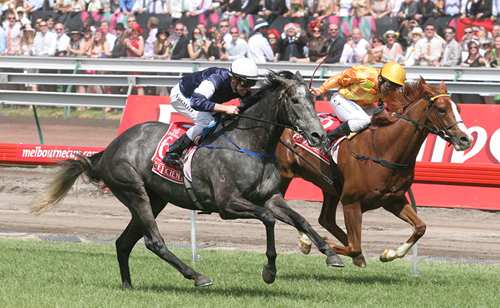
Trainer: Graeme Rogerson
Jockey: Michael Rodd
Silks: Navy Blue, White Armbands And Cap

Many champion thoroughbreds have won a Victoria Derby and a Melbourne Cup, some winning both as 3YOs, but no Derby winner had gone on to win the Cup since Delta who won the 1949 Derby and 1951 Cup. In 2006 Efficient won the Derby and the following year, as a paler shade of grey, he returned to win the Melbourne Cup. It was a vindication for managing part-owner Lloyd Williams, for whom another Cup had become a quest after his previous wins in 1981 and 1985. Former top New Zealand trainer Graeme Rogerson had been associated with earlier Cup winners, but this was his first as official trainer. Rogerson established himself in Australia in the 1990s. Efficient was purchased at the 2005 New Zealand yearling sales. He was a son of Zabeel (son of Sir Tristram) who also sired Melbourne Cup winner Might And Power (1997) and Jezzabeel (1998). Michael Rodd was 25 when he won the Cup, at his first ride in the race, but he had ridden Efficient when he won the Derby the previous year.
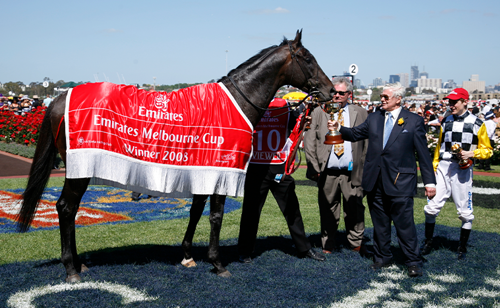
Trainer: J.B (Bart) Cummings
Jockey: Blake Shinn
Silks: Black, White Checks, Yellow Sleeves, Checked Cap

There had been narrow wins in past Melbourne Cups, but this year was close to a dead heat. With the Australian-bred Viewed getting the judge’s verdict, Bart Cummings secured his twelfth and final winner in Australia’s most coveted race, just days before his 81st birthday. Viewed had shown early promise with wins in Sydney and victory in the 2008 Brisbane Cup on a heavy track, but lost favour as a Melbourne Cup prospect after disappointing runs in the Caulfield Cup and Mackinnon. Nevertheless, Cummings’s achievement was greeted with acclaim by the crowd, and it was a fourth Cup win for owner Dato Tan Chin Nam. Blake Shinn, 21 at the time, was riding Viewed for only the second time. For the visiting English trainer, Luca Cumani, and local jockey, Corey Brown, it was the nearest of misses on Bauer.
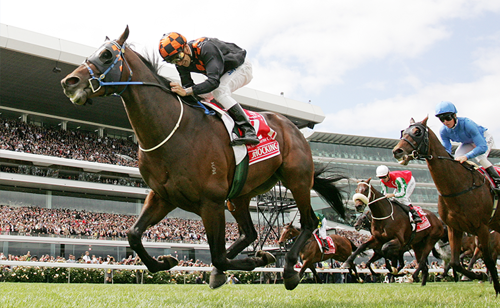
Trainer: Mark Kavanagh
Jockey: Corey Brown, Taree
Silks: Black, Orange Checked Sash And Cap

For the second year in a row, in the era when the Melbourne Cup had established itself as a truly international race, an Australian-bred stayer was the winner. Shocking earned his place after winning the Saab Quality (Hotham) three days earlier. After drawing barrier 21 in the Cup, jockey Corey Brown was trapped wide for much of the race. He held the horse together and, as the tempo of the race slackened, avoided traffic congestion nearer the fence. Reaching the famous Flemington clock tower, Brown took Shocking to the lead and held off the fast-finishing Godolphin-trained Crime Scene. Winning owner Lawrence Eales had selected Shocking at yearling sales in Adelaide because he had seen the sire Street Cry win the 2002 Dubai World Cup. The win was a triumph for trainer Mark Kavanagh, a former jumps jockey from Mt Gambier. And sweet victory for Corey Brown who had lost narrowly the previous year.
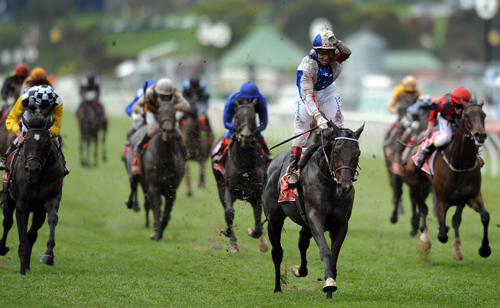
Trainer: Alain de Royer-Dupré, France
Jockey: Gérald Mossé, France
Silks: White, Royal Blue Stripe With White Stars, Red, White And Royal Blue Striped Sleeves And Cap

There was much anticipation ahead of the 150th running of the Melbourne Cup, with the Melbourne Cup trophy touring internationally as well as around Australia and New Zealand in the build-up to the race. And it was a truly international result, with the US-bred Americain, with his French trainer and jockey, carrying the day after earlier successes in Grade 2 races in France. For Gérald Mossé, based in Hong Kong, this was his first ride in a Melbourne Cup. Ridden patiently, Americain sat well off the pace throughout the race. Mossé waited to call on his best effort from his mount, swamping the star-studded field in the closing stages. Maluckyday finished second. Dual Cox Plate winner So You Think, trained by Bart Cummings, hit the front near the winning post before finishing third. It was his last Australian start before being sold to race with further success in England and Ireland under Aidan O’Brien.
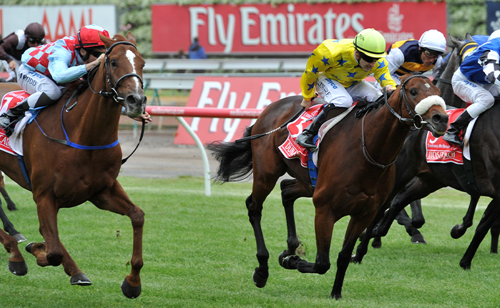
Trainer: Mikel Delzangles
Jockey: Christophe Lemaire
Silks: Yellow And Royal Blue Stars, Yellow Cap

For the second successive year it was essentially a French Melbourne Cup. The Melbourne Cup winner followed exactly the same path to Flemington as the previous winner, Americain. This included victory in the Geelong Cup thirteen days before the Cup. French trainer Mikel Delzangles explained, ‘I used to work for Alain de Royer-Dupré, so when he won with Americain the year before, I thought he knows what he is doing, so took the same path’. The horse’s Qatari owner, Sheikh Fahad bin Abdullah Al Thani, was 21 when he won the Cup. As with Gérald Mossé the year earlier, French jockey Christophe Lemaire had not ridden at Flemington before, but he walked the track on the morning of the race with 1999 winning jockey, John Marshall. The result of the race was a photo finish as tight as in 2008, Dunaden defeating Red Cadeaux who twice again would be runner-up in a Melbourne Cup.
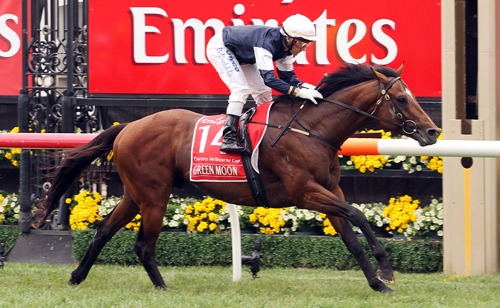
Trainer: Robert Hickmott
Jockey: Brett Prebble
Silks: Navy Blue, White Armbands And Cap

Green Moon became the fourth Melbourne Cup winner for leviathan owner, Lloyd Williams. Irish-bred, the horse had first raced in England and, under trainer Harry Dunlop, won the Fairway Stakes at Newmarket. He was then sold privately to Williams’s ownership group and was trained at Macedon, Victoria under Robert Hickmott who had previously assisted with the training of 2007 winner, Efficient. After a win in the 2011 Newcastle (NSW) Gold Cup and a second in the Caulfield Cup, Green Moon returned in excellent form in 2012 with wins in weight-for-age Group 1 races but disappointed in the Cox Plate ten days before the Cup. Victorian jockey, Brett Prebble, who had been riding successfully in Hong Kong, now took the ride, and won convincingly over Fiorente, who won the Melbourne Cup following year.
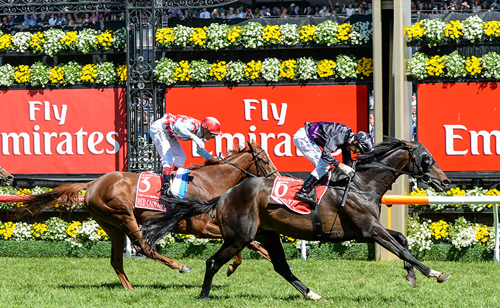
Trainer: Gai Waterhouse
Jockey: Damien Oliver
Silks: Black, Purple Sash

Sydney trainer Gai Waterhouse had come so close to winning a Melbourne Cup early in her career, with runners-up Te Akau Nick (1993), Nothin’ Leica Dane (1995) and Fiorente (2012). By now she was famous in her own right, winning her first Sydney trainers’ premiership in season 1996–97, no longer in the shadow of her famous father, trainer T.J. Smith. Now, Gai broke through with the Irish-bred Fiorente who had won the 2012 Princes of Wales’s Stakes at Newmarket when trained by Sir Michael Stoute. The colt was sold privately for a large sum and sent to Australia for Gai Waterhouse to train. His 2012 Cup performance was excellent, and in 2013 he went one better after a good third in the Cox Plate. For the second time, Red Cadeaux was runner-up. This was the third Cup victory for champion jockey, Damien Oliver, by now 41. Fiorente went on to win the 2014 Australian Cup before being retired to the stud.
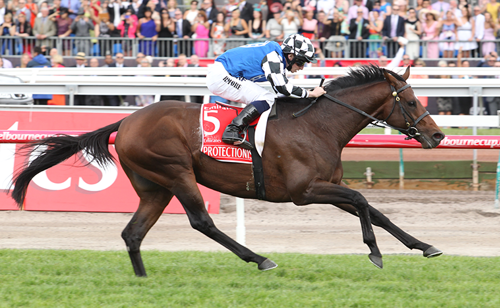
Trainer: Andreas Wöhler
Jockey: Ryan Moore
Silks: Royal Blue, White Horseshoe, Black And White Checked Sleeves And Cap

The Melbourne Cup as an international race took another step with the win of Protectionist in 2014. Like the previous winner, the Irish-bred Fiorente, Protectionist was a son of the German sire Monsun. He was initially owned and trained in Germany. His win in the 2014 Prix Kergorlay at Deauville, France suggested a pathway to the Melbourne Cup, as Americain had won the race in 2010. He was sold to a syndicate, Australian Bloodstock, with Wöhler retained for the Cup campaign. English jockey Ryan Moore had already been three times the British flat racing champion jockey, with wins in the English Derby, Oaks, 1000 Guineas, Prix de l’Arc de Triomphe and Japan Cup to his credit, but he had never ridden in Australia before winning the 2014 Cup. Red Cadeaux for the third time ran second. Protectionist had one run in Australia ahead of the Cup. After his victory he remained in Australia, but without further track success, before returning to Germany for a stud career.
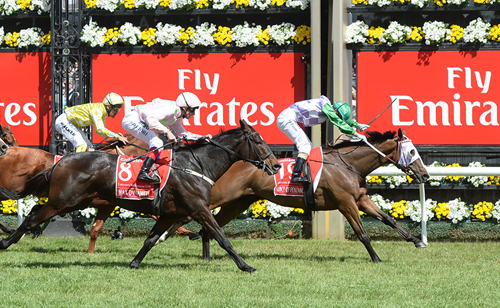
Trainer: Darren Weir
Jockey: Michelle Payne
Silks: White And Mauve Checks, Emerald Green Sleeves And Cap

The story this time was the jockey. Michelle Payne became the first female jockey to win the Melbourne Cup. Her mount, Prince of Penzance, was a rank outsider despite fair recent form and a win in the previous year’s Moonee Valley Cup. His odds in the 2015 Melbourne Cup were 100/1 but he and his jockey were cheered back to scale. Michelle was 30 when she won the Cup, an accomplished rider from a family of jockeys and trainers, and she had overcome injuries and prejudice against female jockeys to win this race. New Zealand-bred Prince of Penzance was trained in Victoria by Darren Weir, the high point of his career. The story was made into the movie, ‘Ride Like a Girl’, directed by Rachel Griffiths. It recreates Payne’s brilliant ride, where she beat French-bred Max Dynamite, ridden by superstar Frankie Dettori, to the post. It also included her pithy advice to all who doubted the capacity of women jockeys to win big races to ‘get stuffed’.
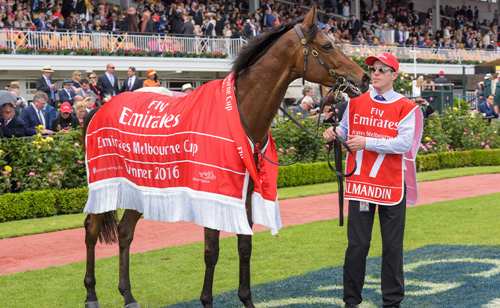
Trainer: Robert Hickmott
Jockey: Kerrin McEvoy
Silks: Navy Blue, White Armbands, Red Cap

The German-bred Almandin won the 2014 Grade 2 Grosser Preis der Badischen Unternehmer at Baden Baden beating Protectionist, which was sufficient recommendation for Lloyd Williams and partners to acquire the horse and aim for another Melbourne Cup. The sire, Monsun, had also sired Protectionist and the 2013 Cup winner, Fiorente. Almandin had been trained in Europe by Jean-Pierre Carvalho. In Australia he was put under the care of Robert Hickmott who had trained Green Moon for his 2012 Cup win, and he soon showed his form with wins in the Harry White Classic at Caulfield and then the Bart Cummings Quality Handicap which put him into the Melbourne Cup automatically. Jockey Kerrin McEvoy, who first won the Cup in 2000, had been enjoying international success, and he took the ride. It was a tight finish. Almandin outgunned the Irish horse Heartbreak City, ridden by international star Joe Moreira.
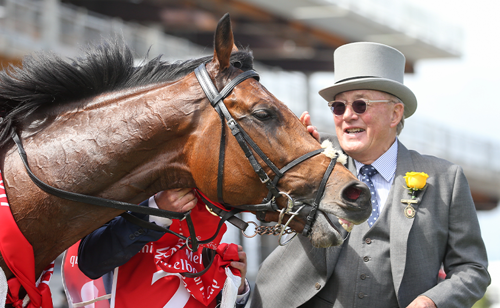
Trainer: Joseph O’Brien
Jockey: Corey Brown
Silks: Navy Blue, White Armbands, Pink Cap

Winning the Melbourne Cup has been something on Lloyd Williams’s agenda from an early age—and, unashamedly, targeted with a passion. Williams is an owner who makes no secret of the race he wants to win most, the Melbourne Cup. Almandin, the previous year, had given him his fourth winner in the race. Rekindling was sent out to Australia after running poorly in the English Derby some five months earlier. He then won the Curragh Cup, ran second in the Irish St Leger Trial and fourth in the Grade 1 English St Leger in the lead up. The young trainer, Joseph O’Brien, 24 at the time, a former Irish champion jockey, is a son of the renowned Irish trainer Aidan O’Brien. Rekindling remained in his charge for his run in the Melbourne Cup. Rekindling was still a 3YO by northern hemisphere reckoning but was deemed a 4YO in Australia when he won the Cup. It was Corey Brown’s second Cup win. Runner-up Johannes Vermeer was also owned by the Williams partnership.
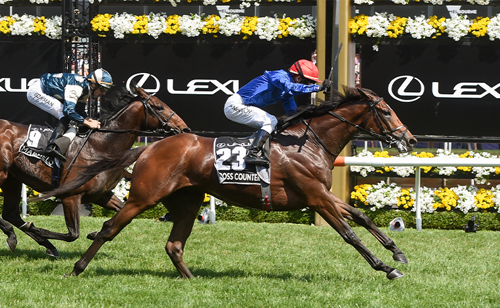
Trainer: Charlie Appleby
Jockey: Kerrin McEvoy
Silks: Royal Blue, Red Cap

Lexus became sponsor of the Melbourne Cup from 2018. Cross Counter became the second northern hemisphere-bred 3YO in as many years to win the Cup. When racing in Australia in November, technically Cross Counter was deemed a 4YO. The internationally powerful Godolphin stable of Sheik Mohammed bin Rashid Al Maktoum had made several attempts to win the Melbourne Cup and had come close with placegetters in the past. This time they achieved success when Newmarket (UK) trainer Charlie Appleby brought Cross Counter to Melbourne for the race after a good second in the time-honoured Great Voltigeur Stakes at York. In the Cup, Cross Counter sat off the pace throughout before unleashing a blistering run over the concluding stages. South Australian-born international jockey Kerrin McEvoy won his third Melbourne Cup. Cross Counter went on to win the 2019 Dubai Gold Cup.
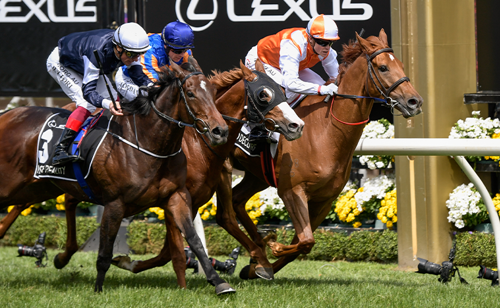
Trainer: Danny O’Brien
Jockey: Craig Williams
Silks: Orange, White Epaulettes And Sleeves, Quartered Cap

After internationally bred and trained horses had won many of the recent Cups, it was the Queensland-bred Vow And Declare who won the race in 2019. In a thrilling finish, Vow And Declare pushed through on the inside along the fence, getting up by the margin of a head. Second horse past the post, Master Of Reality, was then relegated to fourth place after a complicated protest by stewards on behalf of fourth placegetter, Il Paradiso, which promoted Prince of Arran to second place. This scenario had never happened before in Cup history. One year earlier, Vow And Declare had won a Listed race at Flemington at the Melbourne Cup carnival. Now, after a second in the 2019 Caulfield Cup, he won the big race itself. It was a first Melbourne Cup for local trainer Danny O’Brien and for popular Melbourne jockey Craig Williams, 42 at the time.
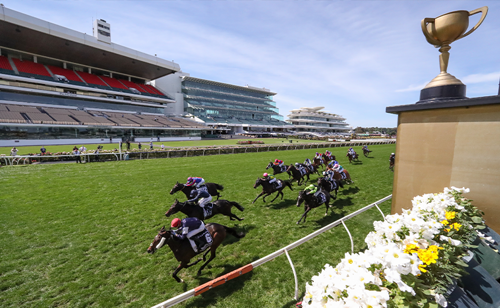
Trainer: Joseph O’Brien
Jockey: Jye McNeil
Silks: Navy Blue, White Armbands, Red Cap

Nothing like this had ever happened in Melbourne Cup history. The race went ahead as usual on the First Tuesday in November, overseas horses were part of the field, but because of the COVID-19 pandemic restrictions, no-one was allowed on course except officials, trainers, jockeys, and stable hands—and the horses. Twilight Payment had first raced with success in England and Ireland, trained by Jim Bolger, before being sold to Lloyd Williams and transferred to Joseph O’Brien. He ran unplaced in the 2019 Melbourne Cup, then returned to race in Ireland where he won twice the following year, including the Curragh Cup. Back to Flemington just for the Melbourne Cup, Twilight Payment was ridden for the first time by young local jockey, Jye McNeil who led almost all the way. It was a record seventh Melbourne Cup for Lloyd Williams as part-owner. There was strange silence at the finish, but it was still Cup magic, shared electronically around the world. The runner-up, Tiger Moth, was trained by Joseph O’Brien’s father, Aidan.
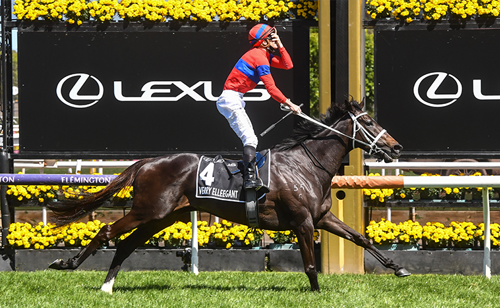
Trainer: Chris Waller
Jockey: James McDonald
Silks: Red, Royal Blue Band, Armbands And Band On Cap

Trainer Chris Waller became a household name through the triumphs of the great mare Winx whose 37 wins included four Cox Plates. Winx was a middle-distance champion who never raced over the 3200 metre distance of a Melbourne Cup, but Waller was at last able to win the Cup in 2021 with another world-class champion mare, the curiously-spelt Verry Elleegant. Like Waller himself, she had been born and raised in New Zealand before coming to Australia. Her early wins at three years included the Group 1 Australian Oaks at Randwick and the Vinery Stud Stakes at Rosehill. In 2020 she won four Group 1 races in Sydney and Melbourne, including the Caulfield Cup. In 2021 there were four more, culminating in the Melbourne Cup. In perfect race conditions at Flemington, only 10,000 people were allowed on course, under COVID-19 restrictions, to see one of the best mares of the past 50 years win the 161st running of the Melbourne Cup. World-class winning jockey, James McDonald, Sydney based, was also originally from New Zealand.
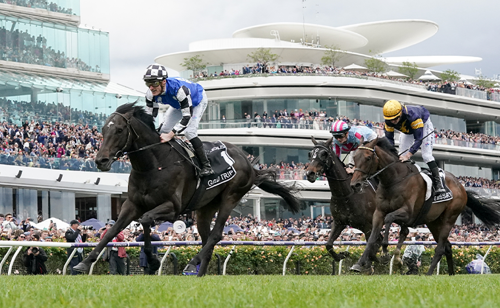
Trainer: Ciaron Maher & David Eustace
Jockey: Mark Zahra
Silks: Royal Blue, White Horseshoe, Black And White Checked Sleeves And Cap

Gold Trip was bred and first raced in France before coming to Australia with the 2022 Melbourne Cup in mind. Trained originally by Fabrice Chappet at Chantilly, he won the Grade 2 Prix Greffulhe and was second in the Prix Ganay at Longchamp. Acquired by Australian Bloodstock who were also part of the ownership of 2014 Melbourne Cup winner, Protectionist, Gold Trip came to Victoria to be part of the powerful Maher–Eustace training partnership. An impressive second in the 2022 Caulfield Cup and an unlucky unplaced run set him up for victory as topweight in the Melbourne Cup. It was the first Cup win for Mark Zahra and it set the jockey up for a brilliant run of success over the following year and beyond. Gold Trip returned to form with a win in the Group 1 Turnbull Stakes and a third in the 2023 Caulfield Cup but finished unplaced in the subsequent Melbourne Cup.
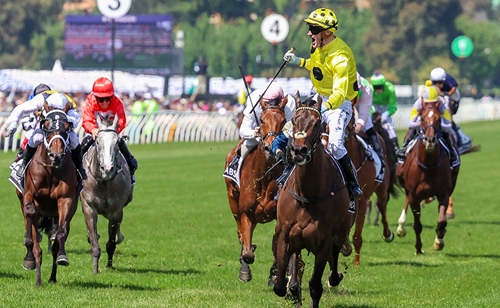
Trainer: Anthony & Sam Freedman
Jockey: Mark Zahra
Silks: Yellow, Black Spots Sash And Cap

In winning the 2023 Lexus Melbourne Cup, the Irish-bred Without A Fight became the 12th horse to win the Caulfield–Melbourne Cups double. And despite a one kilogram penalty from winning the Caulfield Cup, Without A Fight looked a winner as the field headed into the home straight. It was back-to-back victories for jockey Mark Zahra. For the father-son training partnership it was a first victory but a sixth for the immediate family. Anthony Freedman’s brother Lee had been official trainer of five Melbourne Cup winners, but the brothers were part of his team. Add three more Melbourne Cup wins by great-grandfather jockey W.H. McLachlan (1909, 1910, 1917), and that comes to nine for the family. For Anthony’s son Sam, that is a five-generation dynasty. Without A Fight was bred and owned by Sheikh Mohammed Obaid Al Maktoum. He raced first in Britain for trainers Simon and Ed Crisford before being sent to the Australia for a first-up run, unplaced, in the 2022 Melbourne Cup. A change of trainers and time to acclimatise worked wonders. Four wins in five starts culminated in his triumph in the Melbourne Cup.
To explore the history of the Victoria Racing Club's Chairman, Secretary, and CEOs click here.
CONTENT CREDIT: Dr Andrew Lemon AM FRHSV, VRC Consultant Historian and Joe McGrath, VRC Keeper of the Cup.

